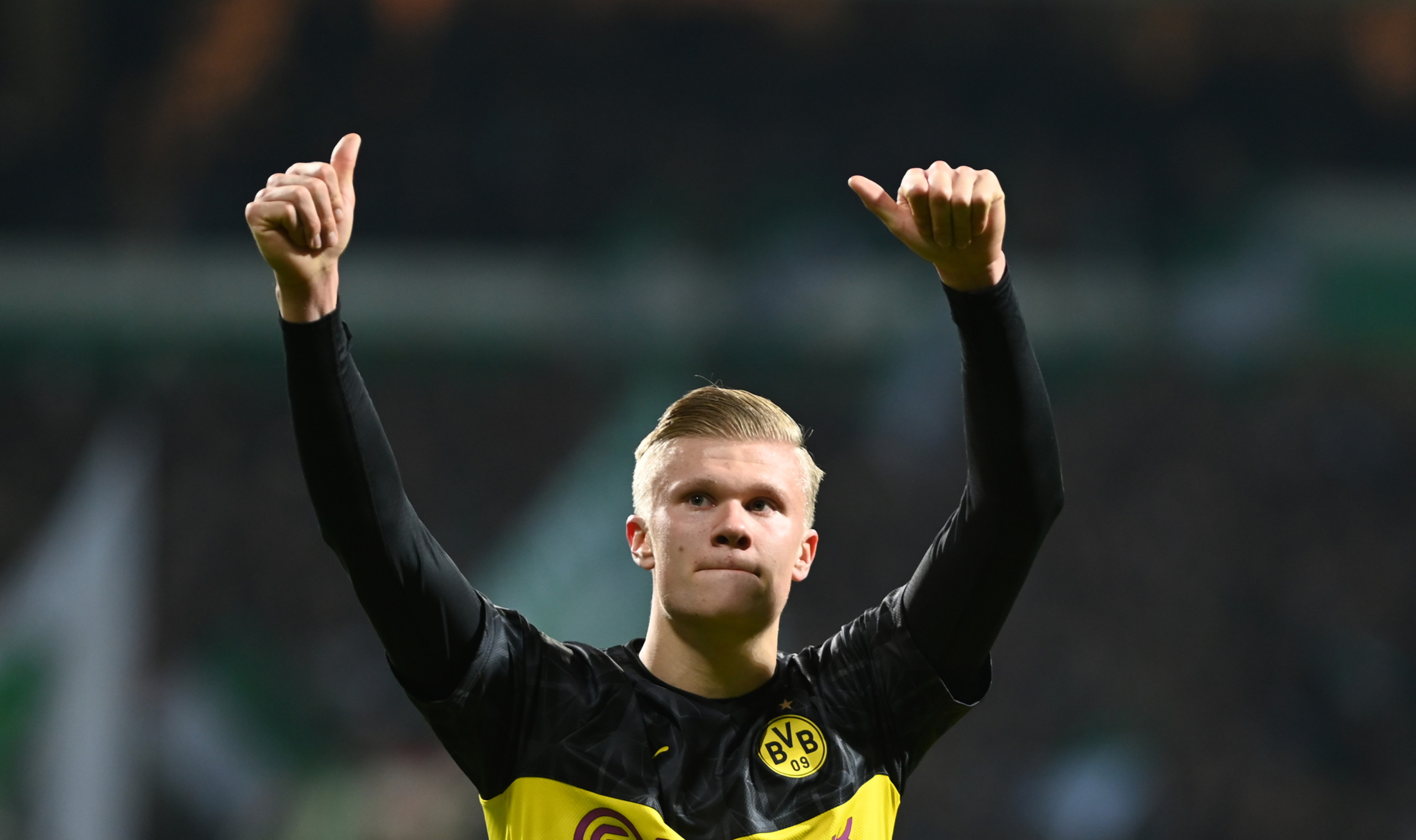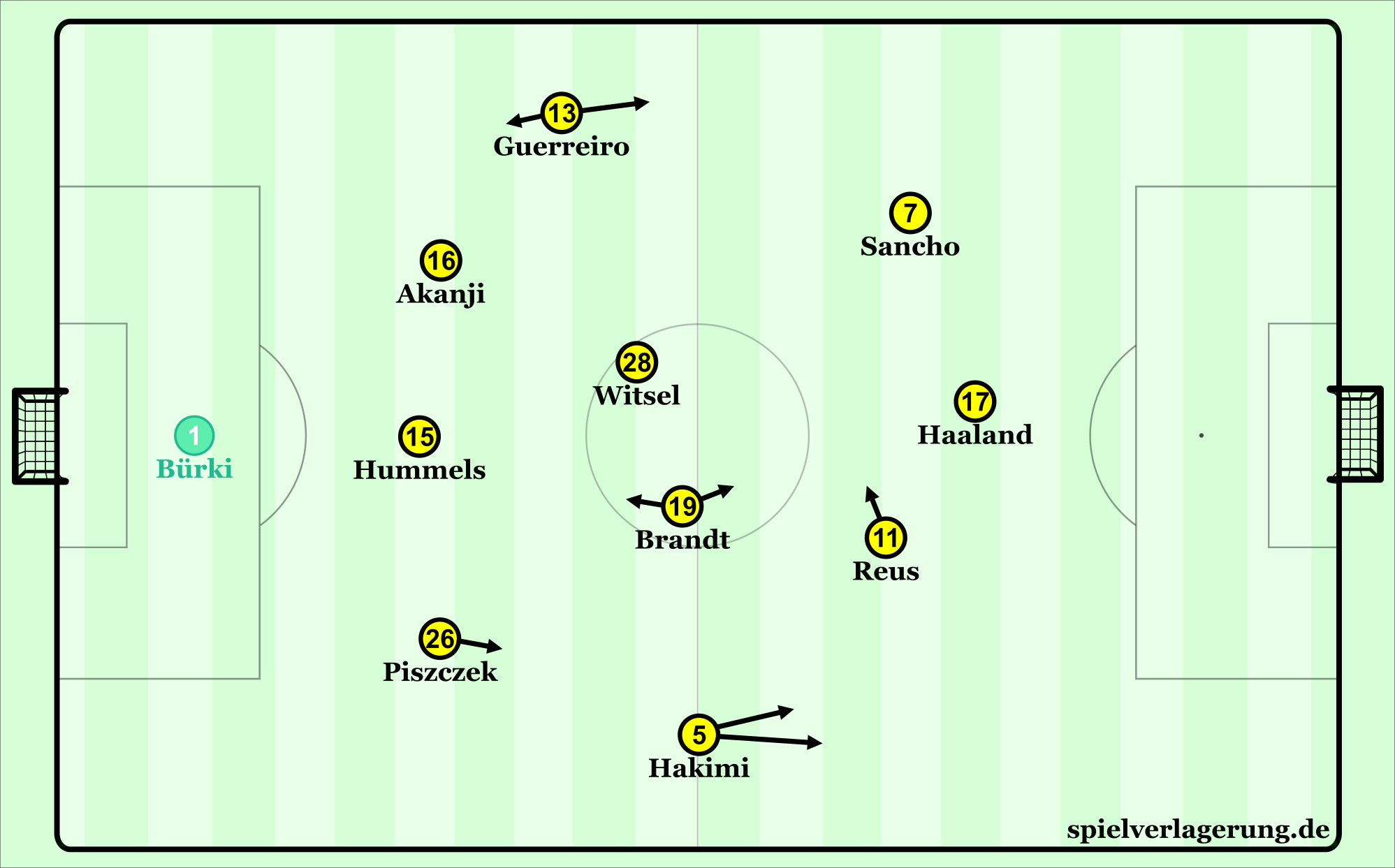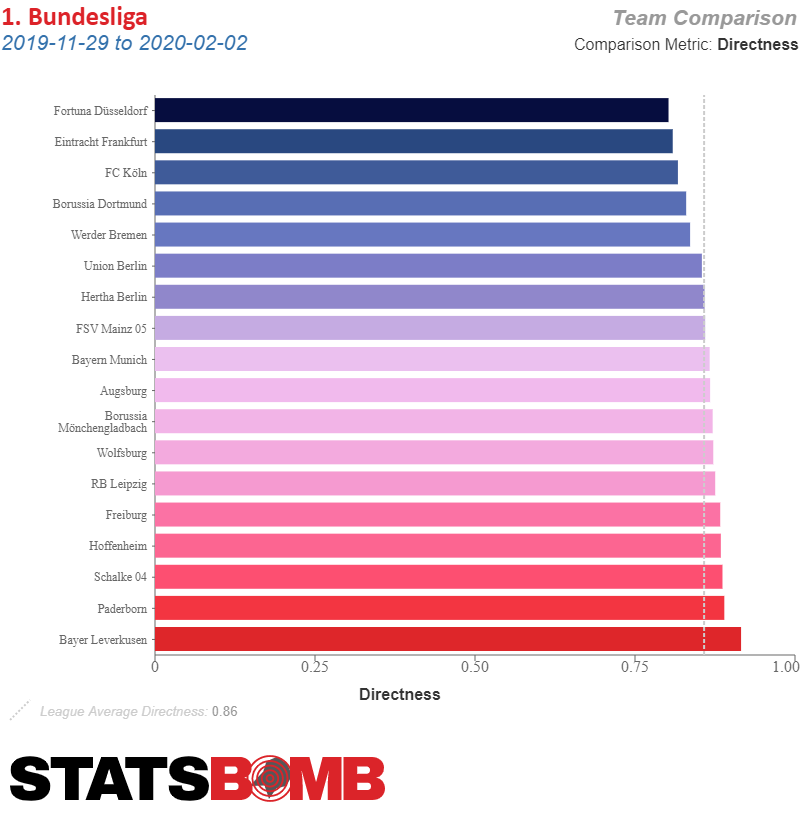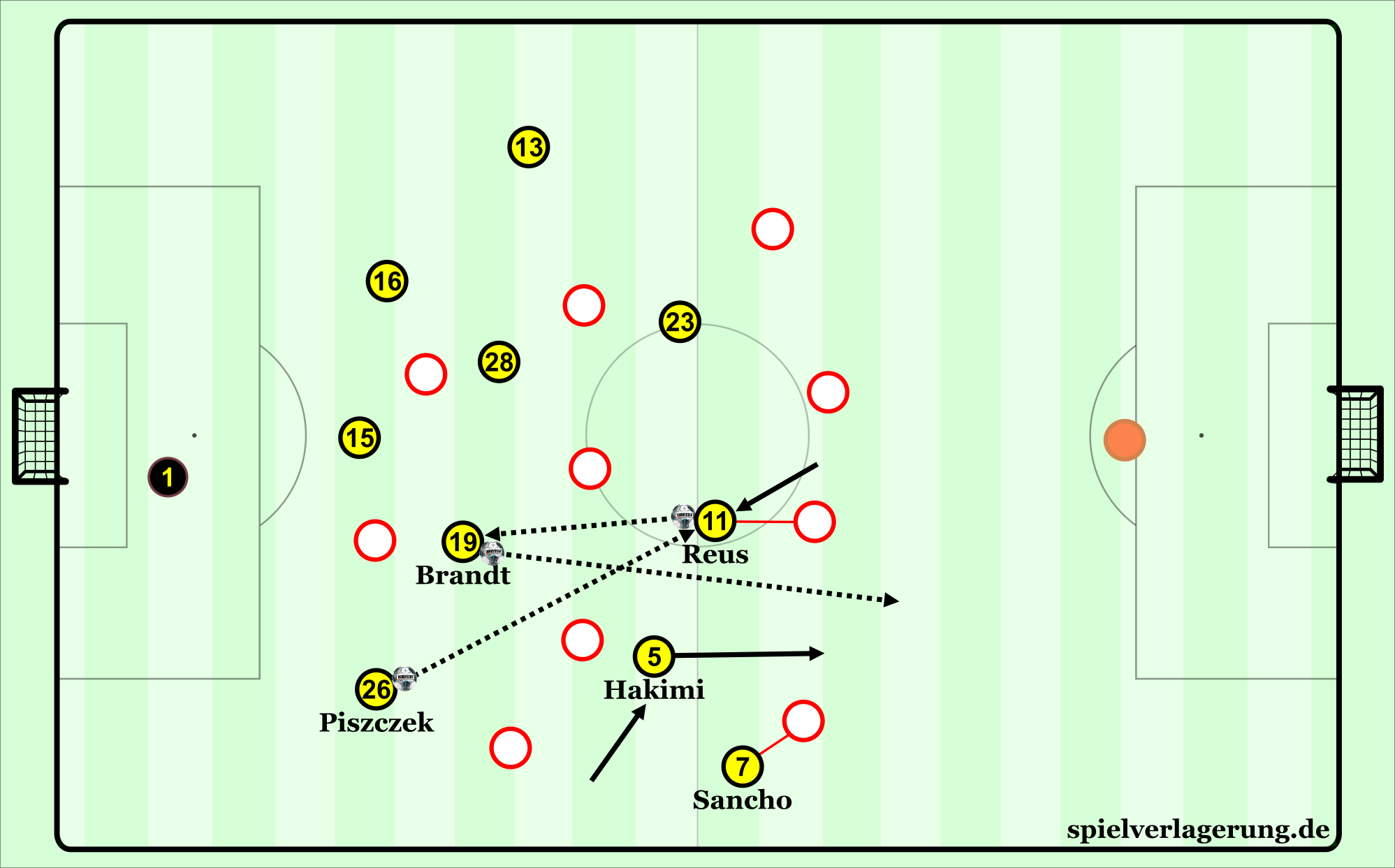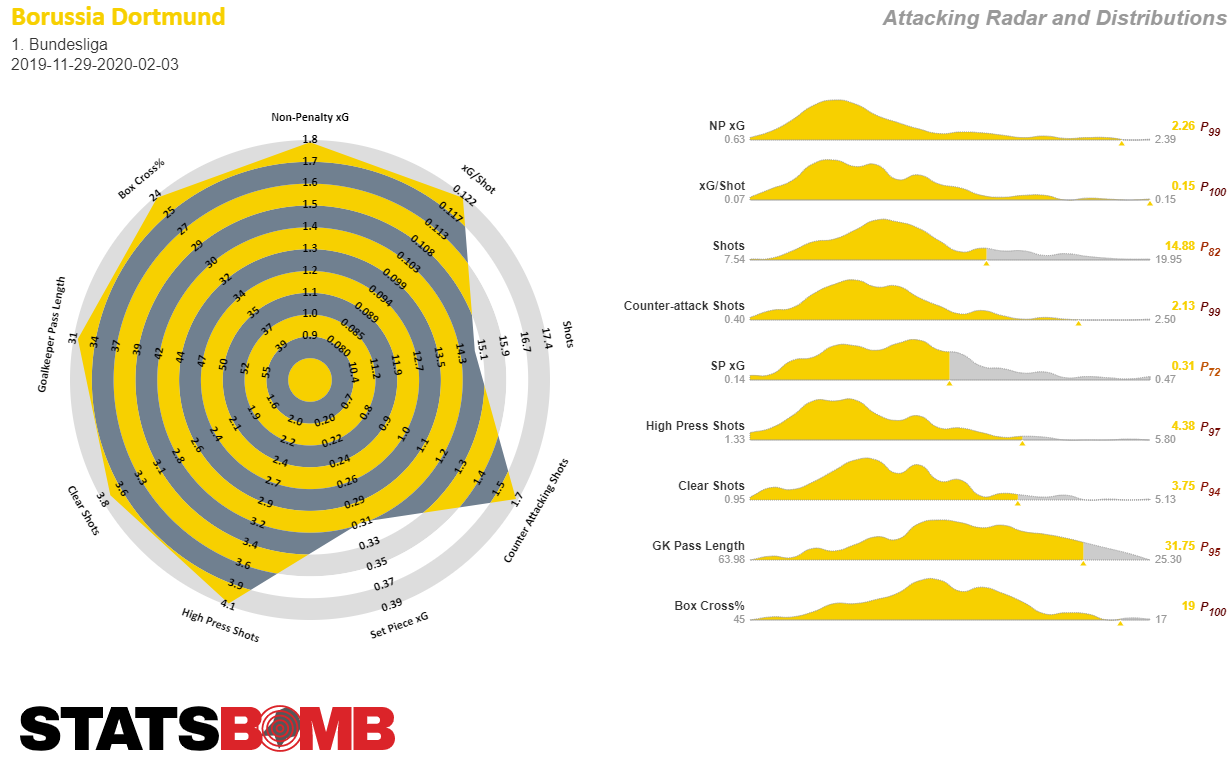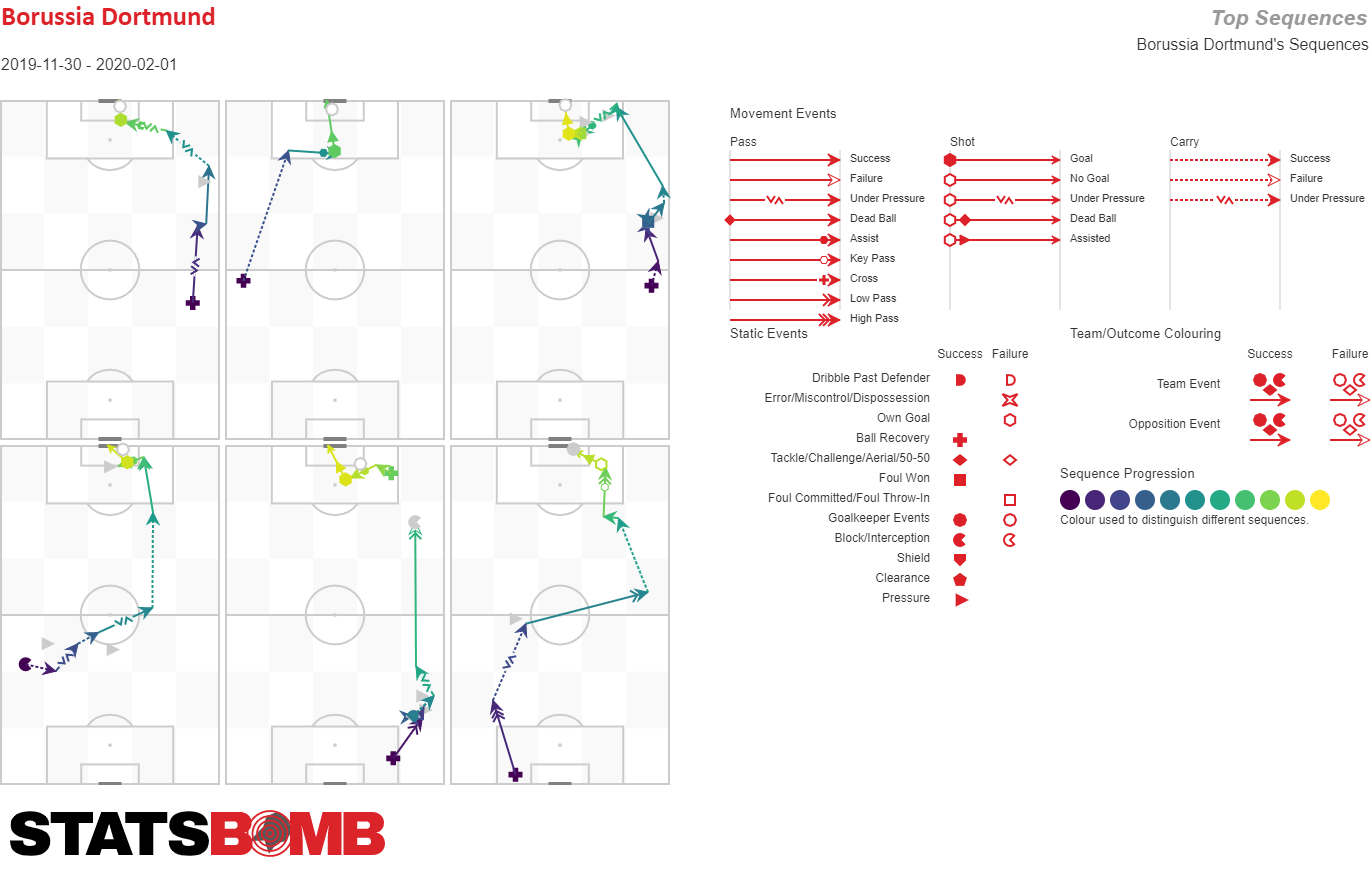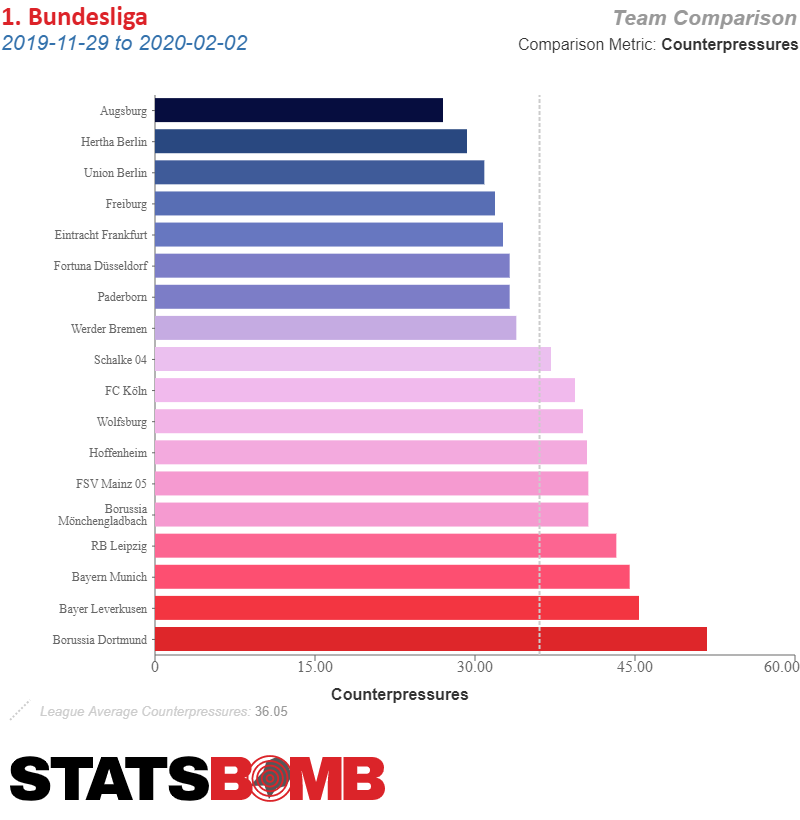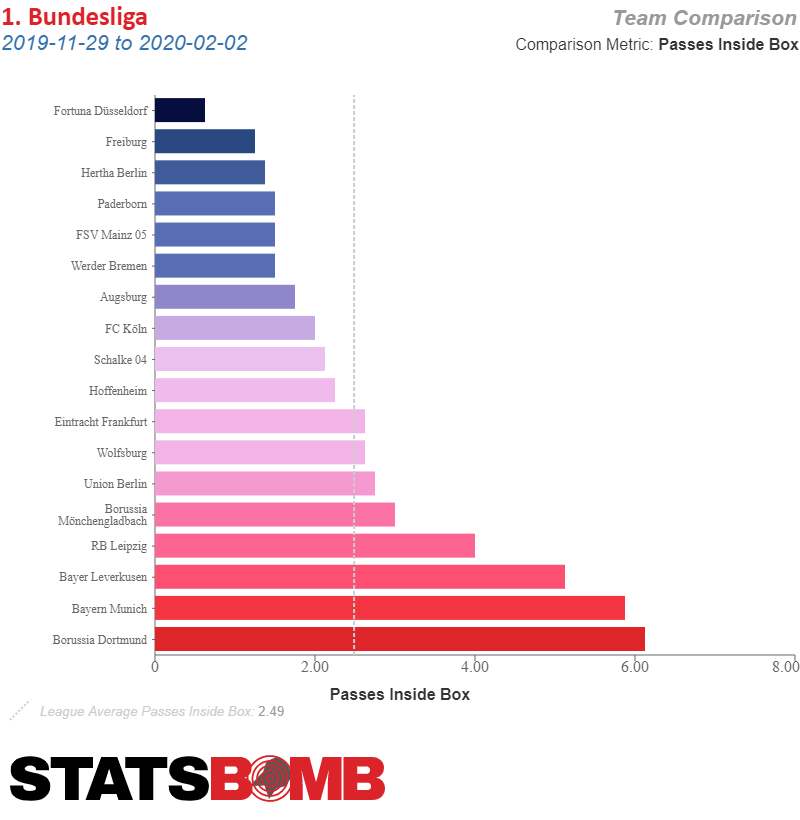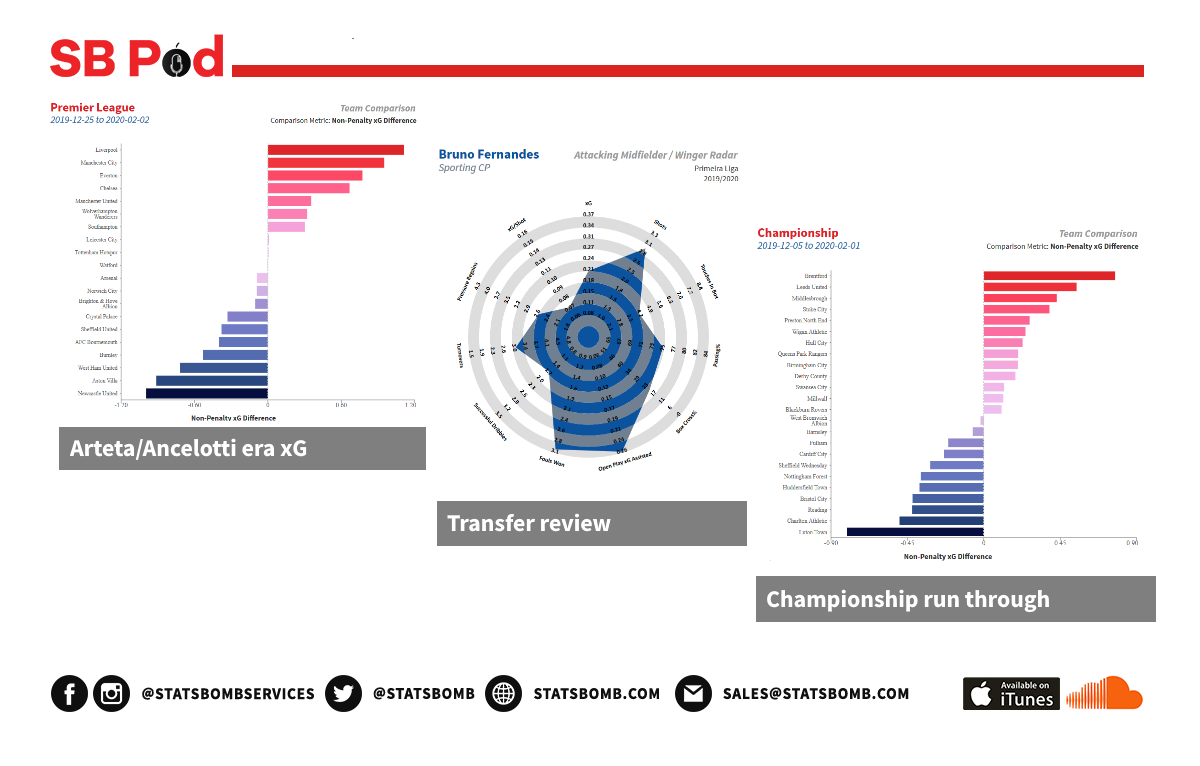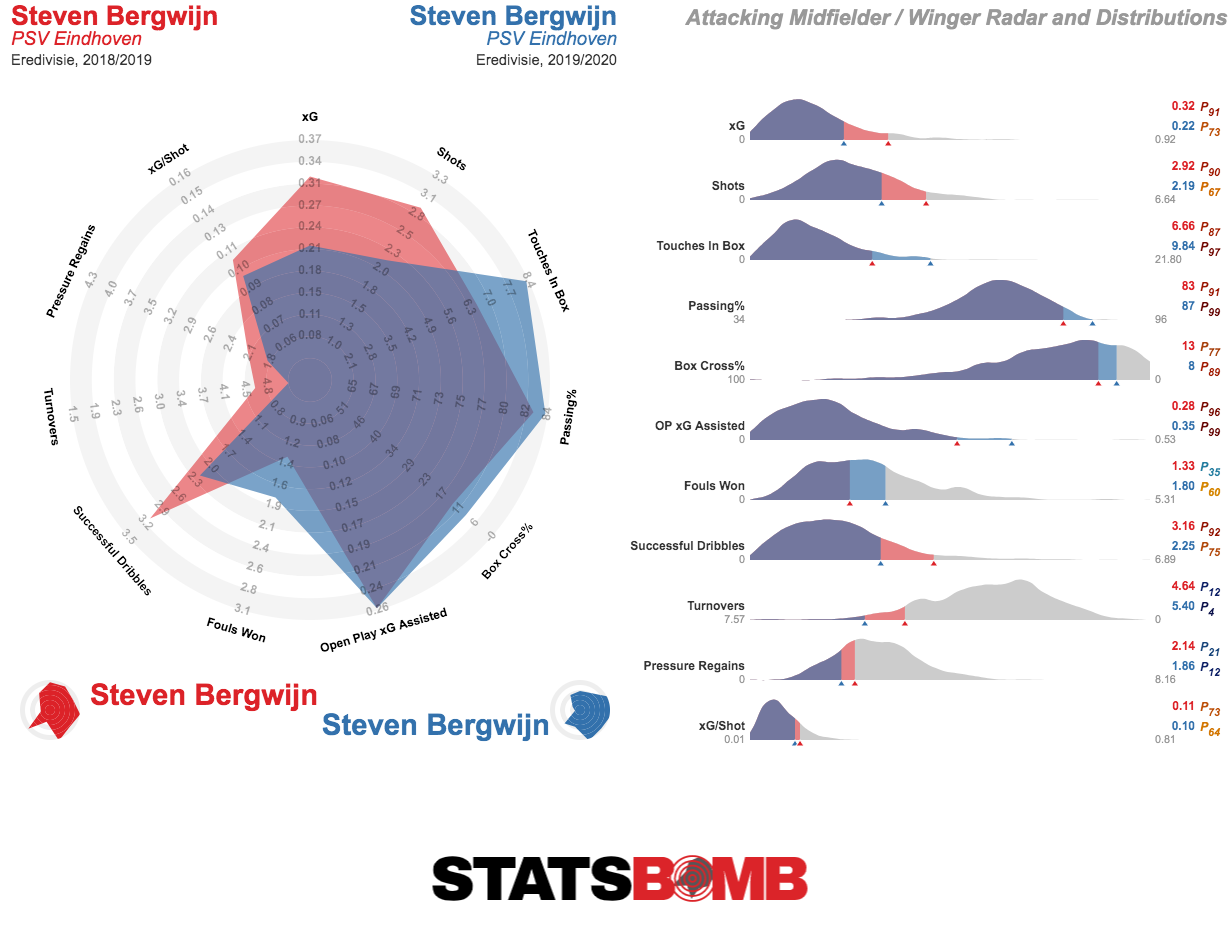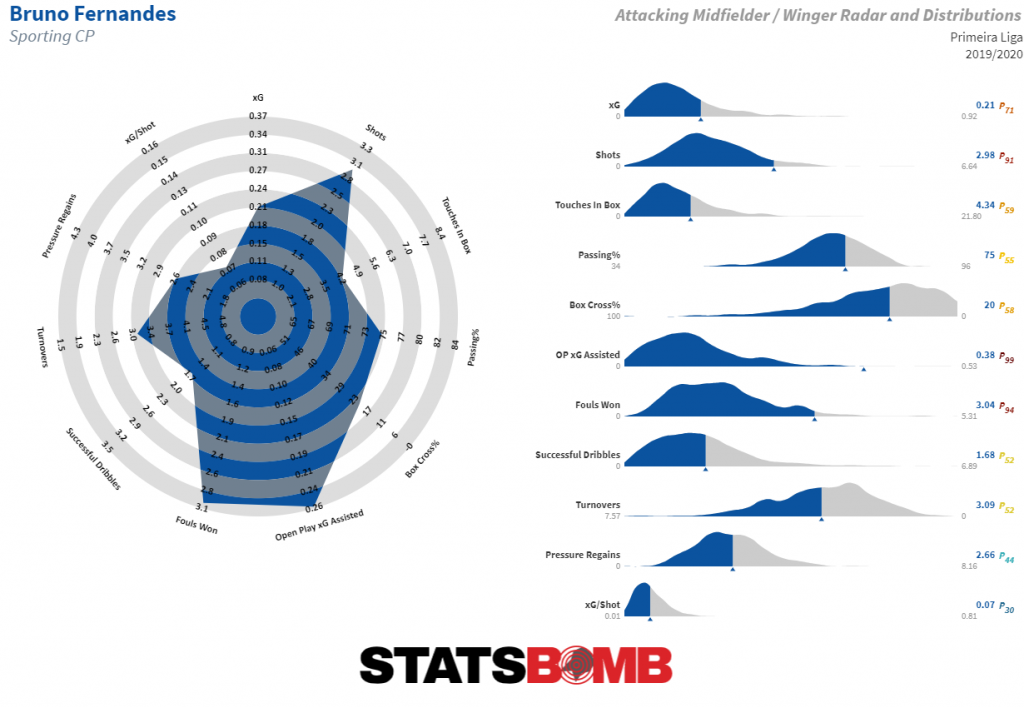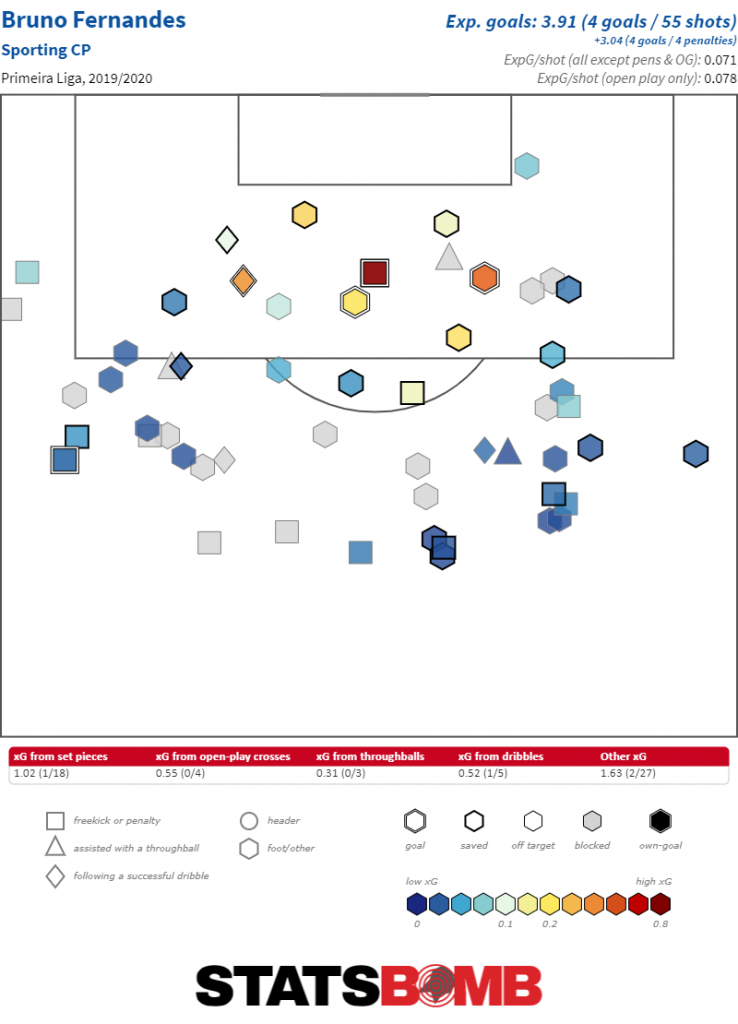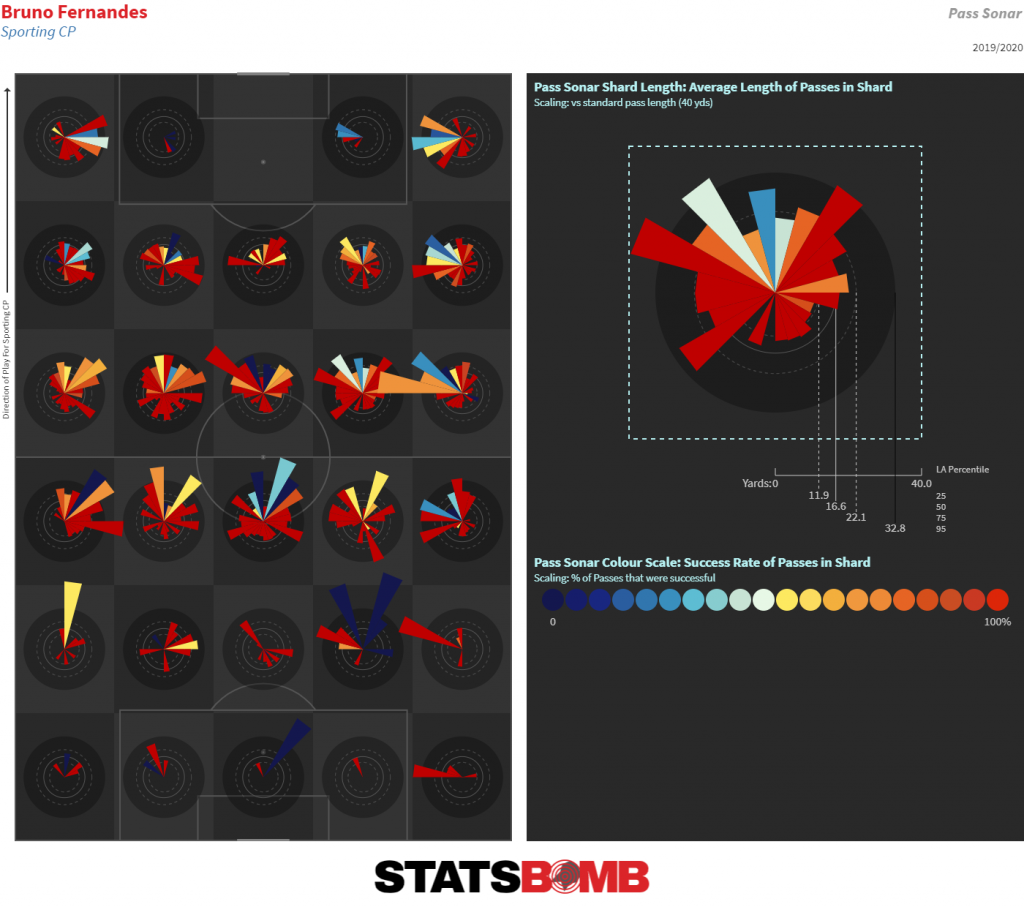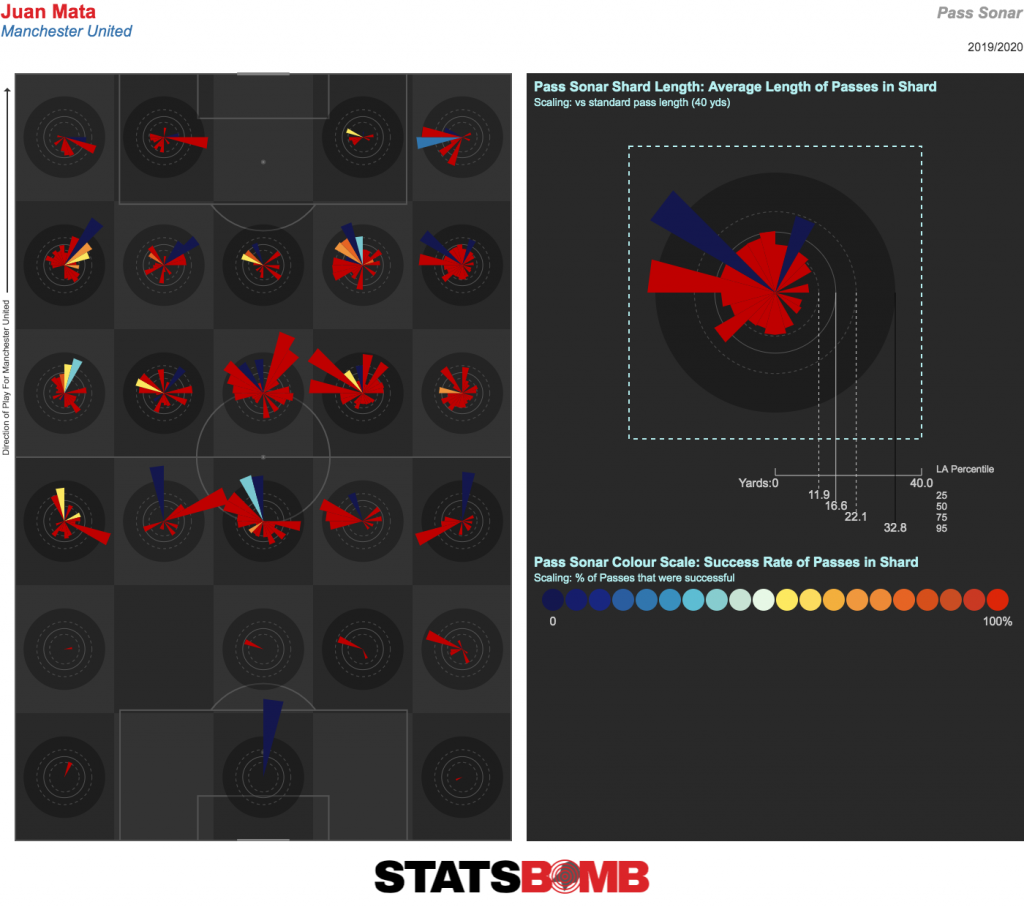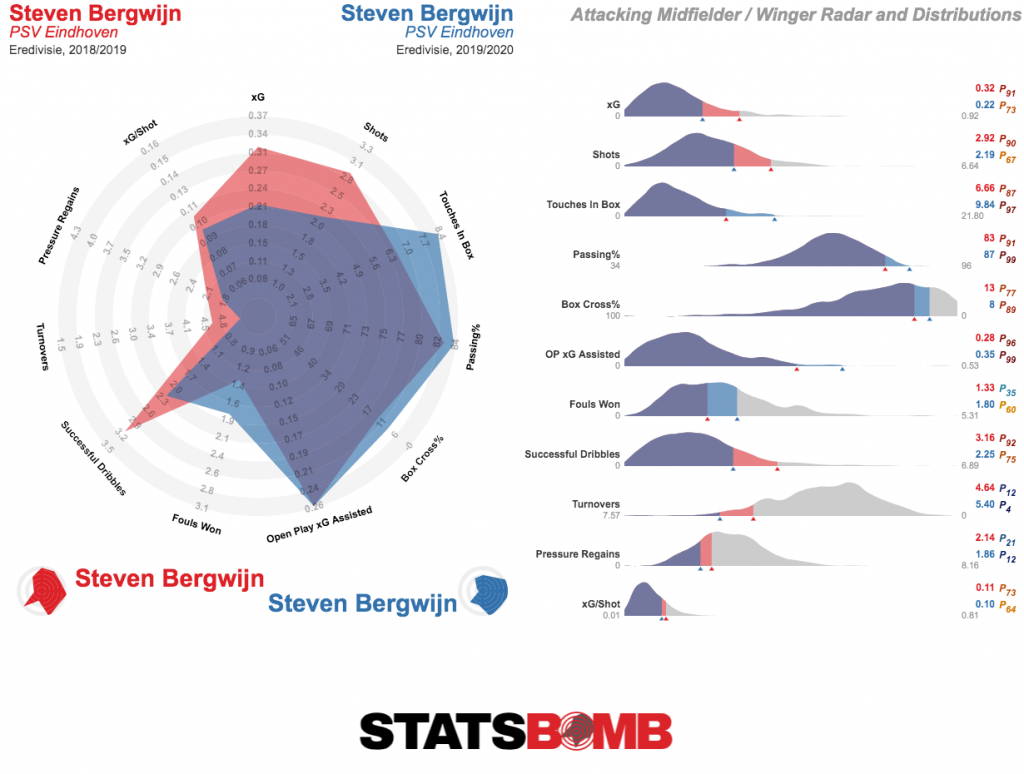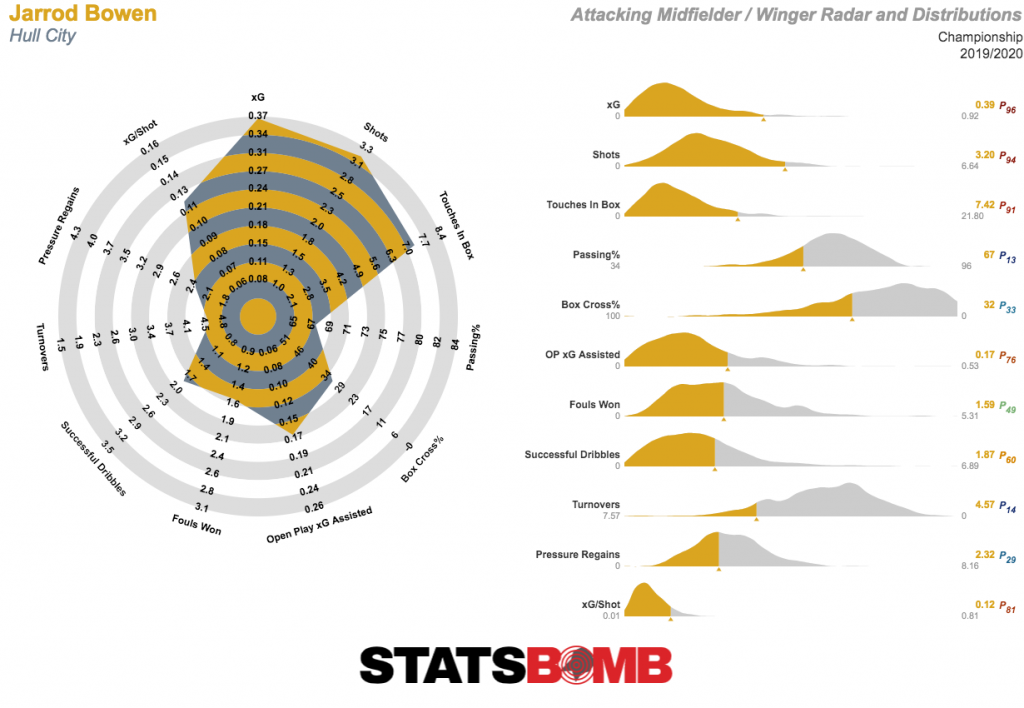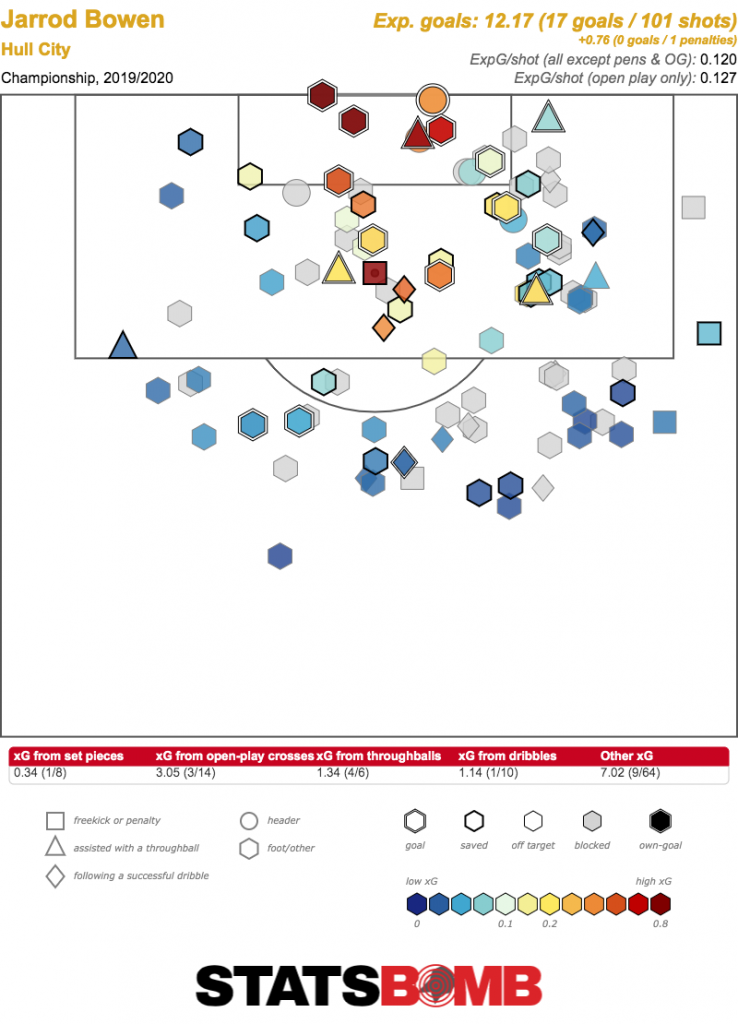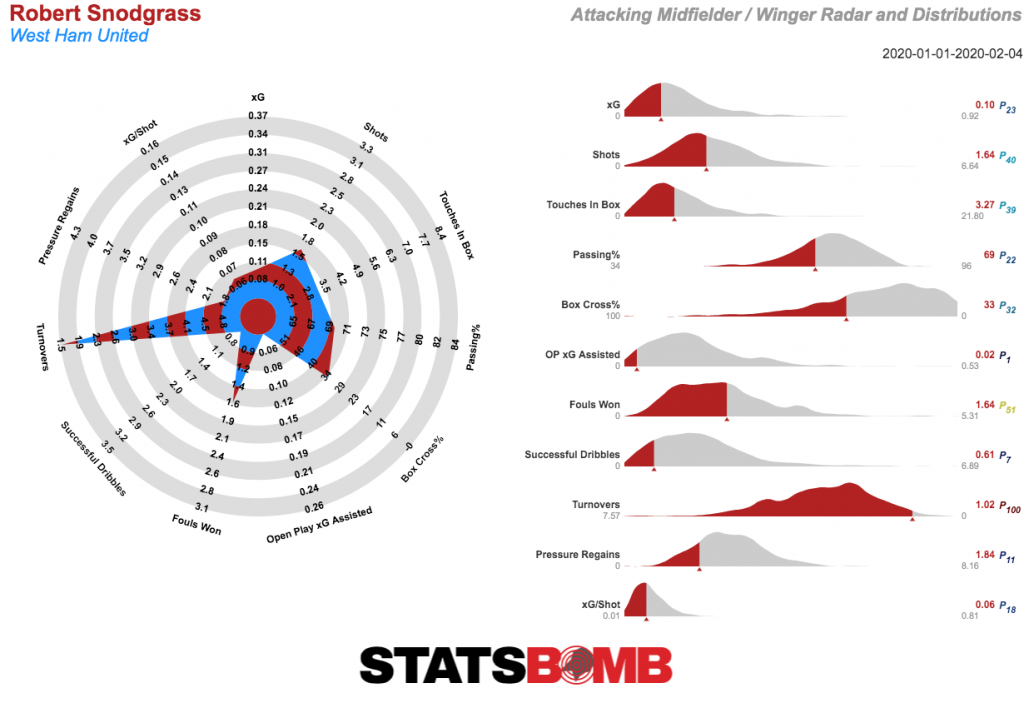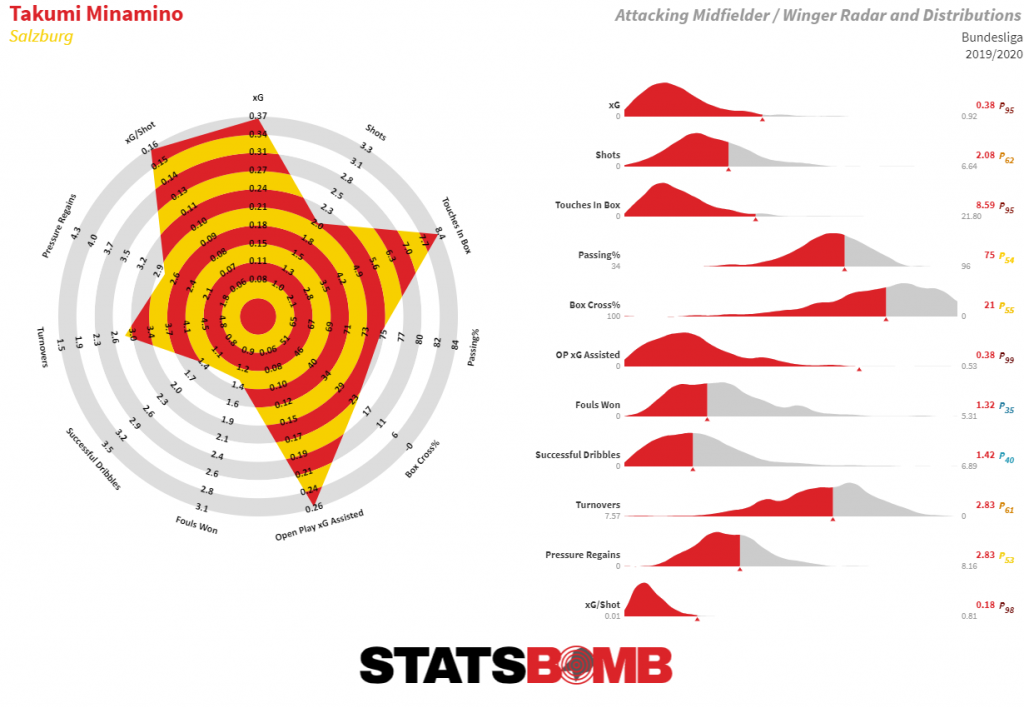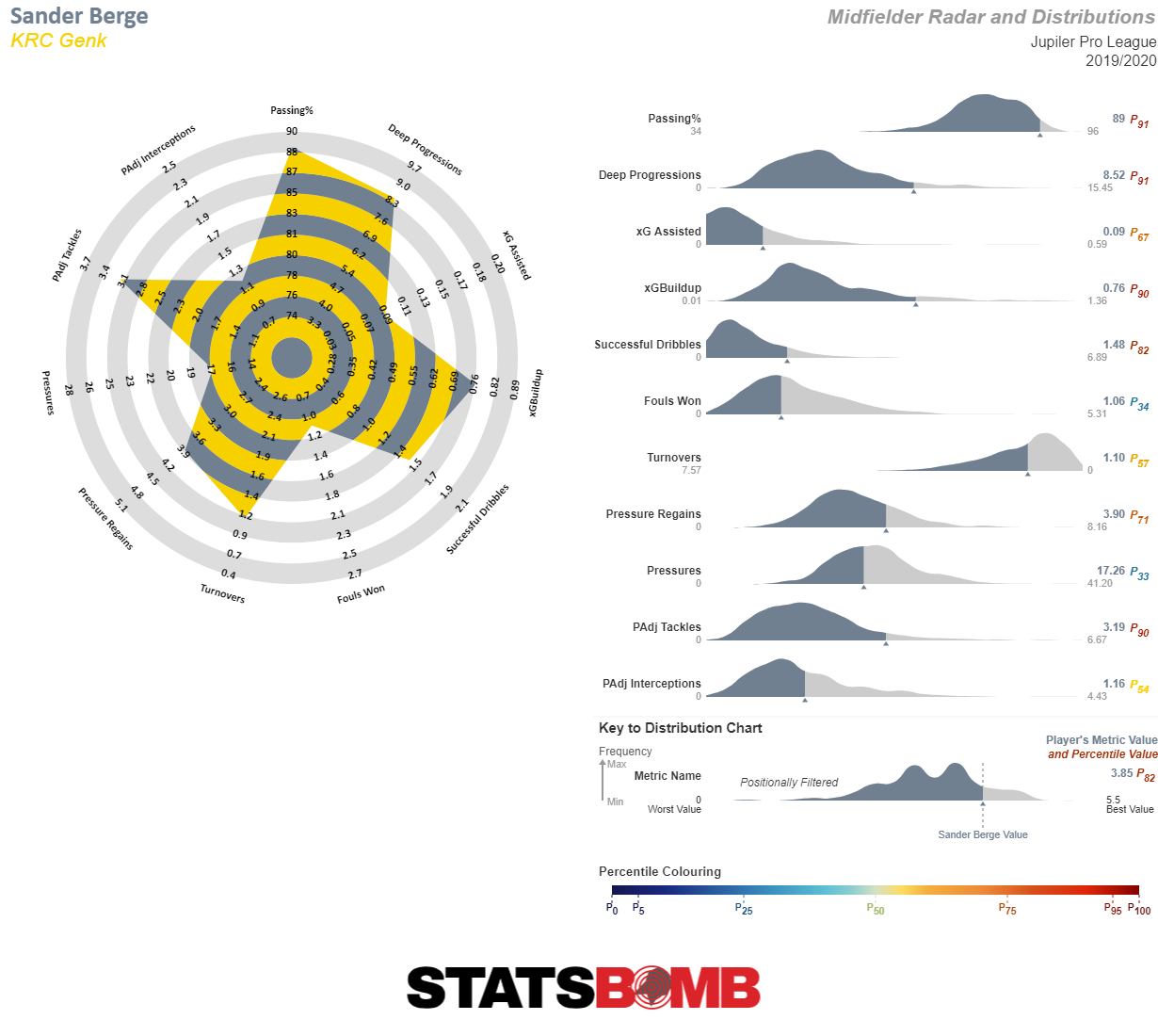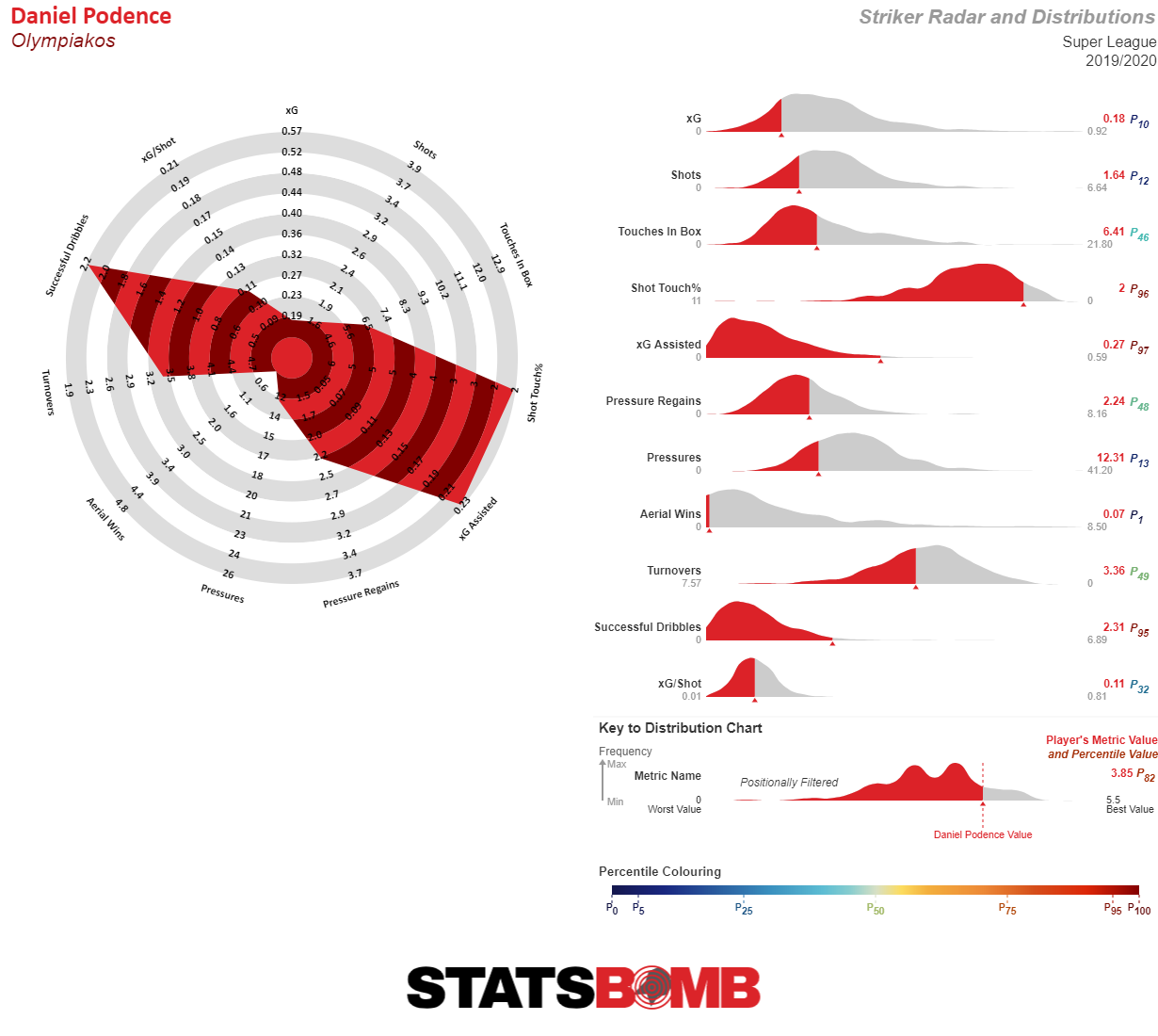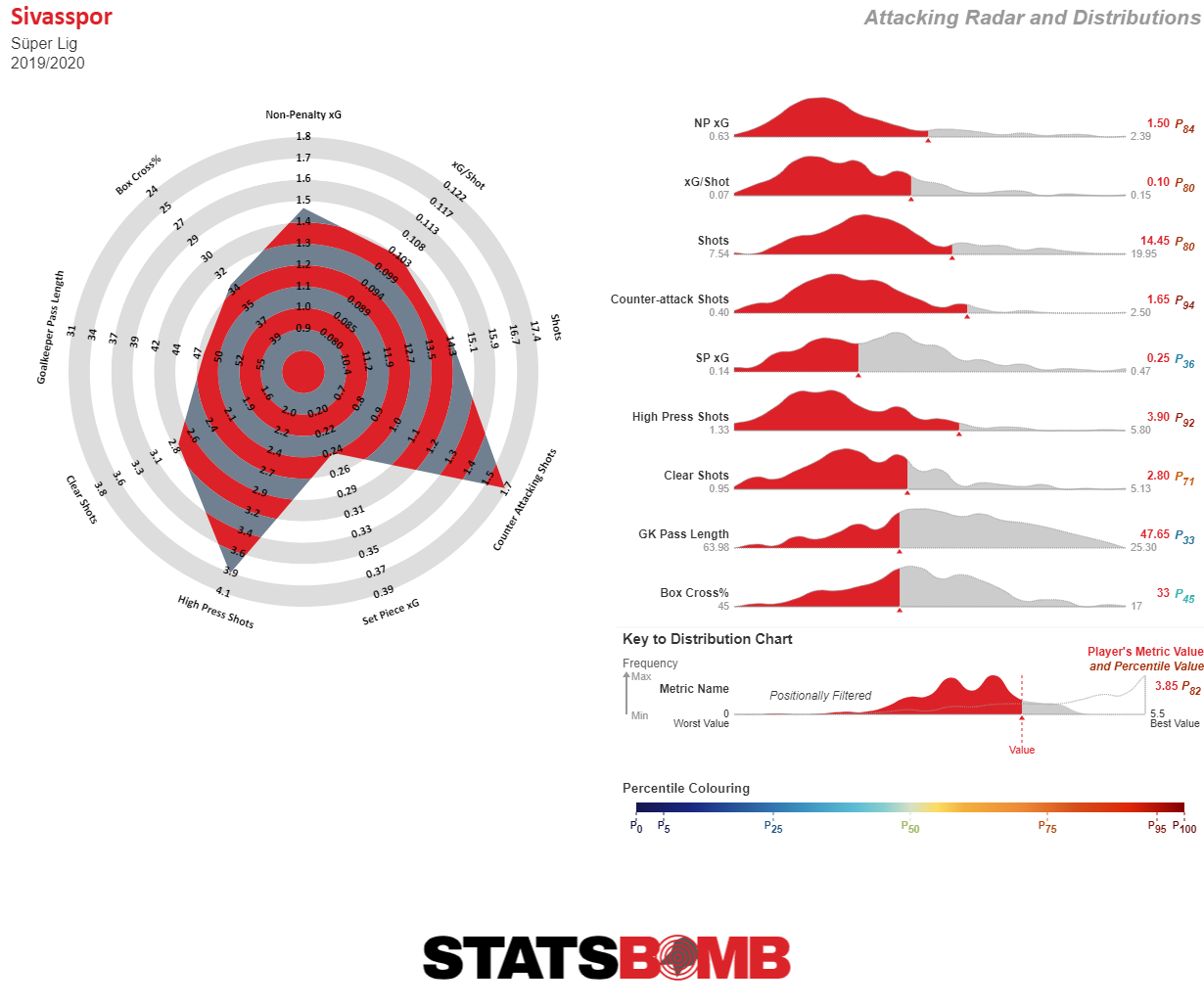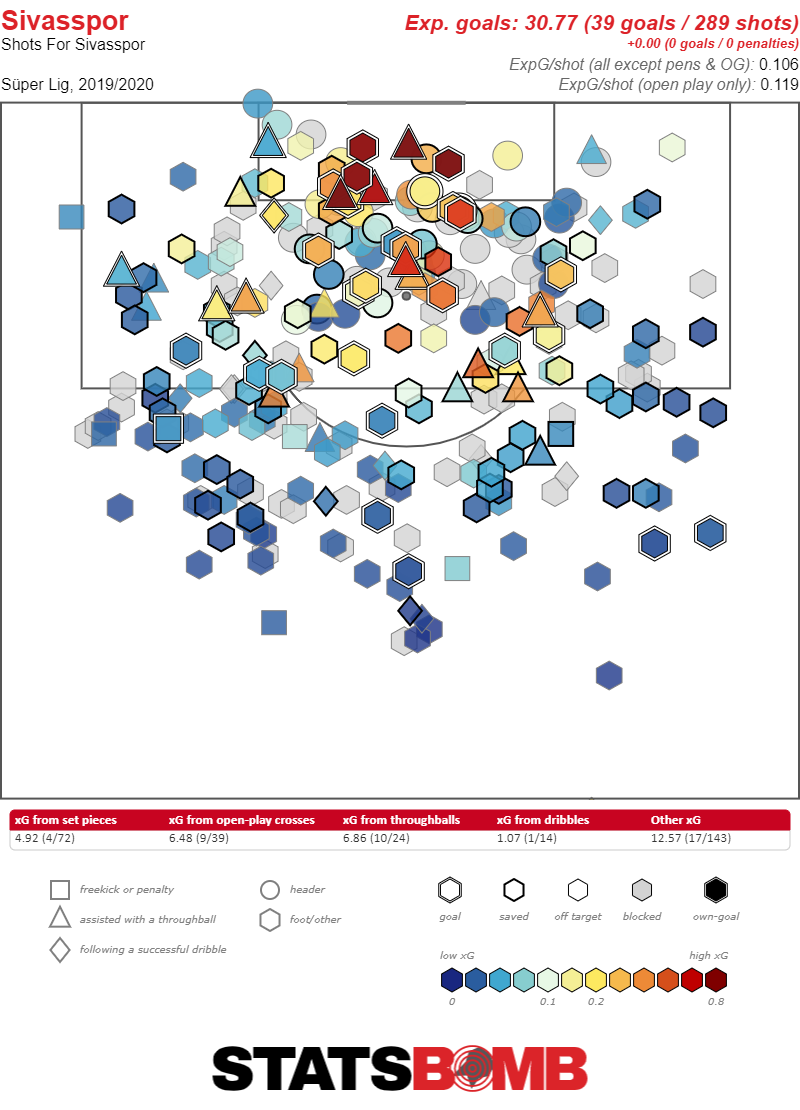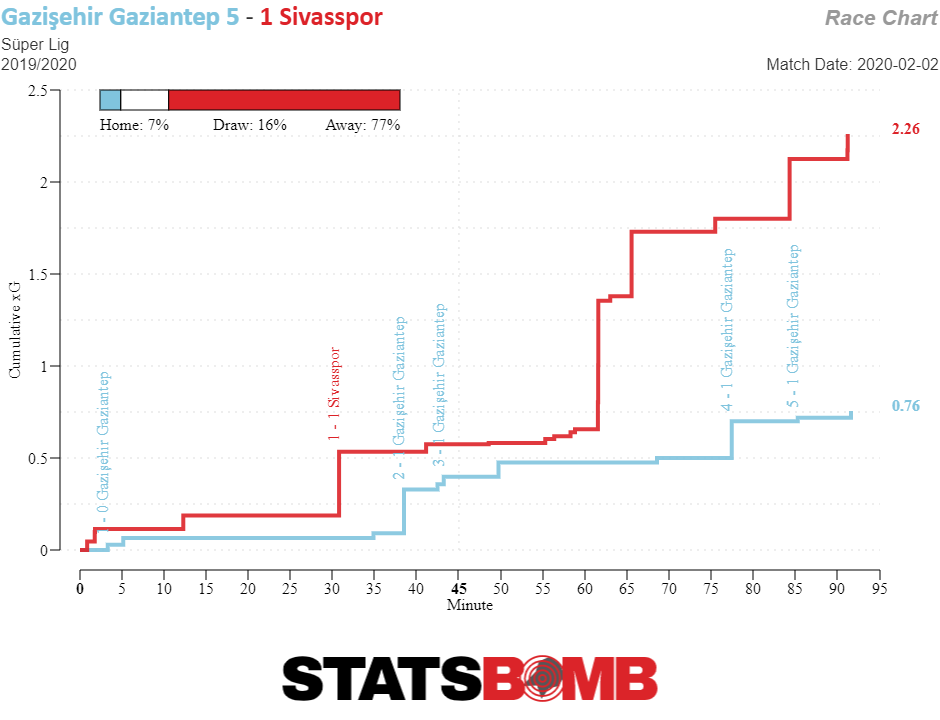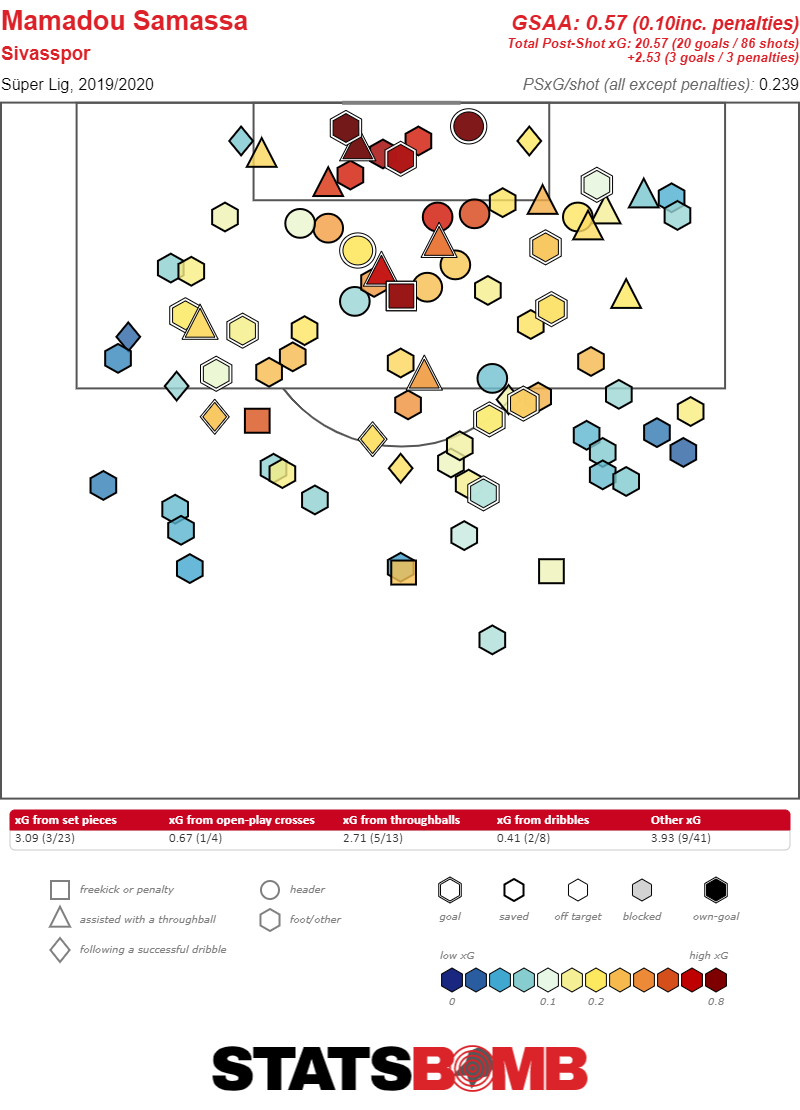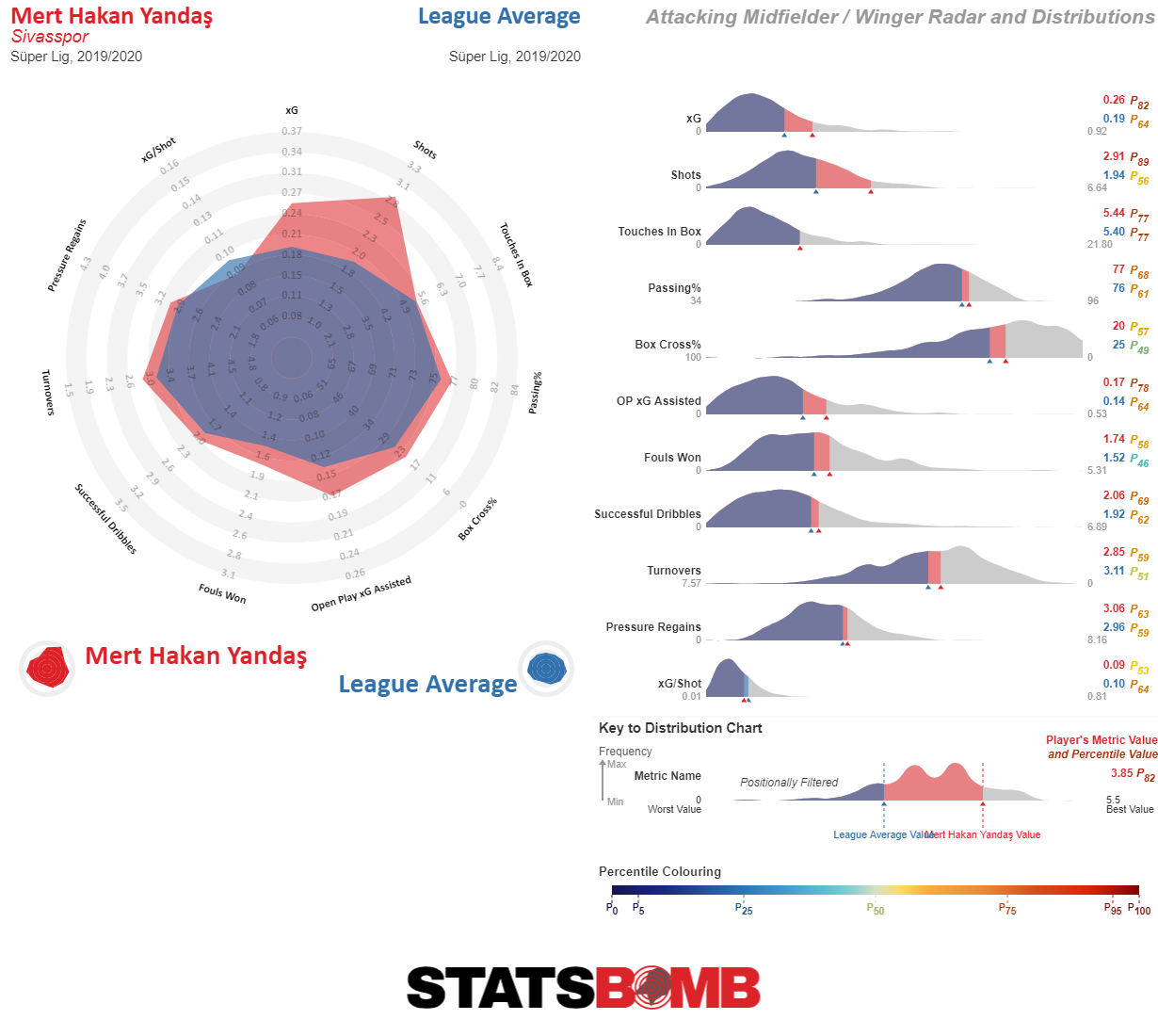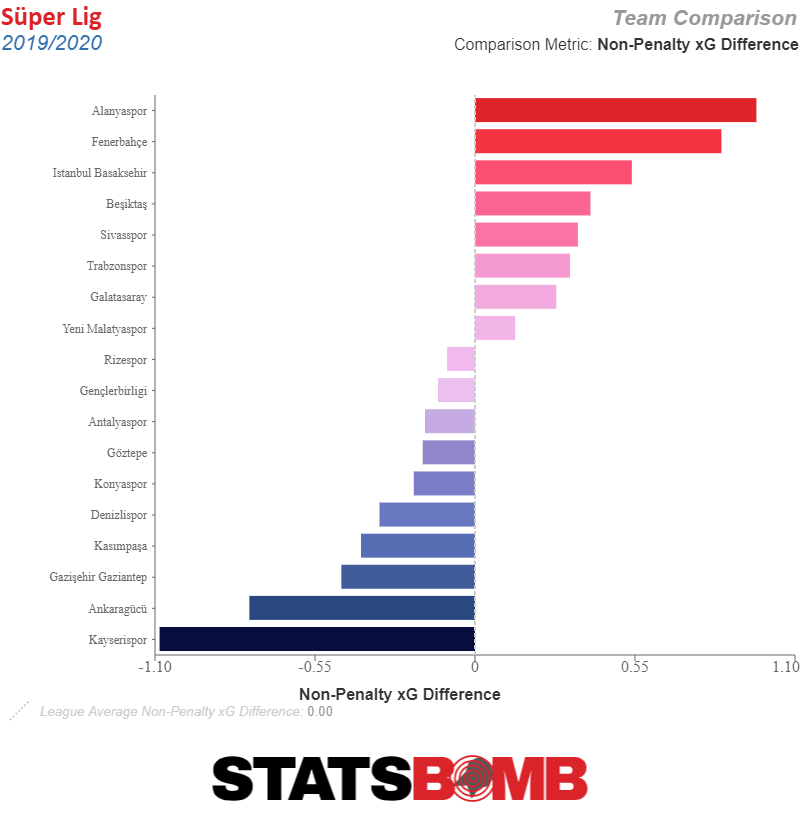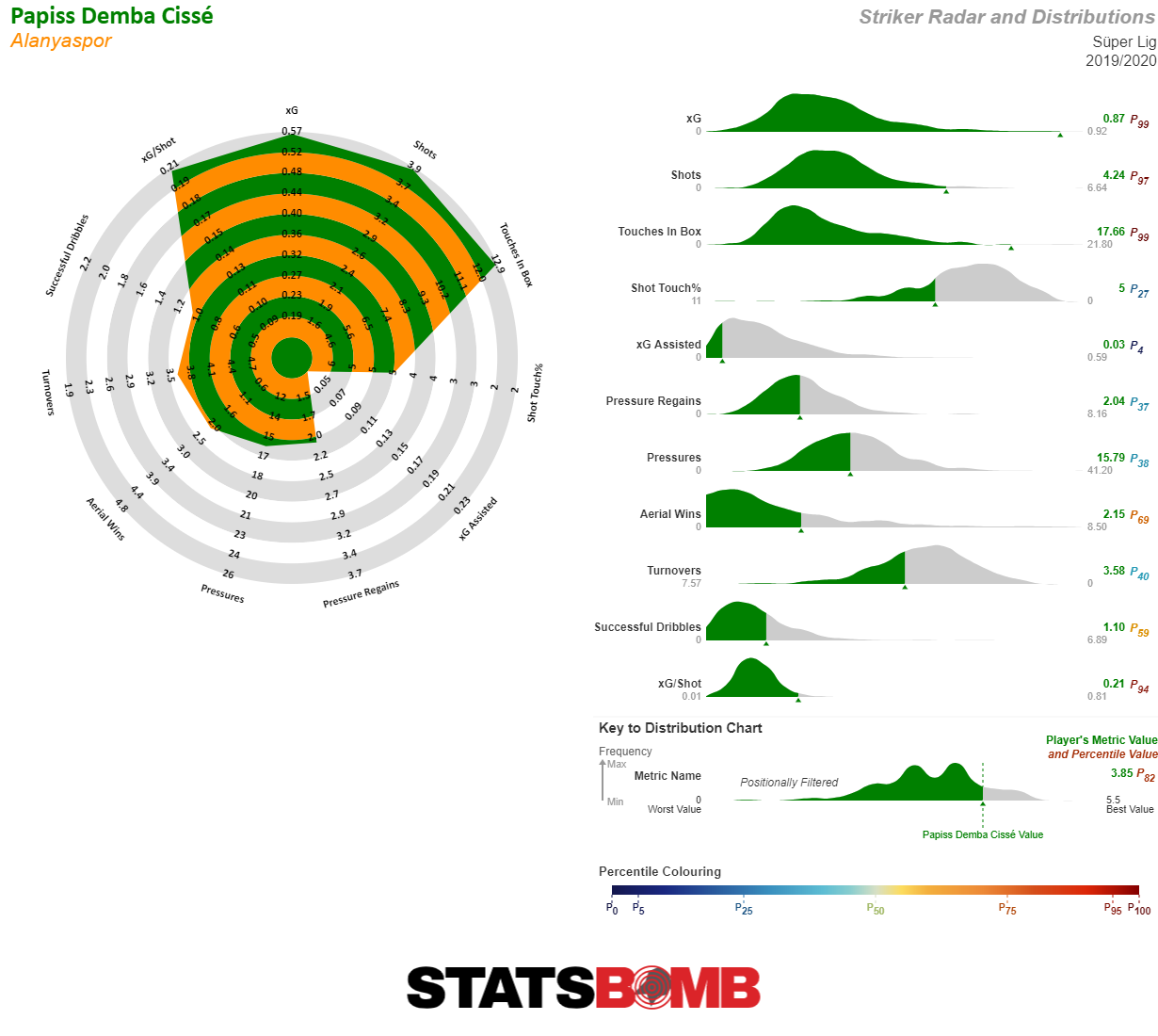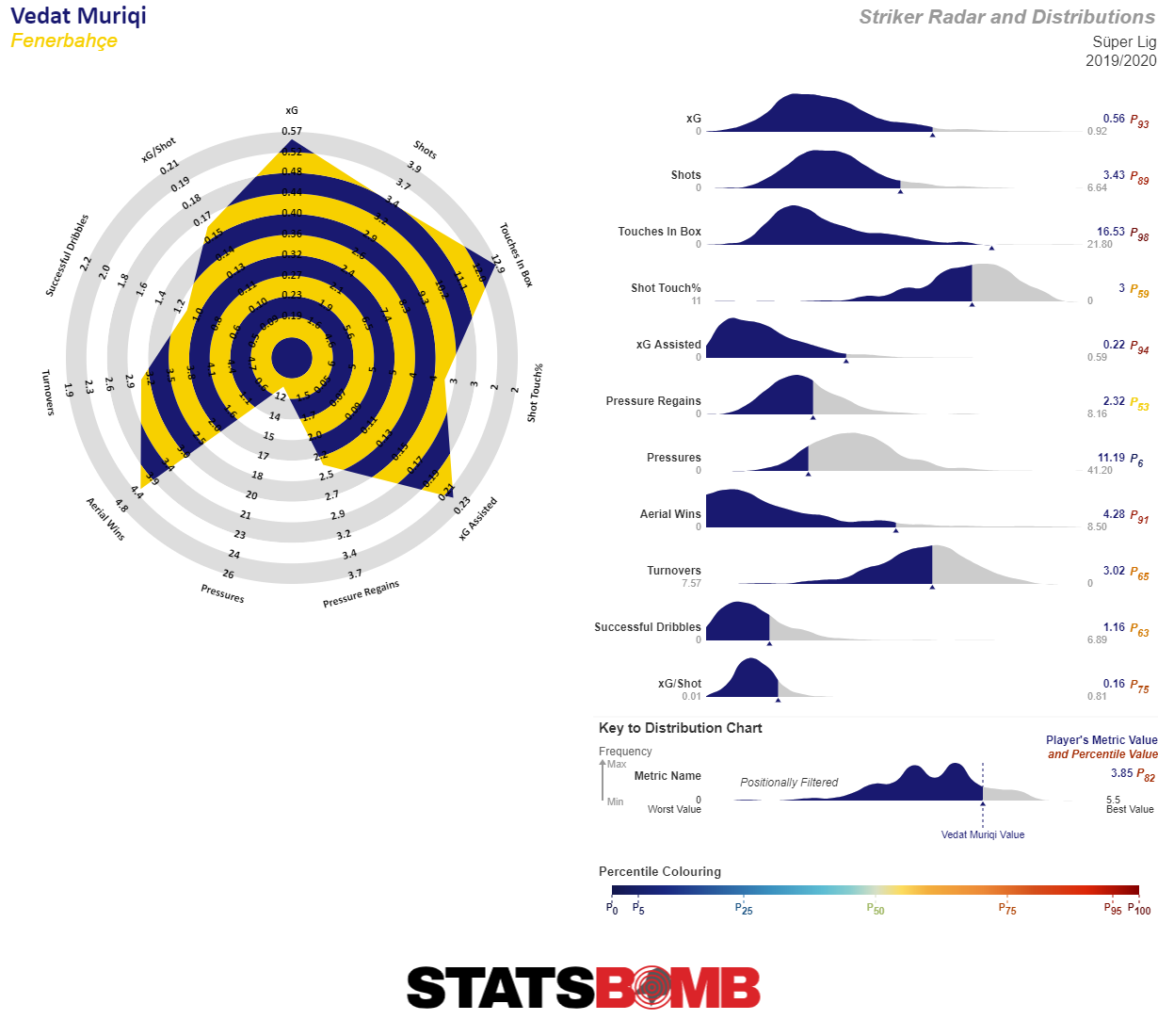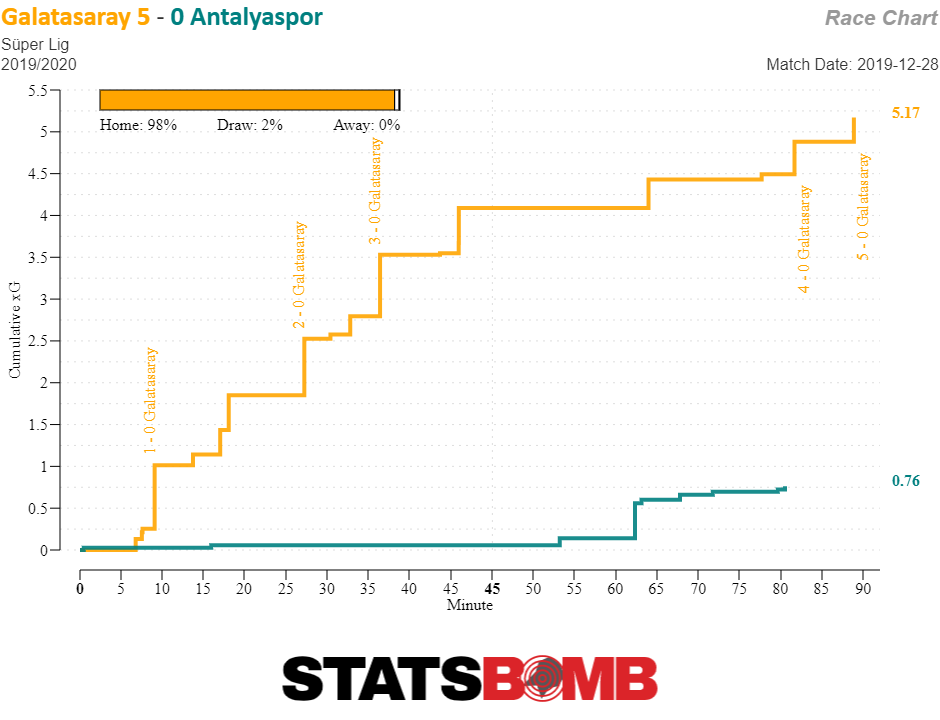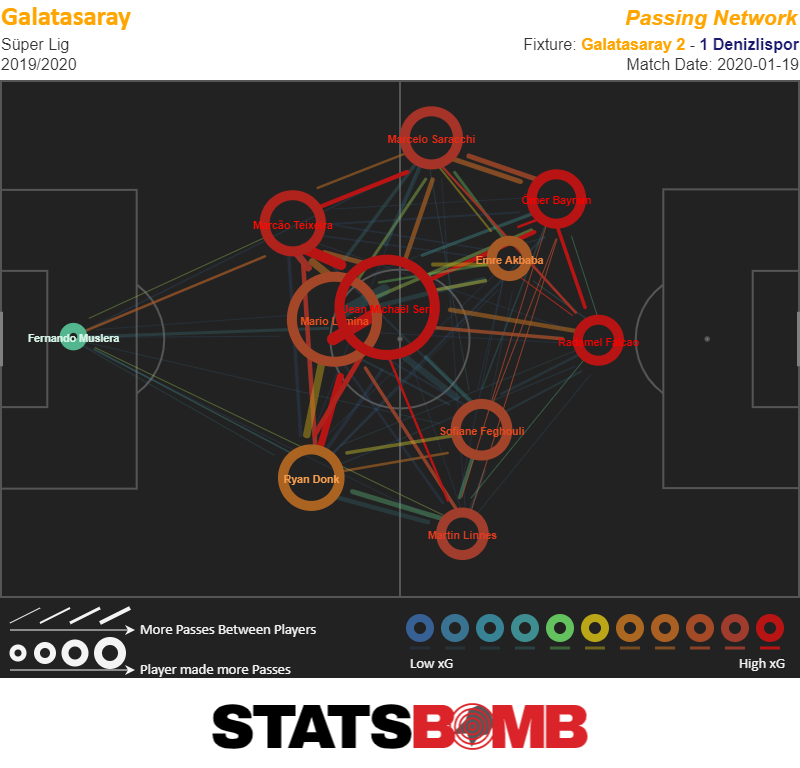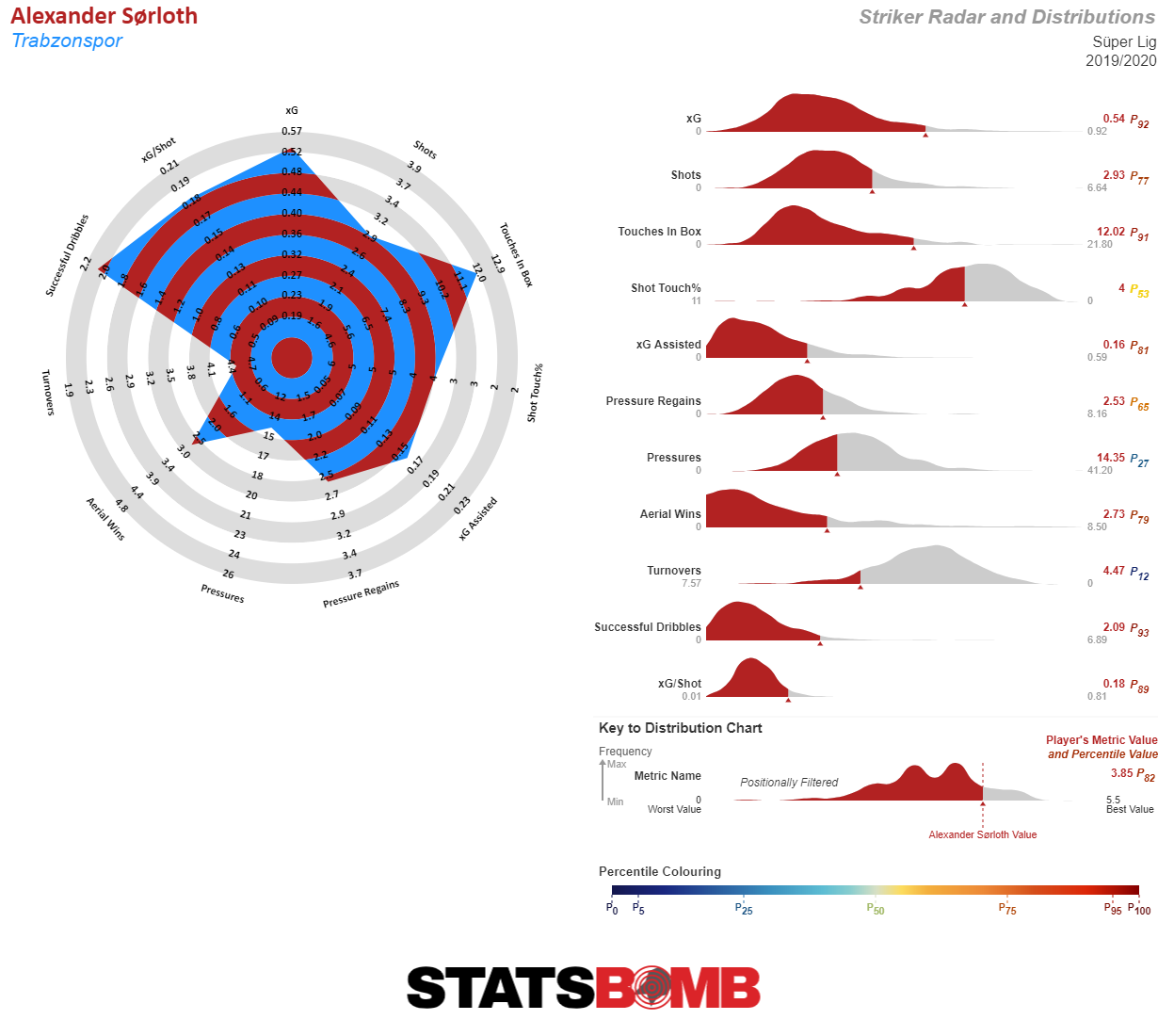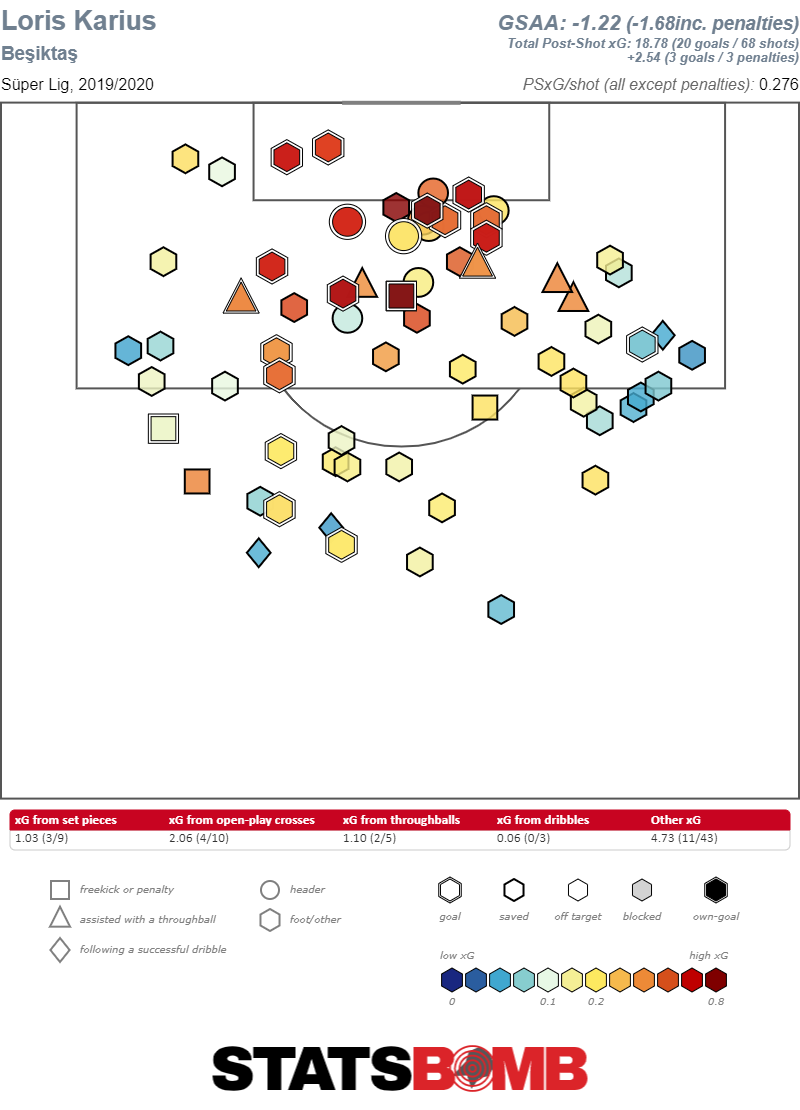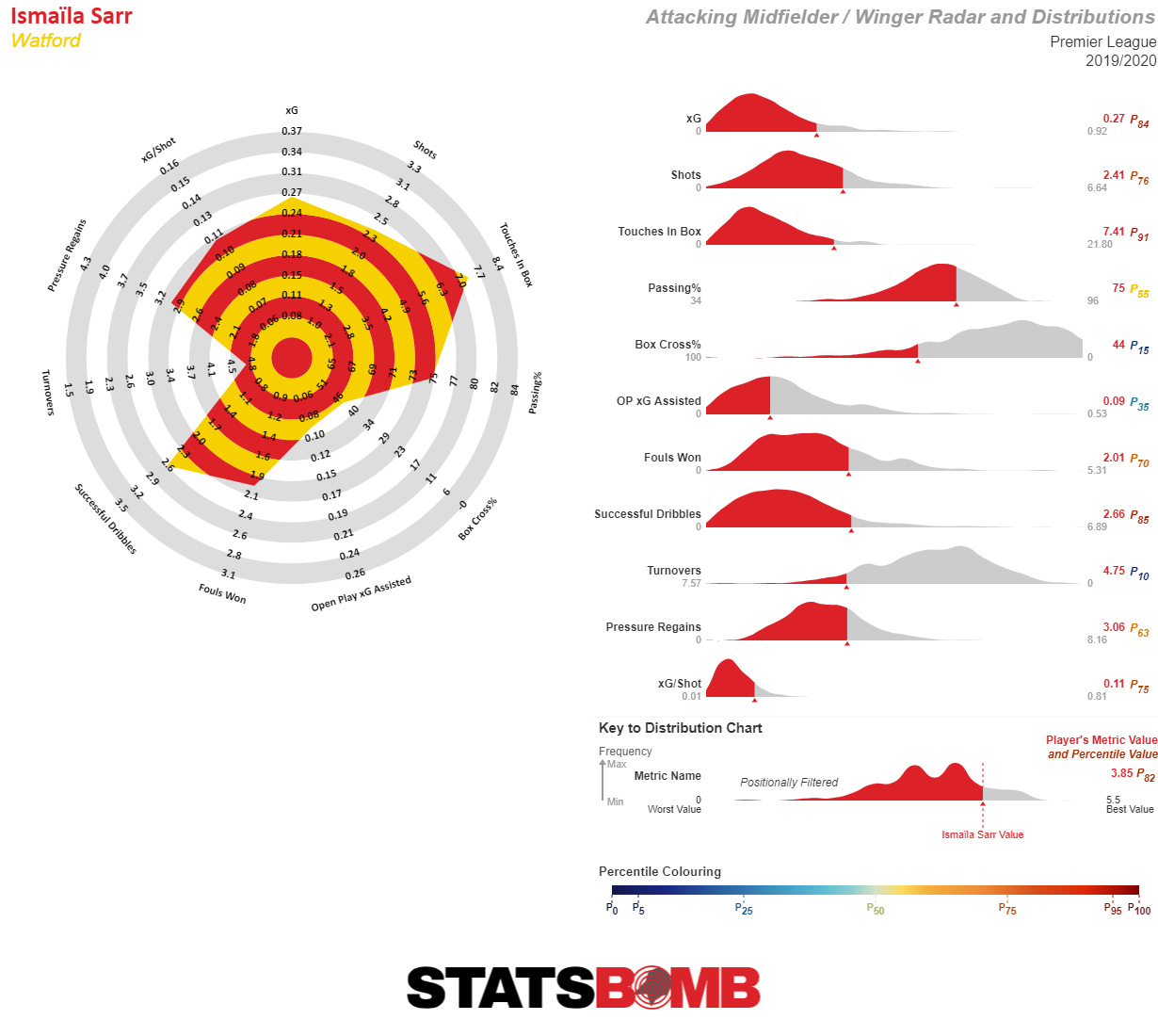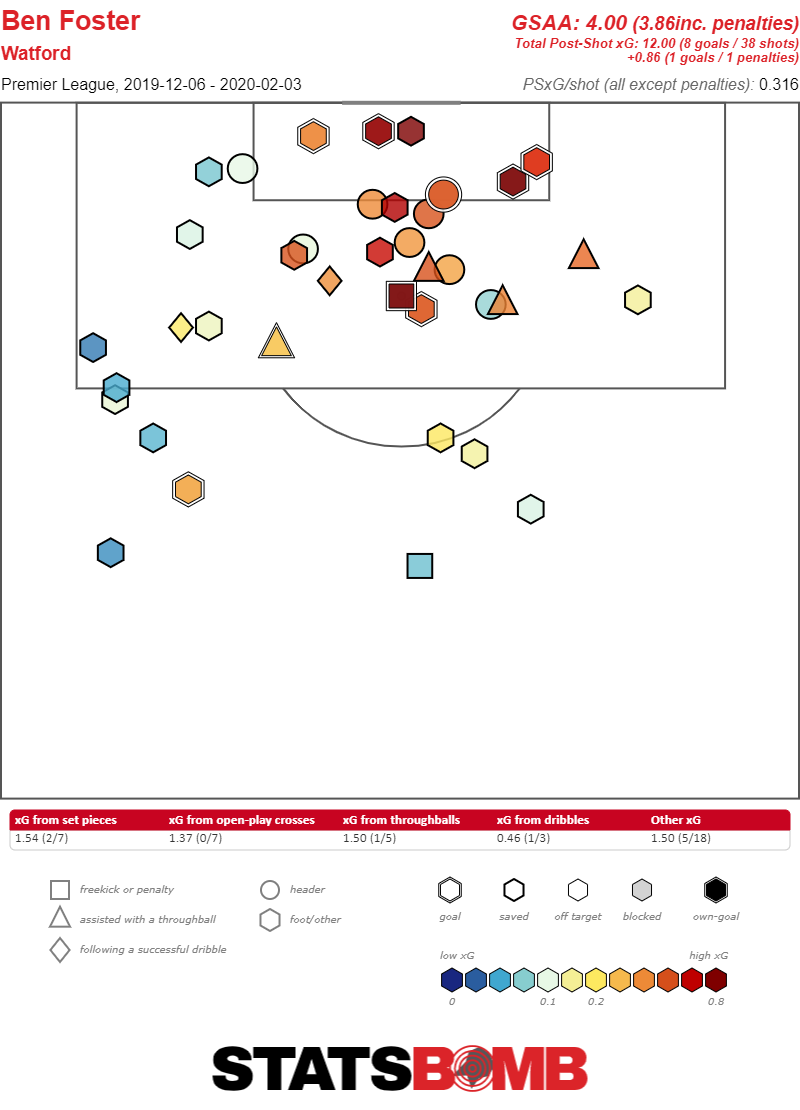With the phenomenal emergence of Erling Haaland, Jadon Sancho and Timo Werner, and with Robert Lewandowski cementing his status as the world’s best pure nine through ongoing machine-like efficiency, the Bundesliga's star power continues to grow. But in football, we divide our attention unfairly. Sure, we’re always interested in mega-mega-stars, like the foursome mentioned above. But stars come in different shapes and sizes. And today, we’d like to take a look at those Bundesliga players who excel on a weekly basis but seem to escape our attention because they play for smaller clubs or in non-glamorous roles. So without further ado, we’d like to present the StatsBomb No-Name All-Stars of the 2019-20 Bundesliga season.
Goalkeeper: Rafał Gikiewicz (Union Berlin)
We (heavily) praised Gikiewicz in this StatsBomb piece about the best keepers in this year’s Bundesliga. But the Polish late-bloomer — who, at age 32, is experiencing his first season as a starter in a top European league — is too solid to exclude from this team. Union Berlin's first season at the highest level of German football has been rather special. The East German side looks like they'll easily avoid relegation, playing solid, direct football. Gikiewicz's reflexes and ball distribution, alongside his goals saved above average of 2.17 (fifth in the Bundesliga) make him an integral part of the team's surprising success.
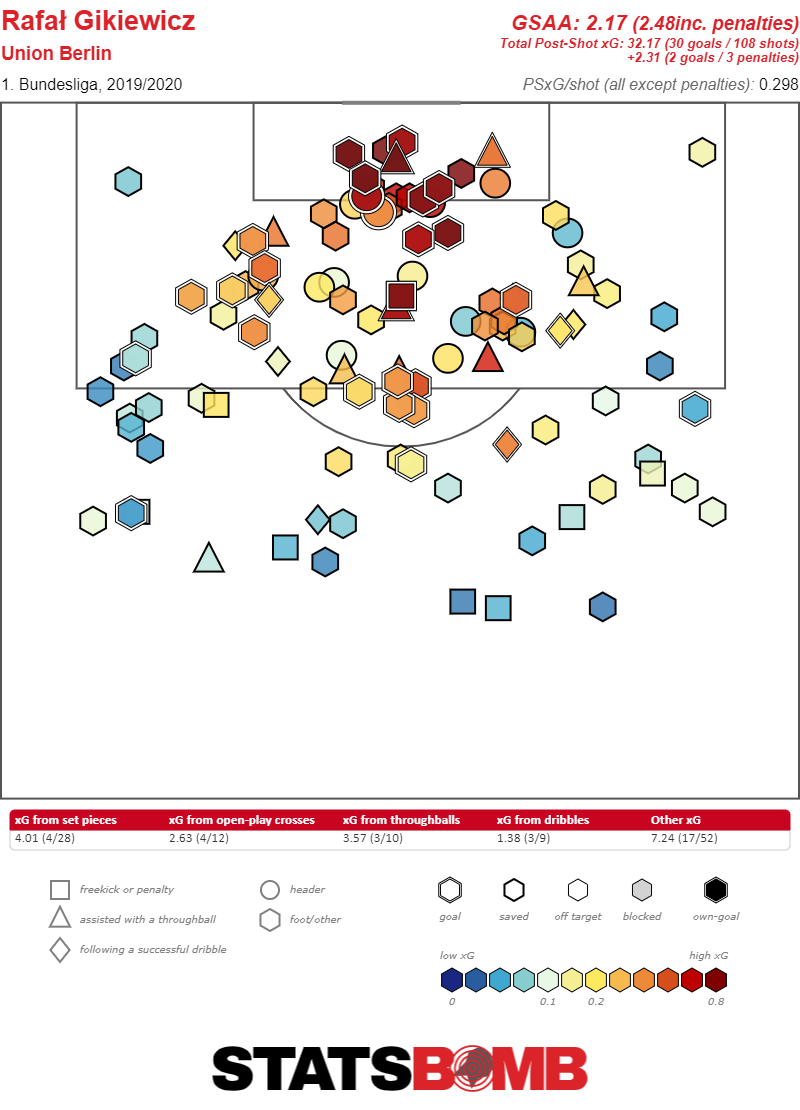 Right-back: William (VfL Wolfsburg)
Right-back: William (VfL Wolfsburg)
Out of the 18 Bundesliga clubs, only Bayern München, FC Augsburg and SC Paderborn have not opted for at least one game in which they play with three centre backs. So it only seems right that one of the many energizer-bunny wing-backs in Germany’s top league gets some love here. And with Wolfsburg’s excellent right-flanker William picking up a nasty knee injury this weekend, it's a good time to point out that the Brazilian has been excellent for Die Wölfe this season. Back in 2017, Wolfsburg paid a 5 million euro transfer fee for William, who already had three years as a full-time starter under his belt at Internacional before he turned 22 years old. 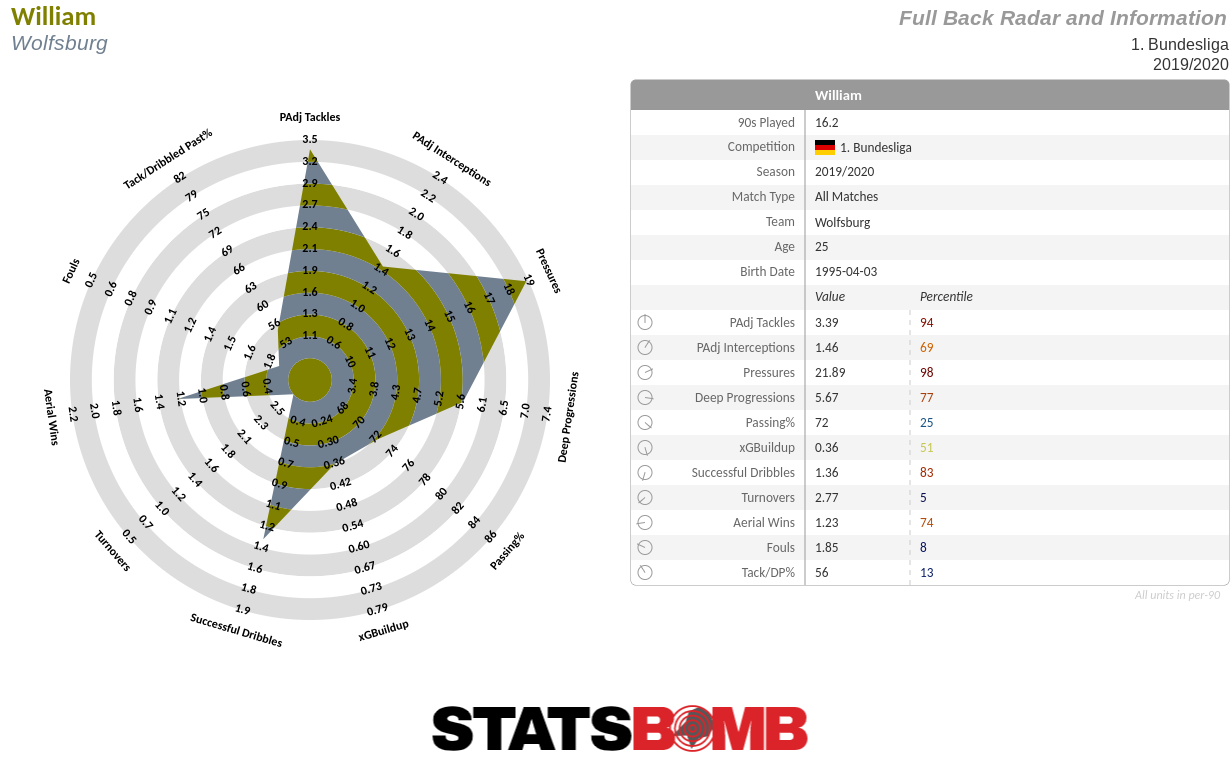 William, like most good wing-backs, boasts impressive stamina and ball-playing ability. But what sets the Brazilian apart from the other decent right-backs in the second half of the Bundesliga table is the fact that he can actually defend, a skill some of these new-age flank defenders often do not have in spades.
William, like most good wing-backs, boasts impressive stamina and ball-playing ability. But what sets the Brazilian apart from the other decent right-backs in the second half of the Bundesliga table is the fact that he can actually defend, a skill some of these new-age flank defenders often do not have in spades.
Centre-back: Ozan Kabak (Schalke 04)
What's up with young Turkish central defenders nowadays? Caglar Söyüncü is downright great at Leicester City, Merih Demiral nearly beat out record signing Matthijs de Ligt for the starting spot next to Leonardo Bonucci at Juventus and this Kabak youngster at Schalke is pretty, pret-tay, good. 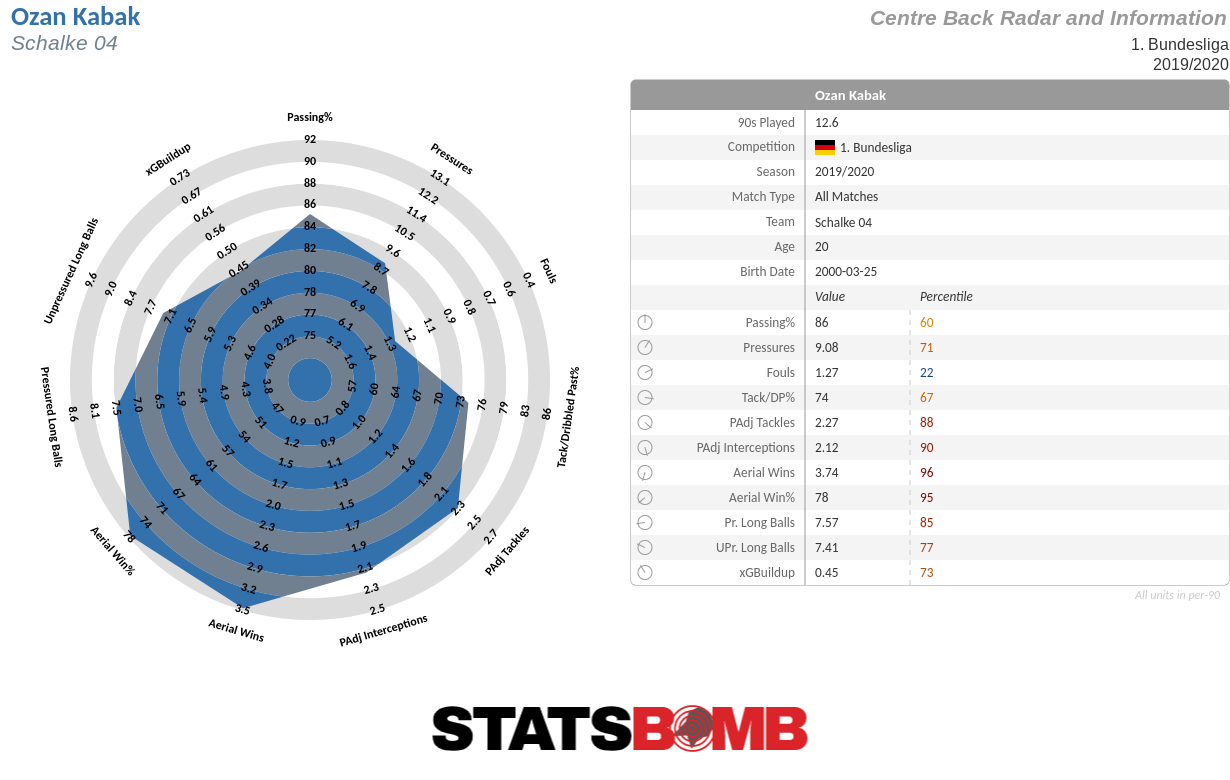 In January 2019, then-struggling VfB Stuttgart signed Kabak two months before his 19th birthday. Although Die Schwaben eventually lost their battle against relegation, Kabak had impressed enough that Schalke 04 was willing to pay 15 million euros for the teen defender, a 4 million euro increase from the fee that Stuttgart originally paid. The big loser in all of this? Kabak’s former club, Galatasaray, who took the quick money and now have to make peace with watching his development into an elite centre back from a distance. Kabak doesn’t have the imposing physique of his fellow countryman Demiral, but he more than makes up for that with his athletic ability. Kabak is quick, strong for someone his size and a noticeably good leaper. His game compares more to that of Söyüncü — Kabak, like Leicester’s young defensive star, shows great confidence and skill when building up play from the back, and possesses great instincts when it comes to taking up the right marking positions.
In January 2019, then-struggling VfB Stuttgart signed Kabak two months before his 19th birthday. Although Die Schwaben eventually lost their battle against relegation, Kabak had impressed enough that Schalke 04 was willing to pay 15 million euros for the teen defender, a 4 million euro increase from the fee that Stuttgart originally paid. The big loser in all of this? Kabak’s former club, Galatasaray, who took the quick money and now have to make peace with watching his development into an elite centre back from a distance. Kabak doesn’t have the imposing physique of his fellow countryman Demiral, but he more than makes up for that with his athletic ability. Kabak is quick, strong for someone his size and a noticeably good leaper. His game compares more to that of Söyüncü — Kabak, like Leicester’s young defensive star, shows great confidence and skill when building up play from the back, and possesses great instincts when it comes to taking up the right marking positions.
Centre-back: Sebastian Schonlau (SC Paderborn)
Listen, bad defensive teams might include good individual defensive talents. Such is the case for Schonlau. As a starting centre back for lowly Paderborn, Schonlau has been, unsurprisingly, very busy with defensive duties this year. 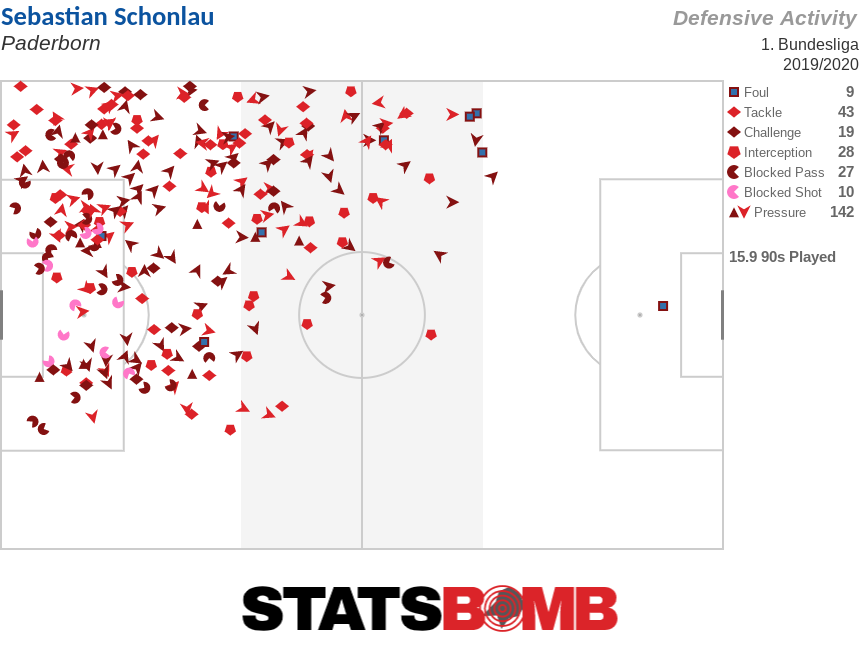 Schonlau has been solid, defensively. But the 25-year-old homegrown defenceman looks downright outstanding in games where his team actually has some of the ball. If Paderborn gets relegated, Schonlau won't need to worry about his future as a starting defender in Germany’s top league.
Schonlau has been solid, defensively. But the 25-year-old homegrown defenceman looks downright outstanding in games where his team actually has some of the ball. If Paderborn gets relegated, Schonlau won't need to worry about his future as a starting defender in Germany’s top league.
Left-back: Alphonso Davies (Bayern München)
Okay, okay. Sure. This is cheating, technically. A Bayern sensation should not be making the No-Name All-Star Squad. But (A) Davies was originally an attacker when Bayern brought him in as the next wonder talent, and (B) just please take a look at his radar. It’s not normal to have such an impact, at such a big club, at such a young age. 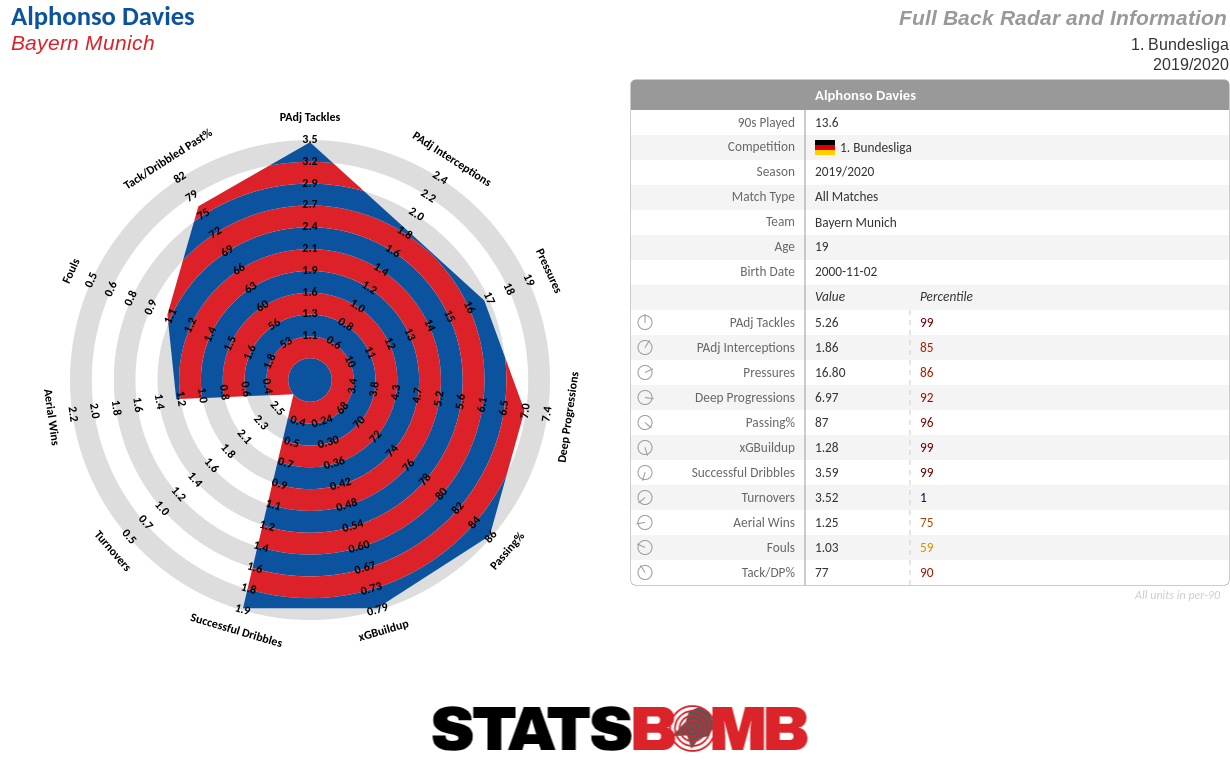 Defensive mid: Omar Mascarell (Schalke 04)
Defensive mid: Omar Mascarell (Schalke 04)
Look, we’re taking this All-Star thing seriously. So no gimmicky formations with seven attackers. We want our midfield to have balance! Remember that anonymous Spanish ball-winner who was excellent at Niko Kovač's Eintracht Frankfurt two years ago? Well, that guy, Omar Mascarell, has bounced back at Schalke from a pretty disappointing first year in Gelsenkirchen. The former Real Madrid youth product has grown into the most trusted lieutenant of new Schalke manager David Wagner. 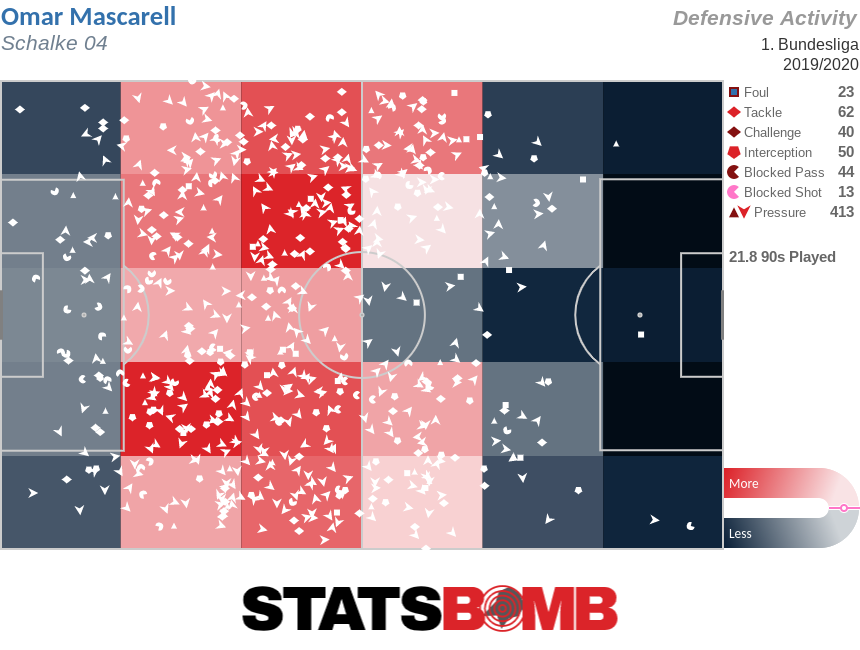
Attacking mid: Florian Neuhaus (Borussia Mönchengladbach)
Hot take: you’re being a bit of a Captain Hindsight if you say that one of Gladbach’s star performers cannot belong in a squad of ‘unknown’ All-Stars. Because nobody could have predicted such a marked improvement from Gladbach in his first year under Marco Rose and René Maric. This team is legitimately good, and seems to have long-term staying power (provided no one sneaks in to snap up Rose). Neuhaus is one of the most exciting players in this young squad. The 22-year-old’s game is similar to Leon Goretzka’s, as he's heavy-running ball-winner, ‘doesn’t do’ silly losses of possession, is a neat dribbler and has a sharp eye for the right shot selection. 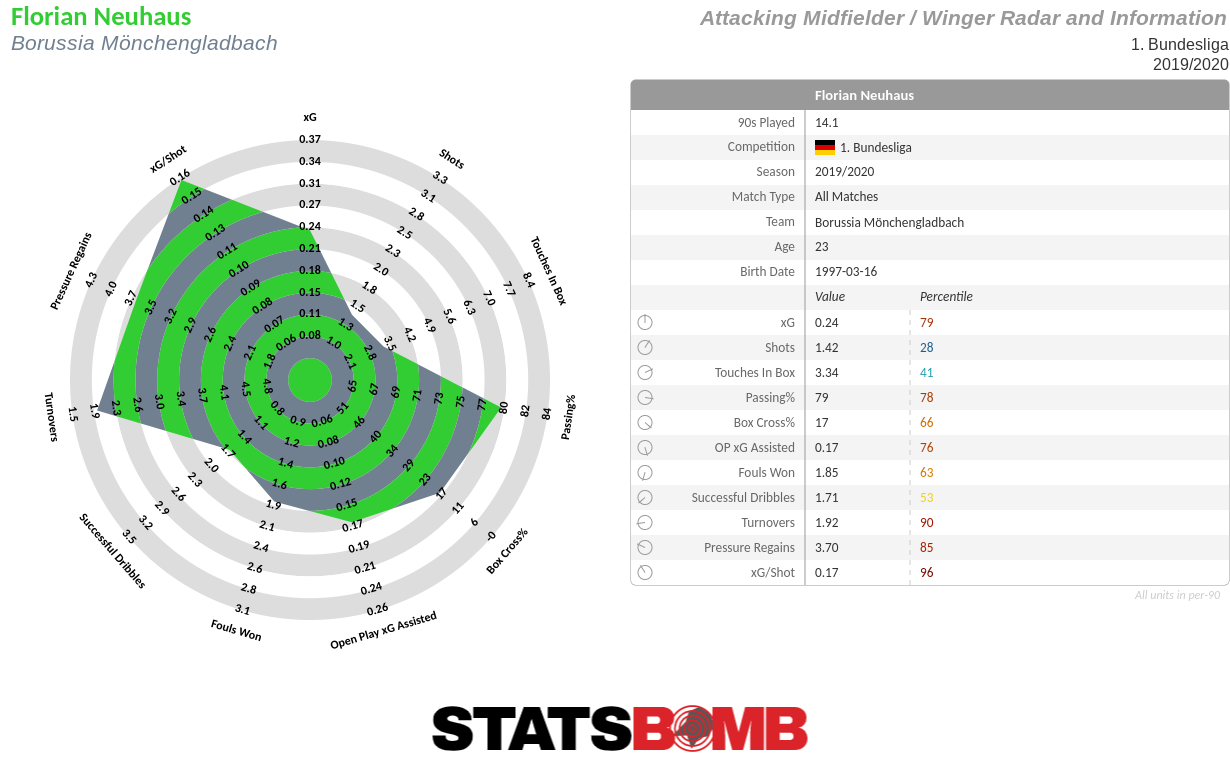
Attacking mid: Cristopher Nkunku (RB Leipzig)
RB Leipzig truly know what they are doing, scouting-wise. Look at Nkunku’s production. Not too shabby for a PSG cast-off that only cost Die Roten Bullen around 13 million euros. 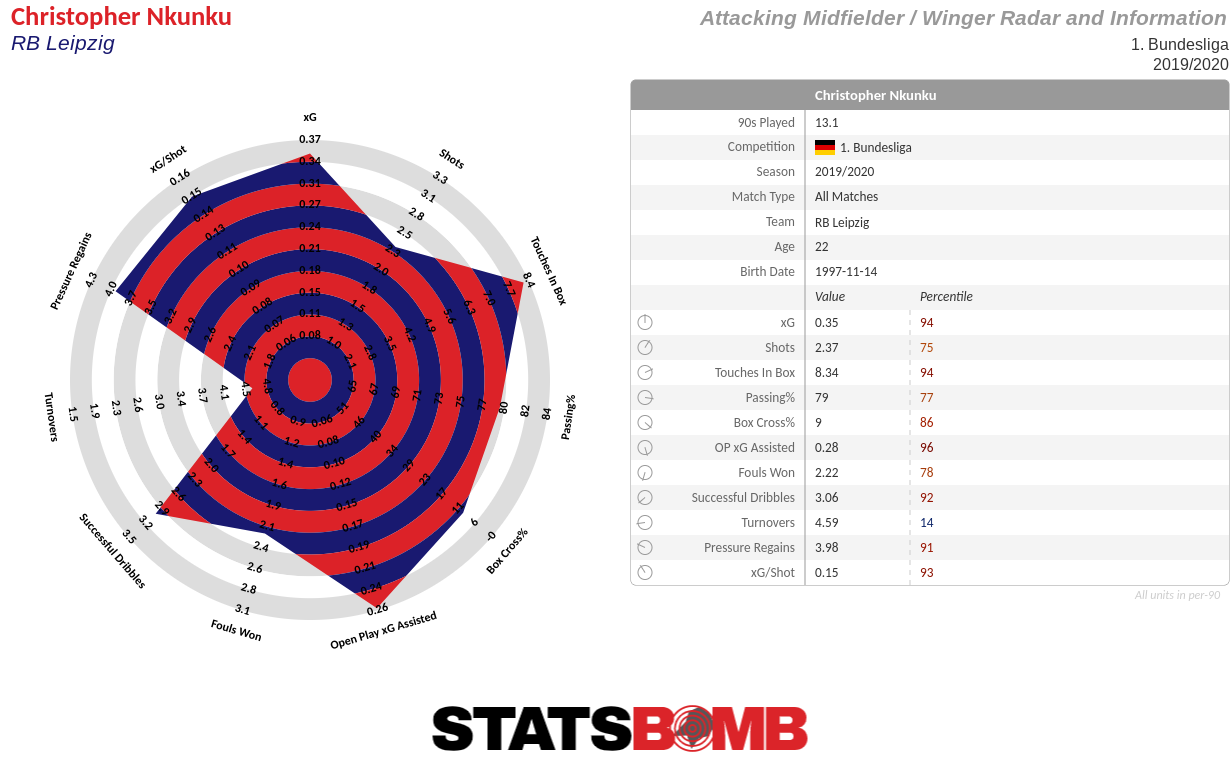 It's not only his output, but the fact that the man plays literally everywhere. Here the attacking midfielder/winger radar is used, but he's logged minutes from fullback to striker. Nkunkou is a truly unique blend of ability and versatility.
It's not only his output, but the fact that the man plays literally everywhere. Here the attacking midfielder/winger radar is used, but he's logged minutes from fullback to striker. Nkunkou is a truly unique blend of ability and versatility.
Winger: Milot Rashica (Werder Bremen)
While it's commendable that Werder are sticking with their young manager Florian Kohfeldt through a truly horrid spell of results, it feels strange to think that a club with Bremen's track record could slide down into the 2.Bundesliga, even if it's becoming more and more likely each week. If it happens, a (somewhat) wealthy club could make a wise move in the summer transfer window by taking a flier on Werder’s star player. 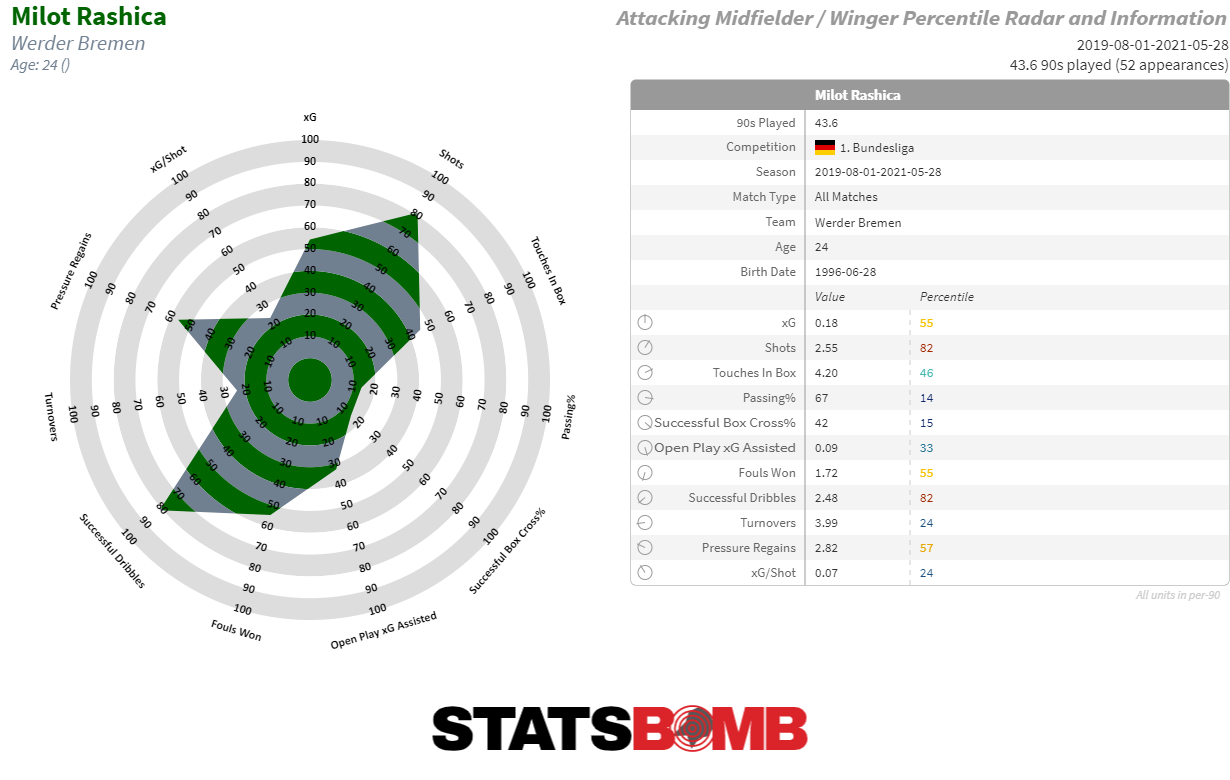 Admittedly, Rashica often cannot recognize a well-chosen time to shoot (or, more often, to not shoot), but the Kosovar winger does two things well enough to earn a serious look from bigger clubs. First, the former Vitesse attacker knows how to get his shots — which, yeah, kind of gets nullified by shoddy selection. But Rashica also is an elite dribbler. The 23-year-old is speedy, can throw a couple of nice body feints to blow by opposing backs, and has plenty of shot power in both feet. If he just stopped being so very, very indiscriminate with his shooting, he might end up becoming an impact player at a club that doesn't increasingly look destined for a historic demotion.
Admittedly, Rashica often cannot recognize a well-chosen time to shoot (or, more often, to not shoot), but the Kosovar winger does two things well enough to earn a serious look from bigger clubs. First, the former Vitesse attacker knows how to get his shots — which, yeah, kind of gets nullified by shoddy selection. But Rashica also is an elite dribbler. The 23-year-old is speedy, can throw a couple of nice body feints to blow by opposing backs, and has plenty of shot power in both feet. If he just stopped being so very, very indiscriminate with his shooting, he might end up becoming an impact player at a club that doesn't increasingly look destined for a historic demotion. 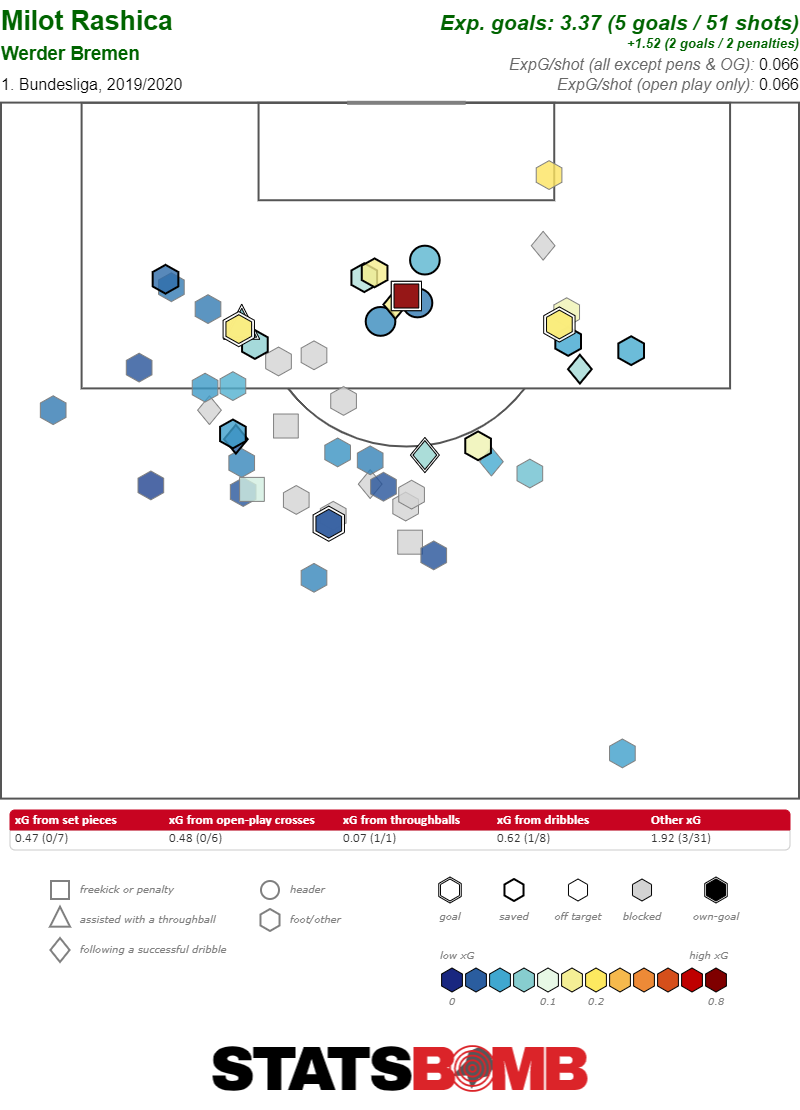
Winger: Ruben Vargas (FC Augsburg)
To balance out Rashica’s wild flavor in shot selection, our All-Star squad also gets a young winger who excels in taking smart shots. 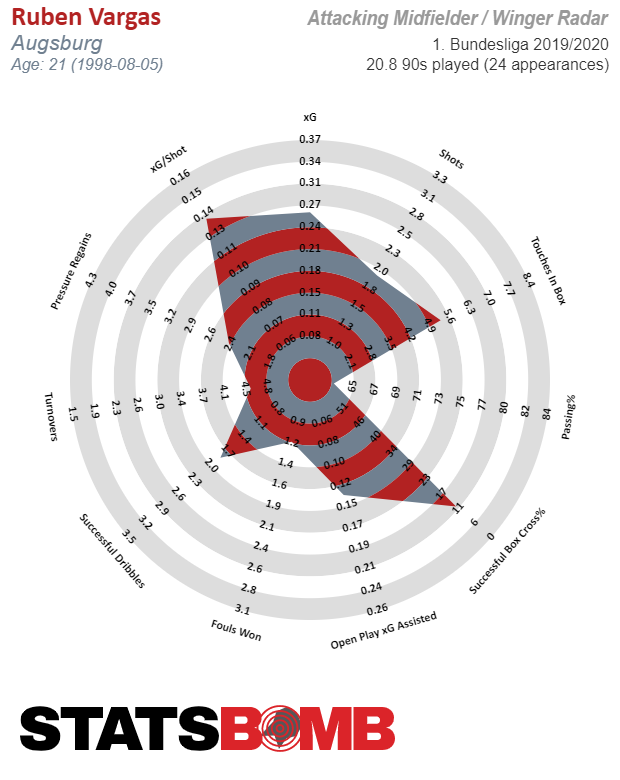 The signing of the Swiss-Dominican Vargas was a pretty impressive bit of transfer business by Augsburg this summer. The 2.7 million euro fee they paid FC Lüzern can be multiplied by a lot if Augsburg decide to sell their talented left-winger. Vargas possesses the rare combo of elite speed and two-footedness as a passer and finisher.
The signing of the Swiss-Dominican Vargas was a pretty impressive bit of transfer business by Augsburg this summer. The 2.7 million euro fee they paid FC Lüzern can be multiplied by a lot if Augsburg decide to sell their talented left-winger. Vargas possesses the rare combo of elite speed and two-footedness as a passer and finisher.
Striker: Gonçalo Paciência (Eintracht Frankfurt)
Let’s get funky in rounding out our All-Underrated Squad. Heck, let’s start a playmaking striker up top. Paciência is a fun player to watch, and Frankfurt are on the rise. 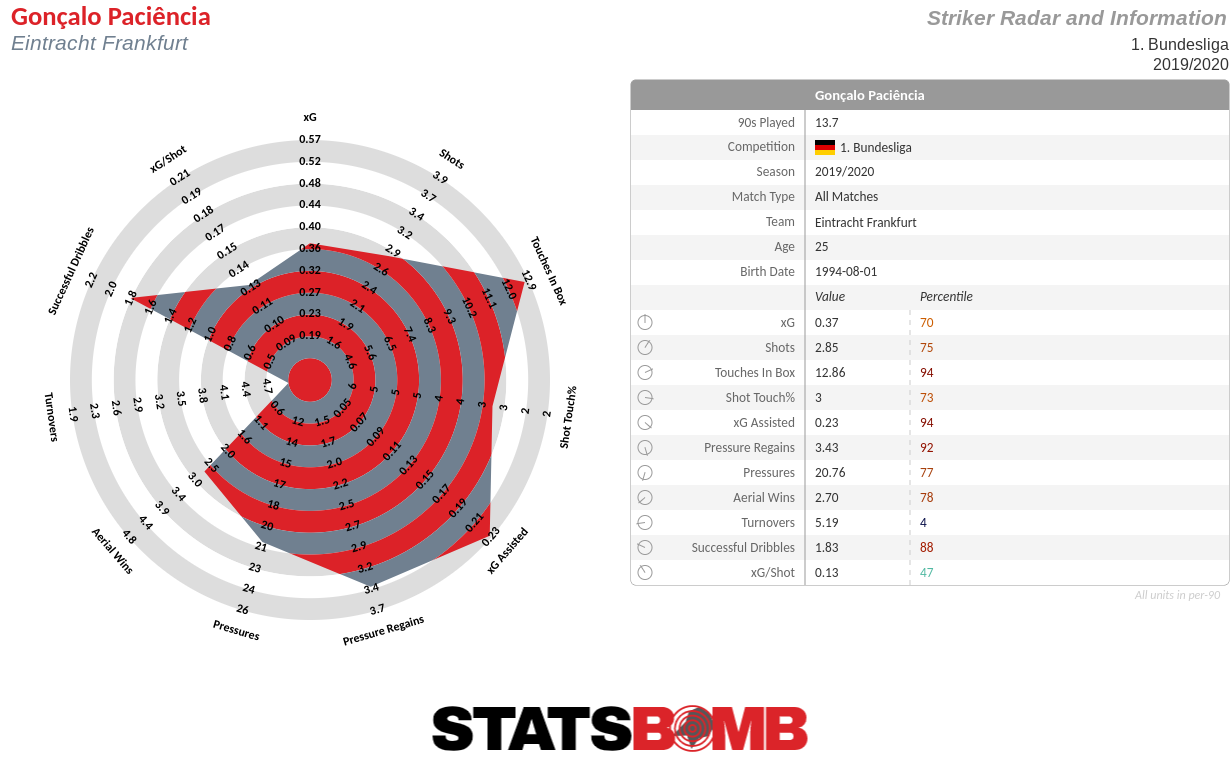
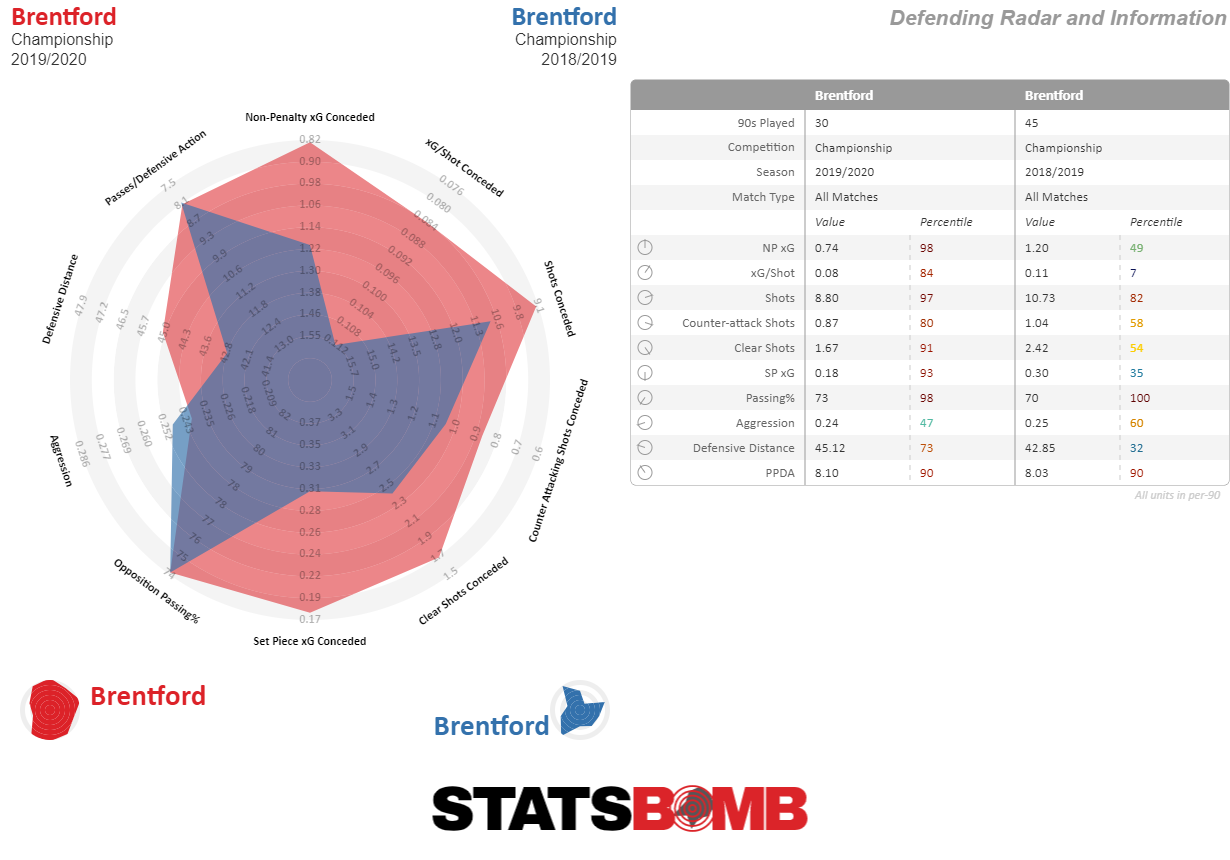
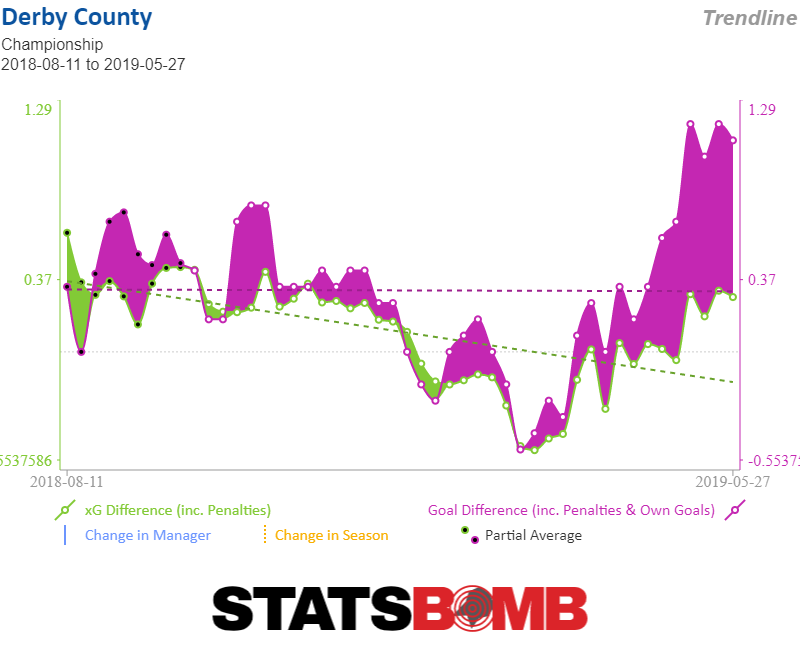 As Chris points out, after removing the now-established Premier League talent of Fikayo Tomori, Mason Mount and Harry Wilson from the side, the team were already working off a much weaker base going into this season. A team that was barely a top-six Championship side now most certainly wouldn't finish that high unless Derby could repeat the trick of recruiting well to replace the quality lost, which was always going to be difficult to do. Factor in the literal rap sheet of bad off-field behavior — which seems to pile in on a monthly basis — and the foundations simply aren’t there for the team to mount a promotion bid. For me, Cocu gets a free pass on that. Given that Derby were reliant on the aforementioned loan signings to reach the top six last season, it’s clear the squad's foundations did not rise to that level without those players, and therefore a squad rebuild was/is required. Before a squad really takes on the manager's image, the club needs three (at minimum) transfer windows to find the right players. One feather in Cocu’s cap is that in the absence of incoming replacements, he’s integrated more academy products to the team. In addition to last season’s standouts, Jayden Bogle. Jason Knight and Max Lowe, who are getting regular minutes, several more linger on the fringes, in position to break through over the next couple of seasons. The introduction of these players — assuming they are of sufficient quality, which early indicators suggest they may well be — will save Derby money in the transfer market or could help to fund their rebuild if these players progress faster than the club and move on to the Premier League (cough, Bogle, cough). On the pitch, it was a pretty underwhelming start, but the stats indicate their performances are moving in the right direction, although the recent run of good form has come on a ridiculously soft set of fixtures.
As Chris points out, after removing the now-established Premier League talent of Fikayo Tomori, Mason Mount and Harry Wilson from the side, the team were already working off a much weaker base going into this season. A team that was barely a top-six Championship side now most certainly wouldn't finish that high unless Derby could repeat the trick of recruiting well to replace the quality lost, which was always going to be difficult to do. Factor in the literal rap sheet of bad off-field behavior — which seems to pile in on a monthly basis — and the foundations simply aren’t there for the team to mount a promotion bid. For me, Cocu gets a free pass on that. Given that Derby were reliant on the aforementioned loan signings to reach the top six last season, it’s clear the squad's foundations did not rise to that level without those players, and therefore a squad rebuild was/is required. Before a squad really takes on the manager's image, the club needs three (at minimum) transfer windows to find the right players. One feather in Cocu’s cap is that in the absence of incoming replacements, he’s integrated more academy products to the team. In addition to last season’s standouts, Jayden Bogle. Jason Knight and Max Lowe, who are getting regular minutes, several more linger on the fringes, in position to break through over the next couple of seasons. The introduction of these players — assuming they are of sufficient quality, which early indicators suggest they may well be — will save Derby money in the transfer market or could help to fund their rebuild if these players progress faster than the club and move on to the Premier League (cough, Bogle, cough). On the pitch, it was a pretty underwhelming start, but the stats indicate their performances are moving in the right direction, although the recent run of good form has come on a ridiculously soft set of fixtures. 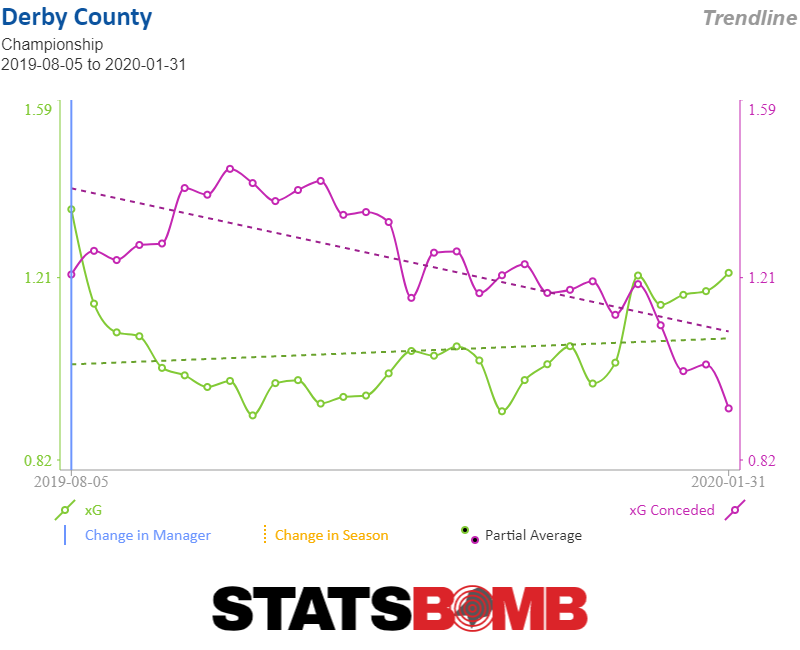 All in all, Cocu’s had a frankly ridiculous set of off-field distractions to wrestle with this season, none of which he is responsible for. Is he maximising the team at the moment? Probably not. Is it reasonable to expect him to be doing so given the circumstances he’s had to manage under? Definitely not. https://twitter.com/fplredrobin/status/1224391817388613642 I’ll let you be the judge.
All in all, Cocu’s had a frankly ridiculous set of off-field distractions to wrestle with this season, none of which he is responsible for. Is he maximising the team at the moment? Probably not. Is it reasonable to expect him to be doing so given the circumstances he’s had to manage under? Definitely not. https://twitter.com/fplredrobin/status/1224391817388613642 I’ll let you be the judge. 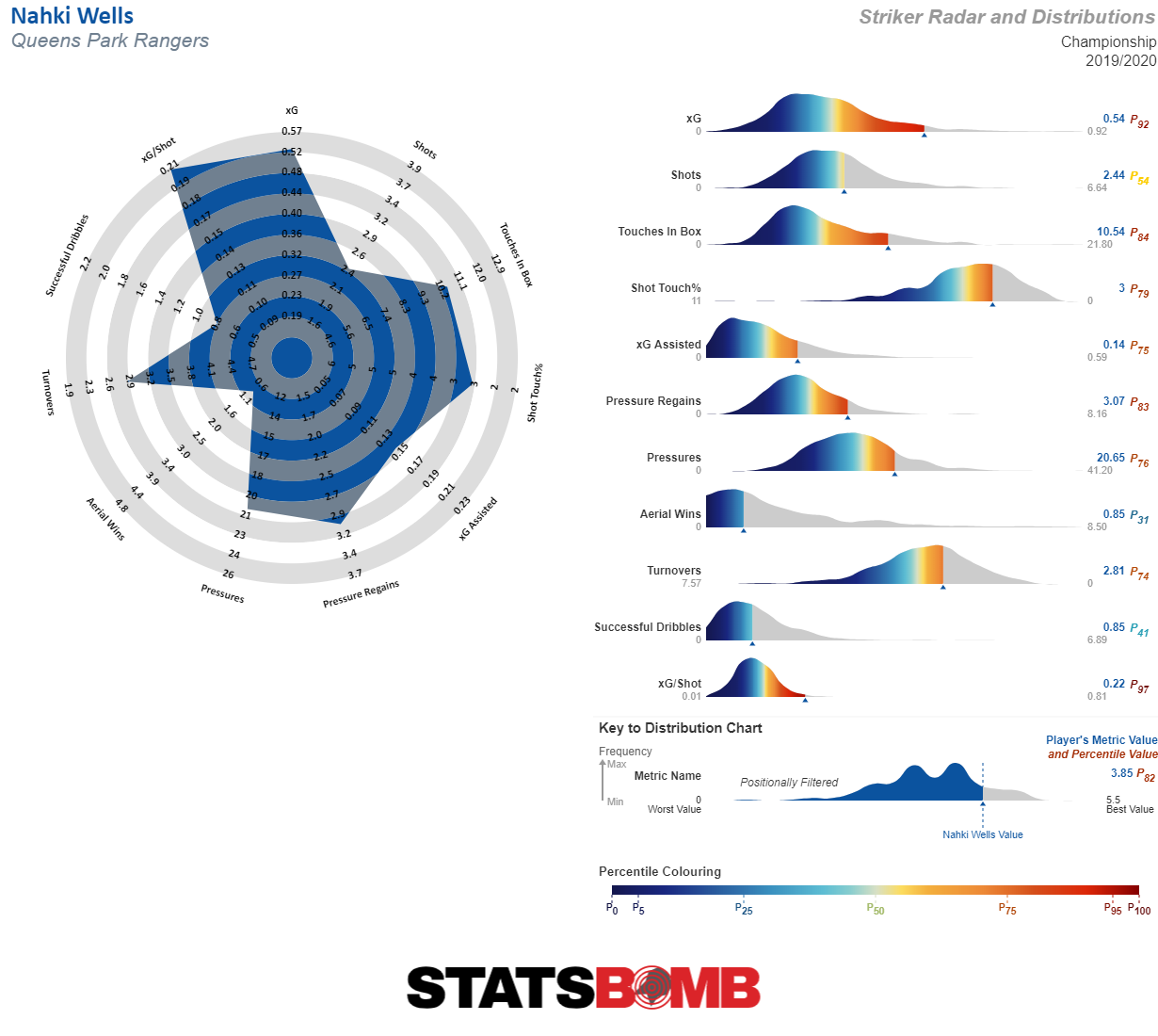 https://twitter.com/dgouilard/status/1224336891769524232 There’s been a pretty hefty decline in Preston’s results as the season’s progressed, and a couple of factors go a long way to explaining it. To start with, Preston’s season can pretty much be chopped in two: pre- and post-November 9th.
https://twitter.com/dgouilard/status/1224336891769524232 There’s been a pretty hefty decline in Preston’s results as the season’s progressed, and a couple of factors go a long way to explaining it. To start with, Preston’s season can pretty much be chopped in two: pre- and post-November 9th. 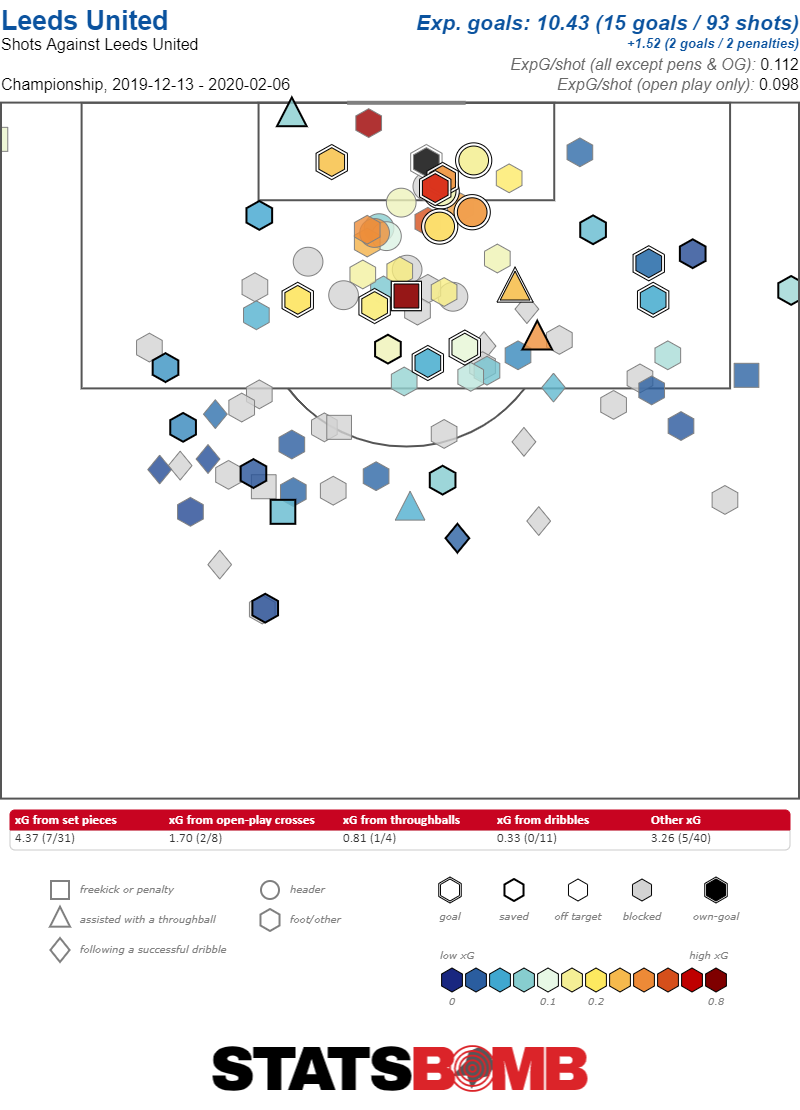 So we’re now faced with the double whammy of Leeds objectively performing worse defensively (albeit over a small sample of games) and Kiko Casilla having a slump in form between the sticks. Whether this continues largely depends on the reasons for the drop off. Have the players finally been exhausted by Marcelo Bielsa’s methods after 18 months at the helm, as some people suggest? Maybe? It could also be a simple wobble in performance. Whilst Leeds don’t look as daunting as they did earlier in the season, they still look promotion-contender levels of good. Whether their promotion bid is successful depends on whether the gradual decline in performances continues or whether the machine is just suffering a blip and resumes normal service in time. One wonders if Bielsa has tried turning his robots off and on again. https://twitter.com/analytic_footy/status/1224372797360820225 The trendline since the start of Bielsa’s reign certainly fuels the argument that Leeds are fudging xG somehow. Results have routinely struggled to keep up with performances.
So we’re now faced with the double whammy of Leeds objectively performing worse defensively (albeit over a small sample of games) and Kiko Casilla having a slump in form between the sticks. Whether this continues largely depends on the reasons for the drop off. Have the players finally been exhausted by Marcelo Bielsa’s methods after 18 months at the helm, as some people suggest? Maybe? It could also be a simple wobble in performance. Whilst Leeds don’t look as daunting as they did earlier in the season, they still look promotion-contender levels of good. Whether their promotion bid is successful depends on whether the gradual decline in performances continues or whether the machine is just suffering a blip and resumes normal service in time. One wonders if Bielsa has tried turning his robots off and on again. https://twitter.com/analytic_footy/status/1224372797360820225 The trendline since the start of Bielsa’s reign certainly fuels the argument that Leeds are fudging xG somehow. Results have routinely struggled to keep up with performances. 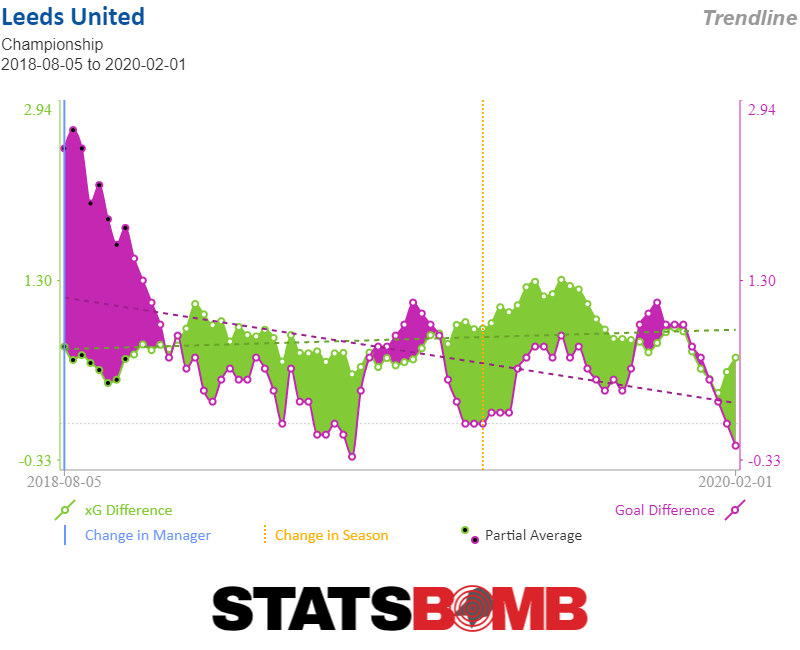 However, we’ve all seen the chances that Patrick Bamford and others have missed this season. The amount of ‘you simply have to score those’ chances that they've squandered is borderline comical. Which, for me, rules out any blind spots in the model. Bielsa’s system is lining these chances up for players, ‘tis the individual who is not finishing them. https://twitter.com/LukeSouthworth/status/1224330860905881601 To round things off I’ll answer with my underrated player because it’s easy. Ladies and gentlemen, Mathieu James Patrick Smith.
However, we’ve all seen the chances that Patrick Bamford and others have missed this season. The amount of ‘you simply have to score those’ chances that they've squandered is borderline comical. Which, for me, rules out any blind spots in the model. Bielsa’s system is lining these chances up for players, ‘tis the individual who is not finishing them. https://twitter.com/LukeSouthworth/status/1224330860905881601 To round things off I’ll answer with my underrated player because it’s easy. Ladies and gentlemen, Mathieu James Patrick Smith. 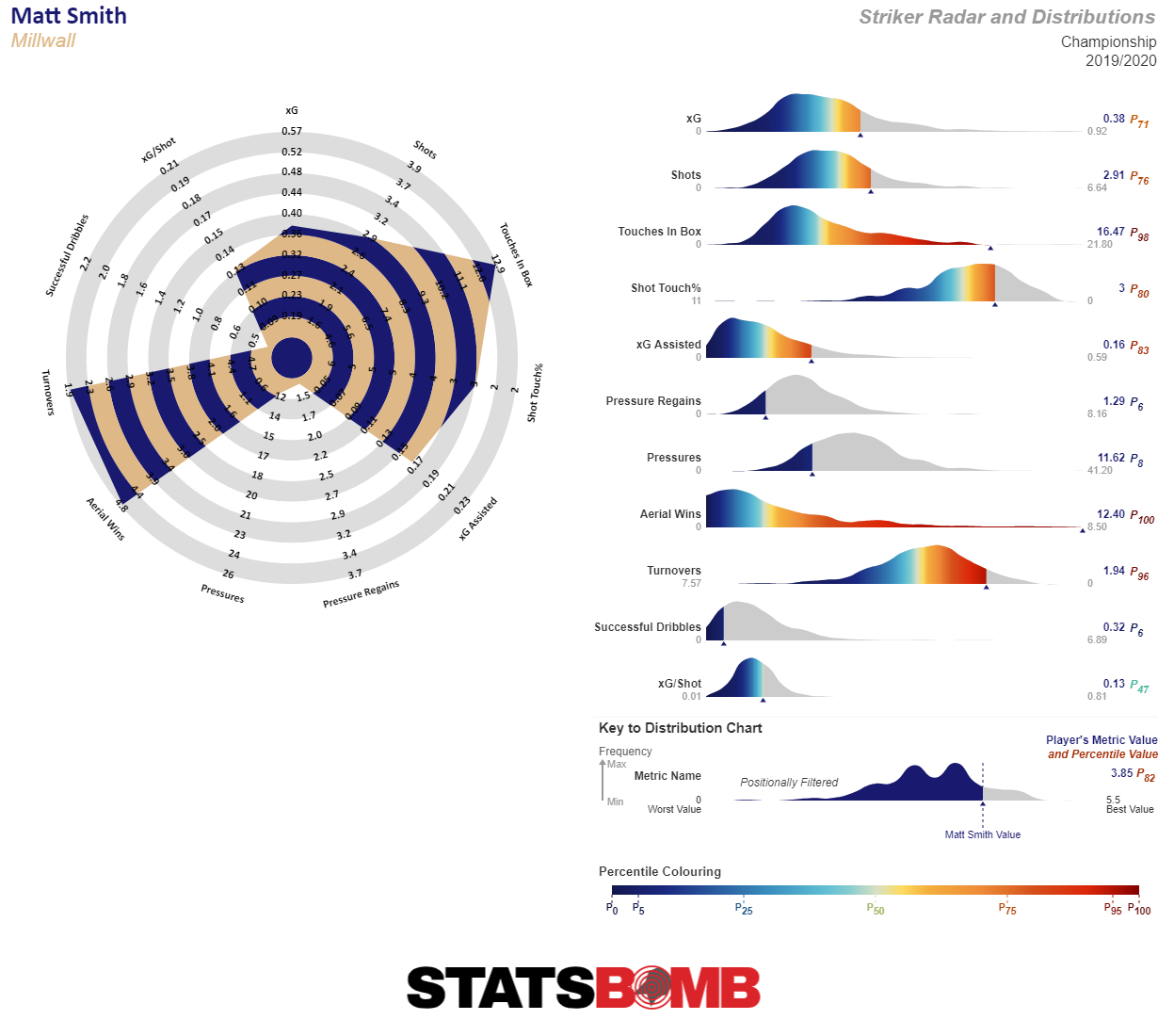 In the 100th percentile for aerial wins. The best Plan B in the league. Pure battering ram. Show me a defender who can consistently beat him in the air and I’ll show you a liar. Case closed. https://twitter.com/mixedknuts/status/1224336330747973632 We end with some health advice from the CEO because after all, your health is your wealth. 'Till next time, folks.
In the 100th percentile for aerial wins. The best Plan B in the league. Pure battering ram. Show me a defender who can consistently beat him in the air and I’ll show you a liar. Case closed. https://twitter.com/mixedknuts/status/1224336330747973632 We end with some health advice from the CEO because after all, your health is your wealth. 'Till next time, folks.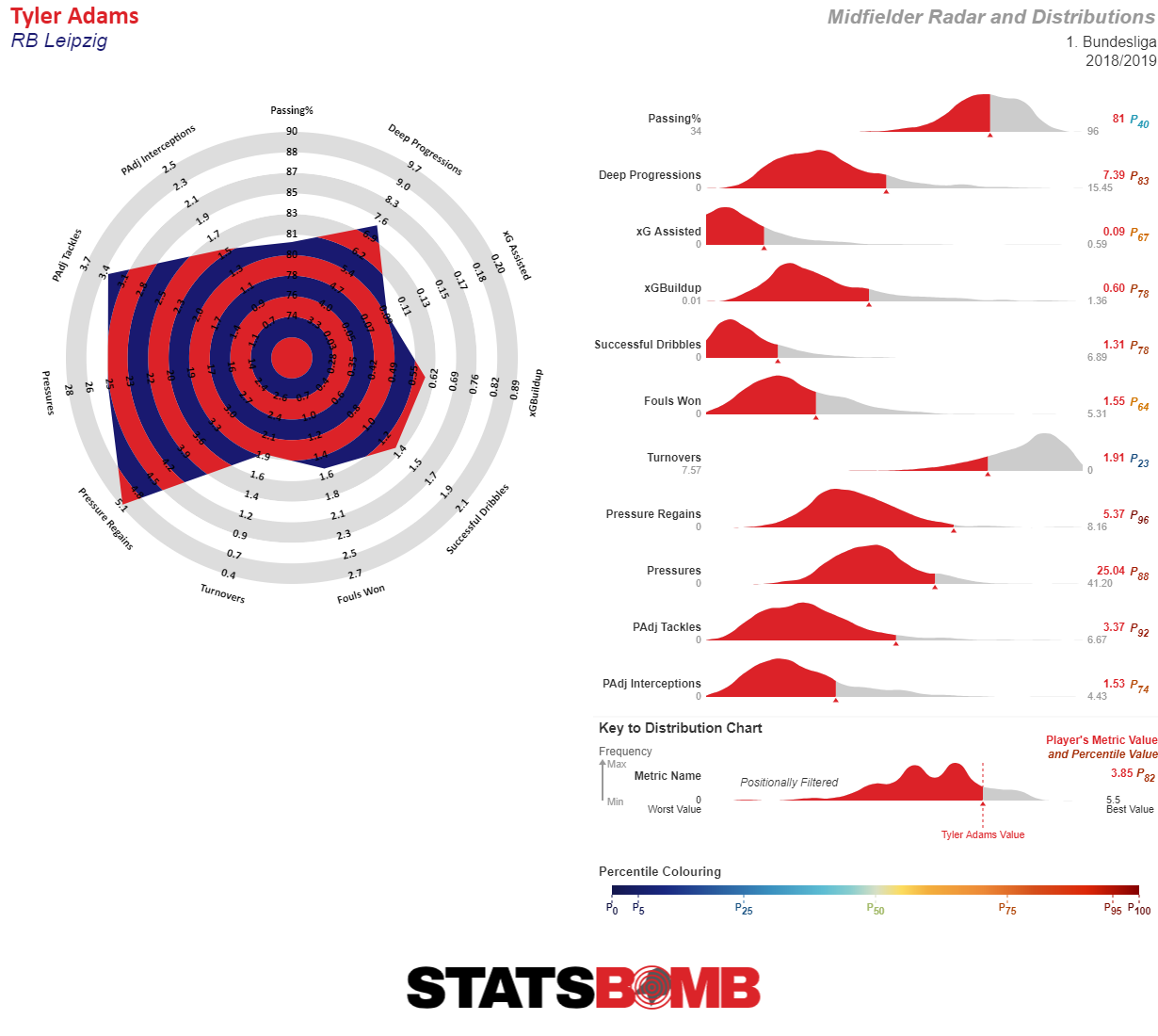
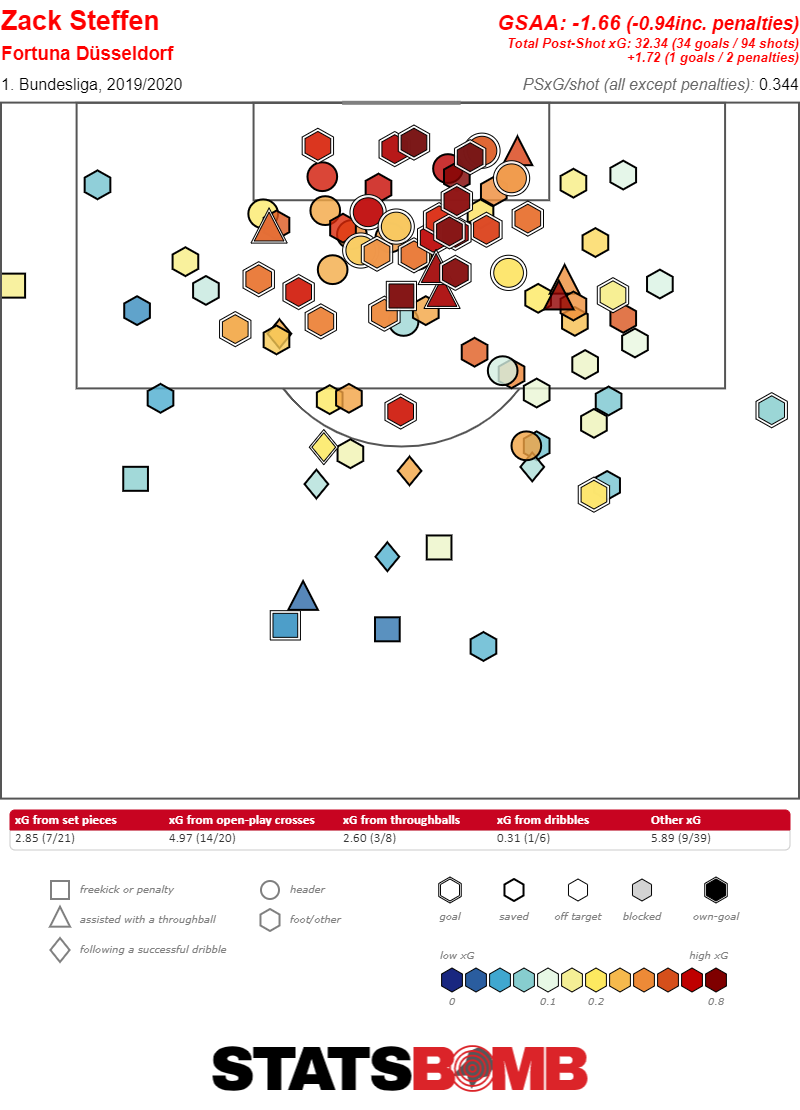
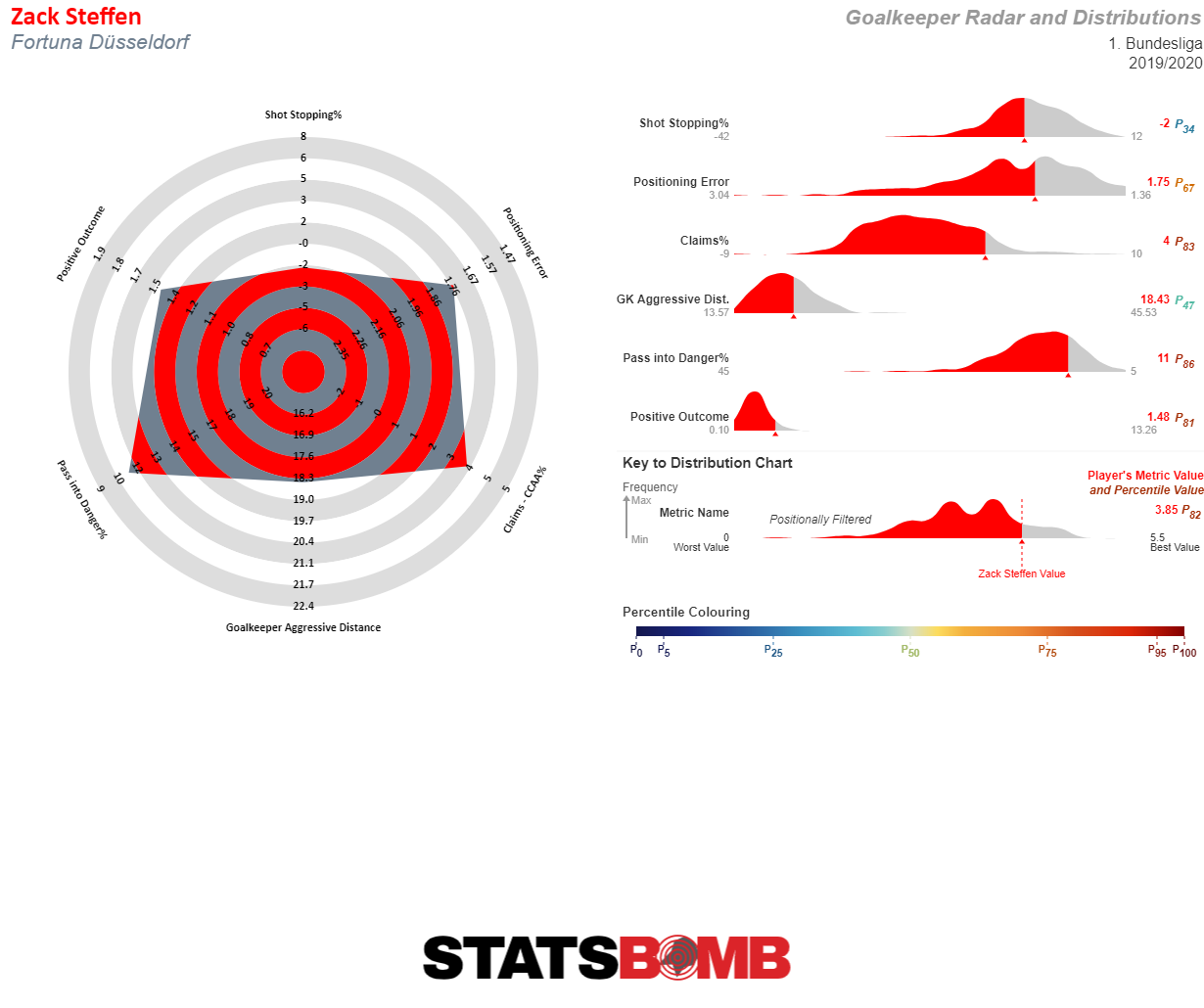
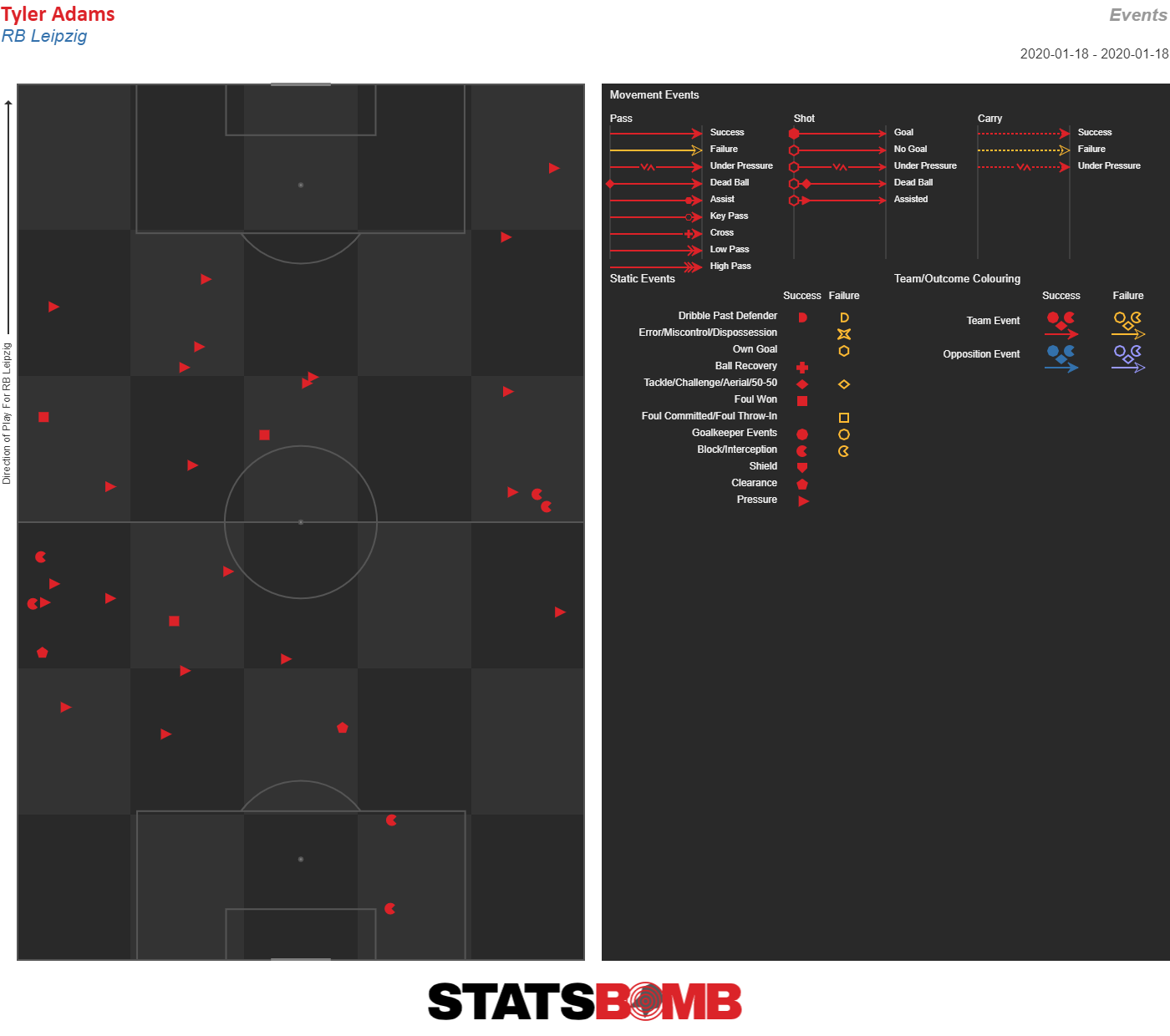
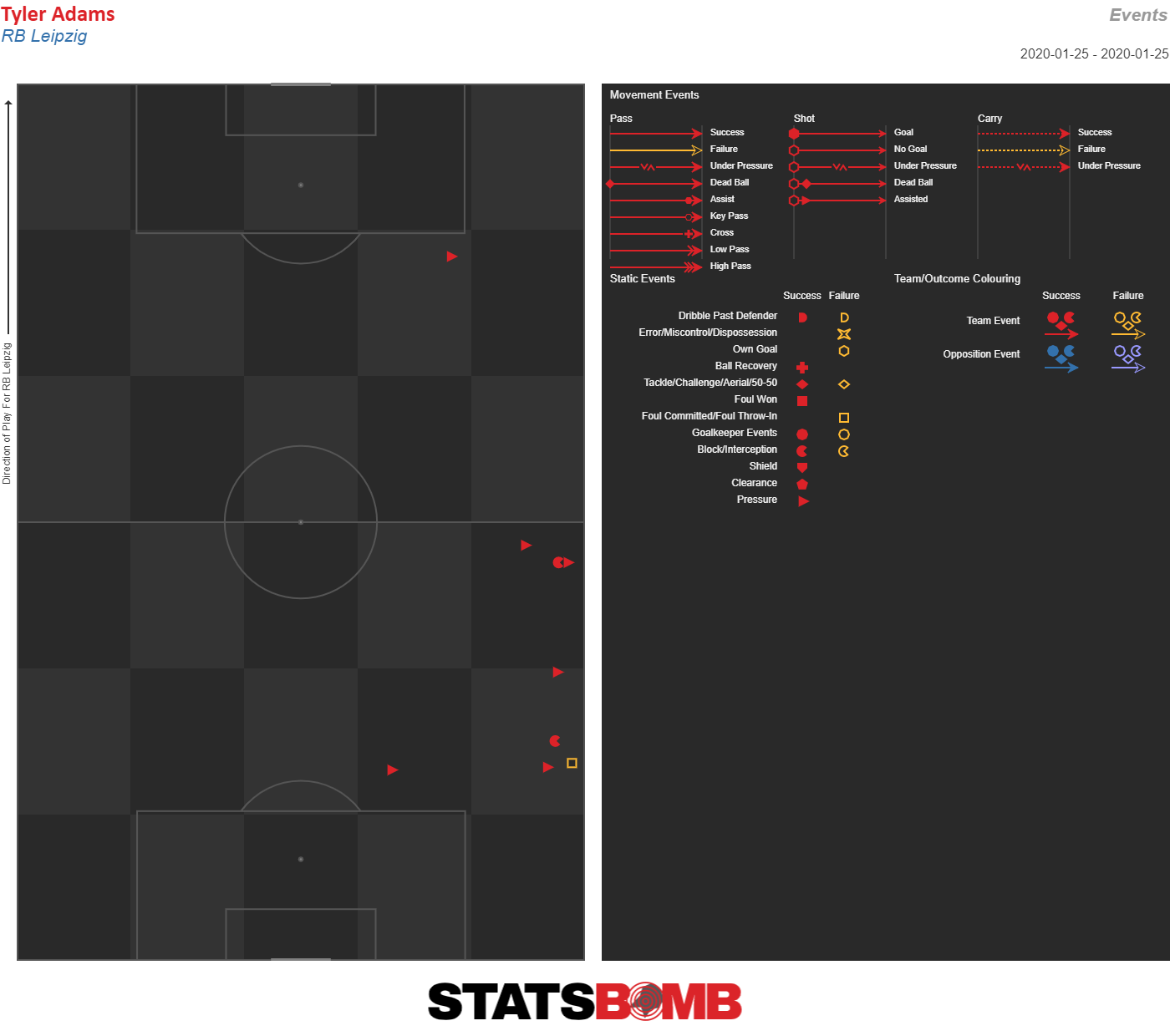
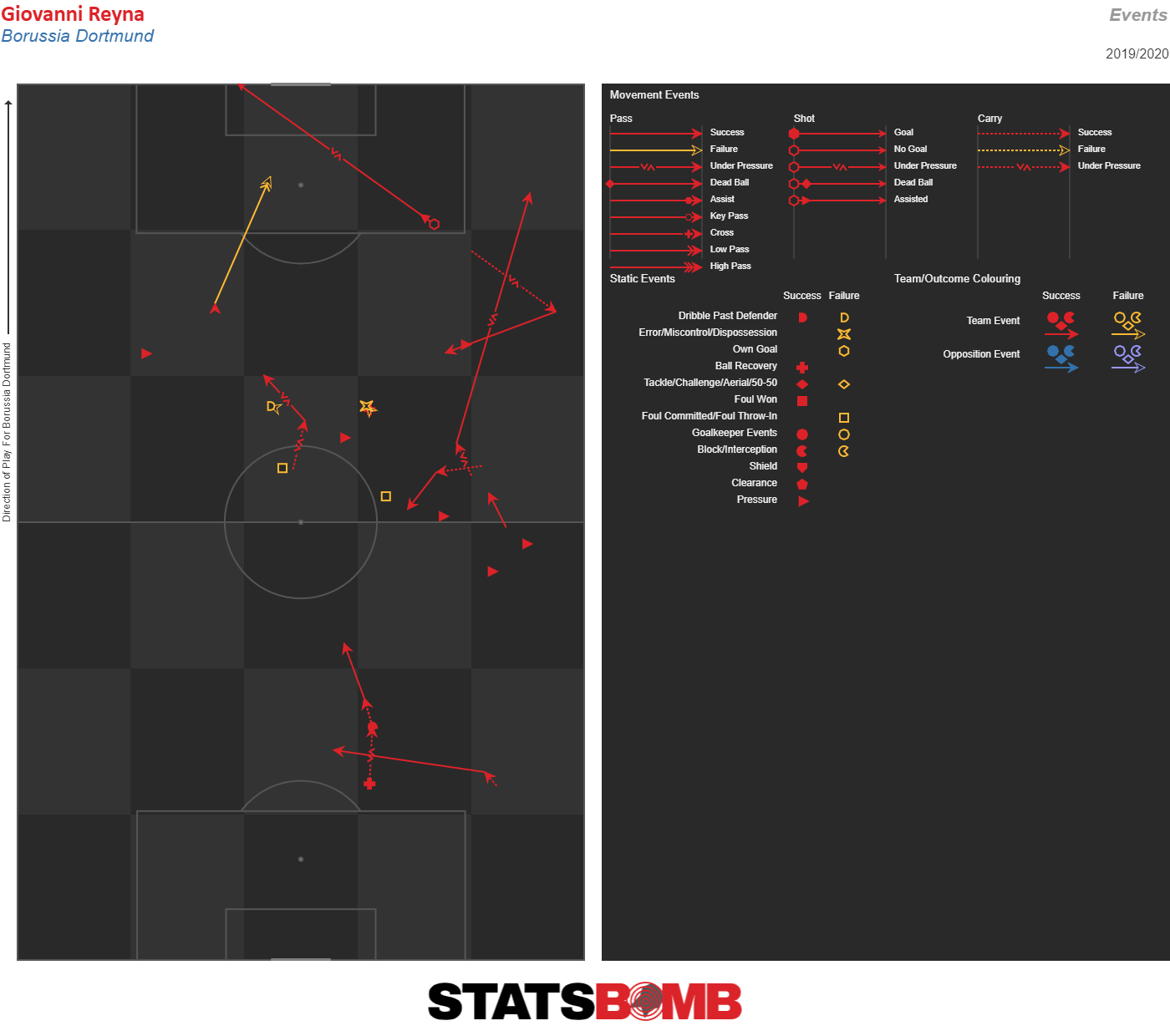
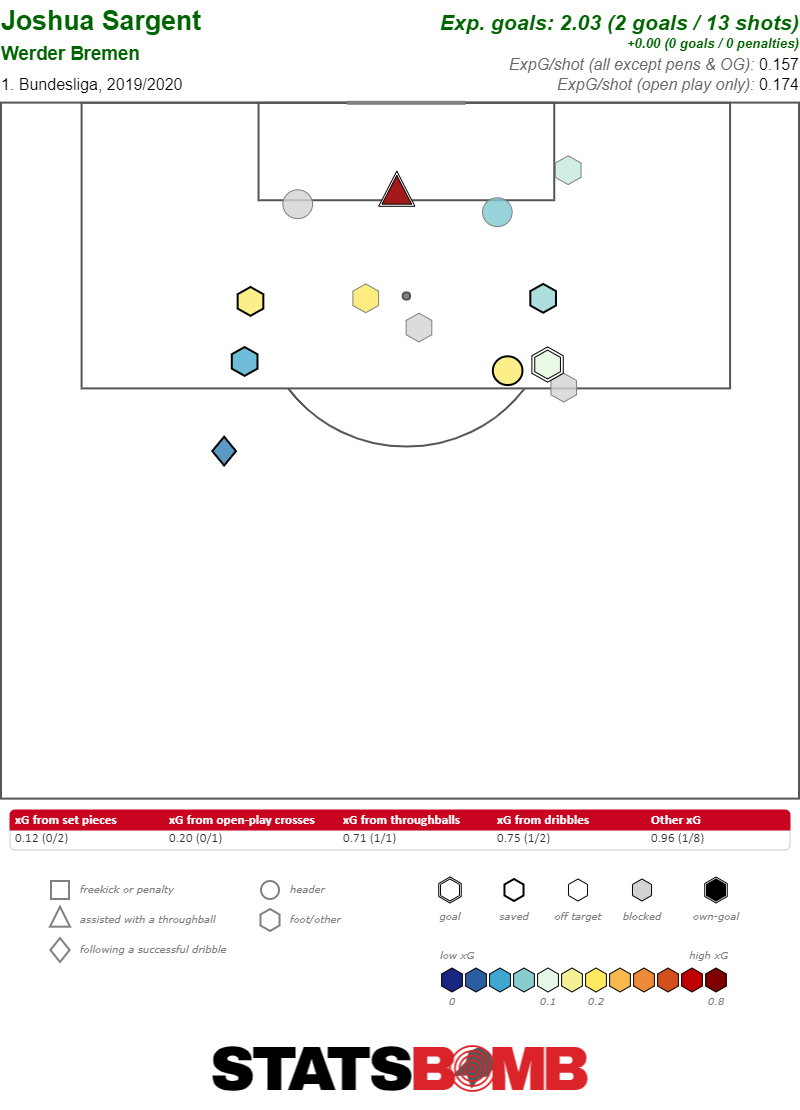
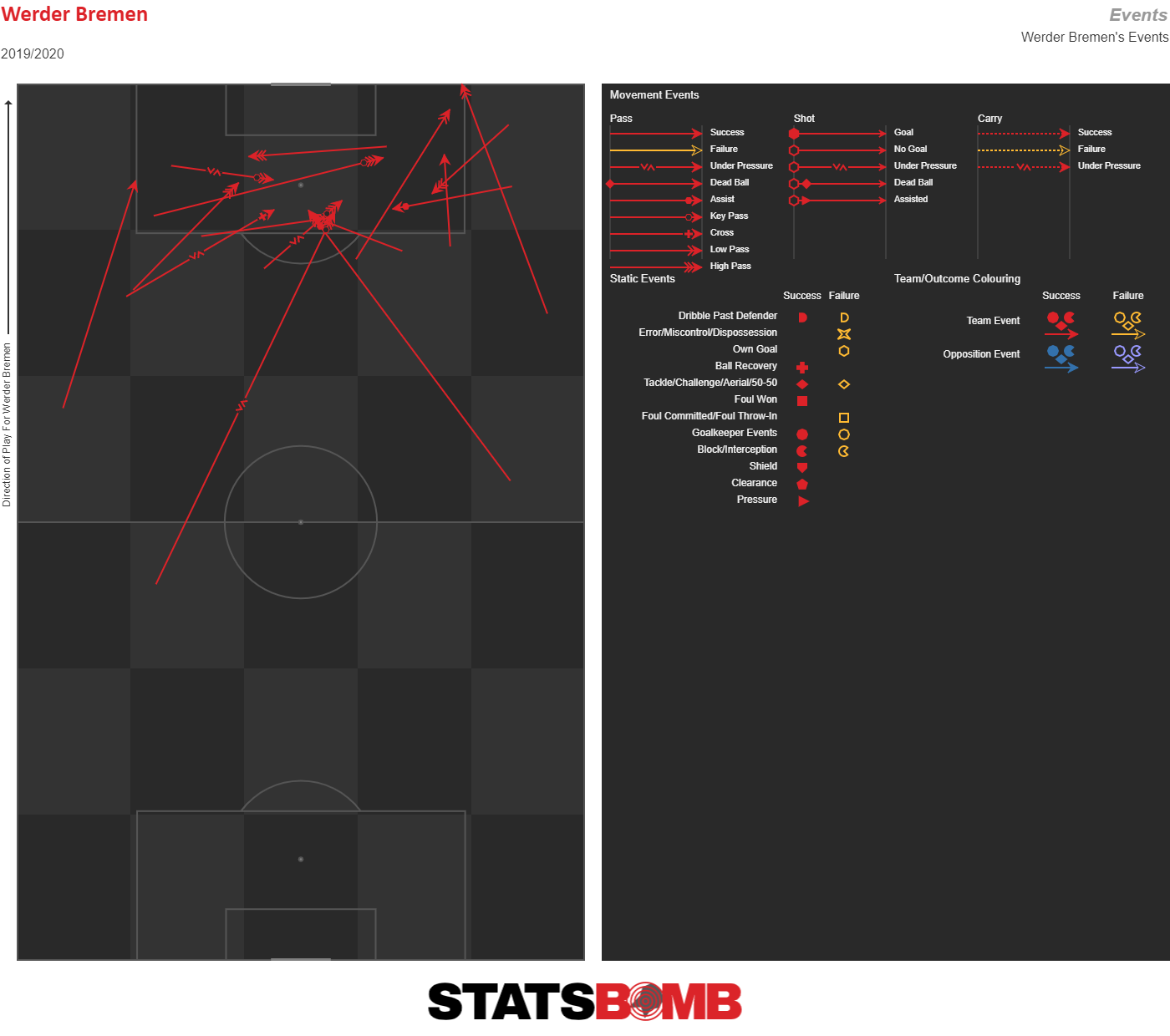
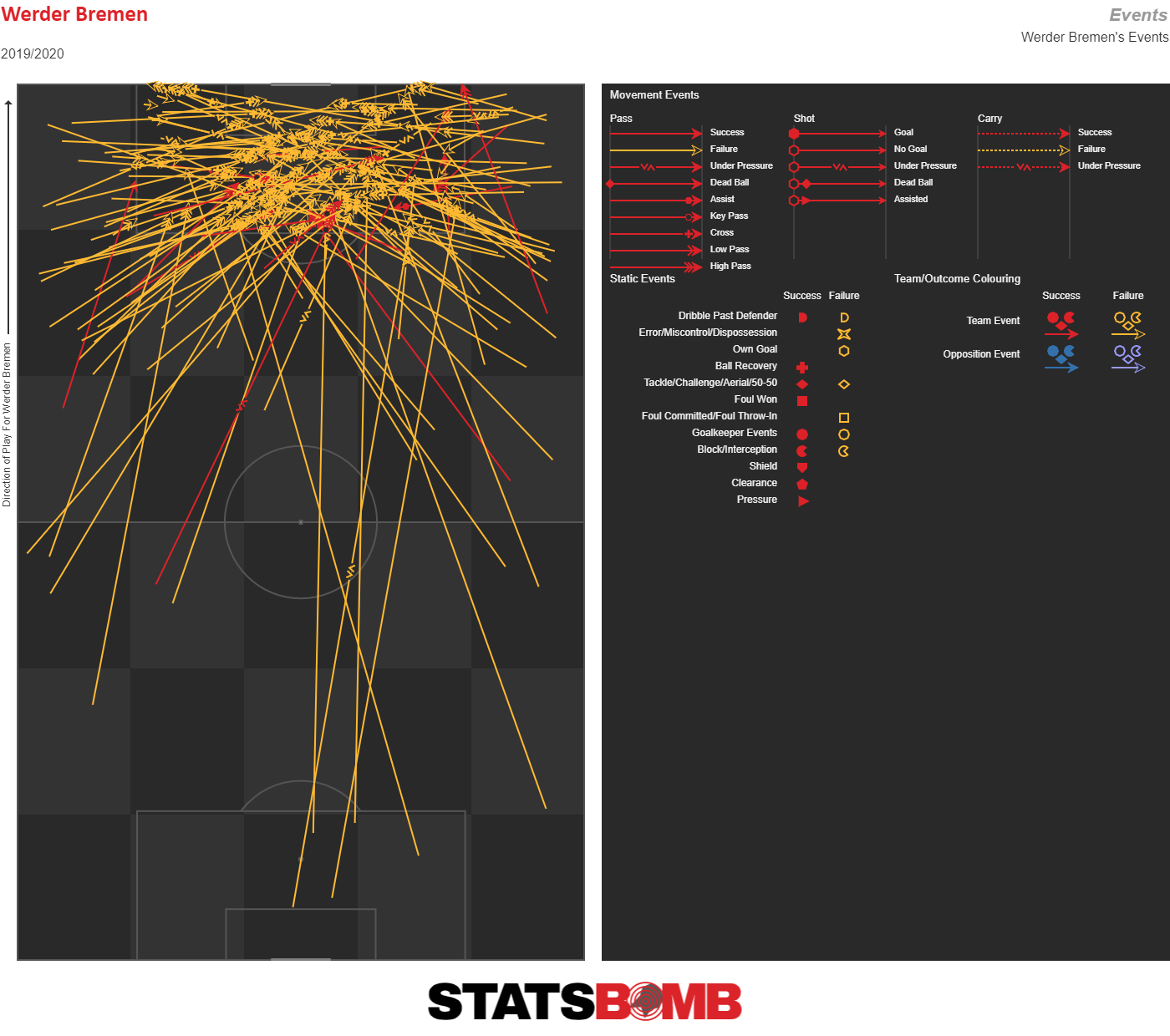
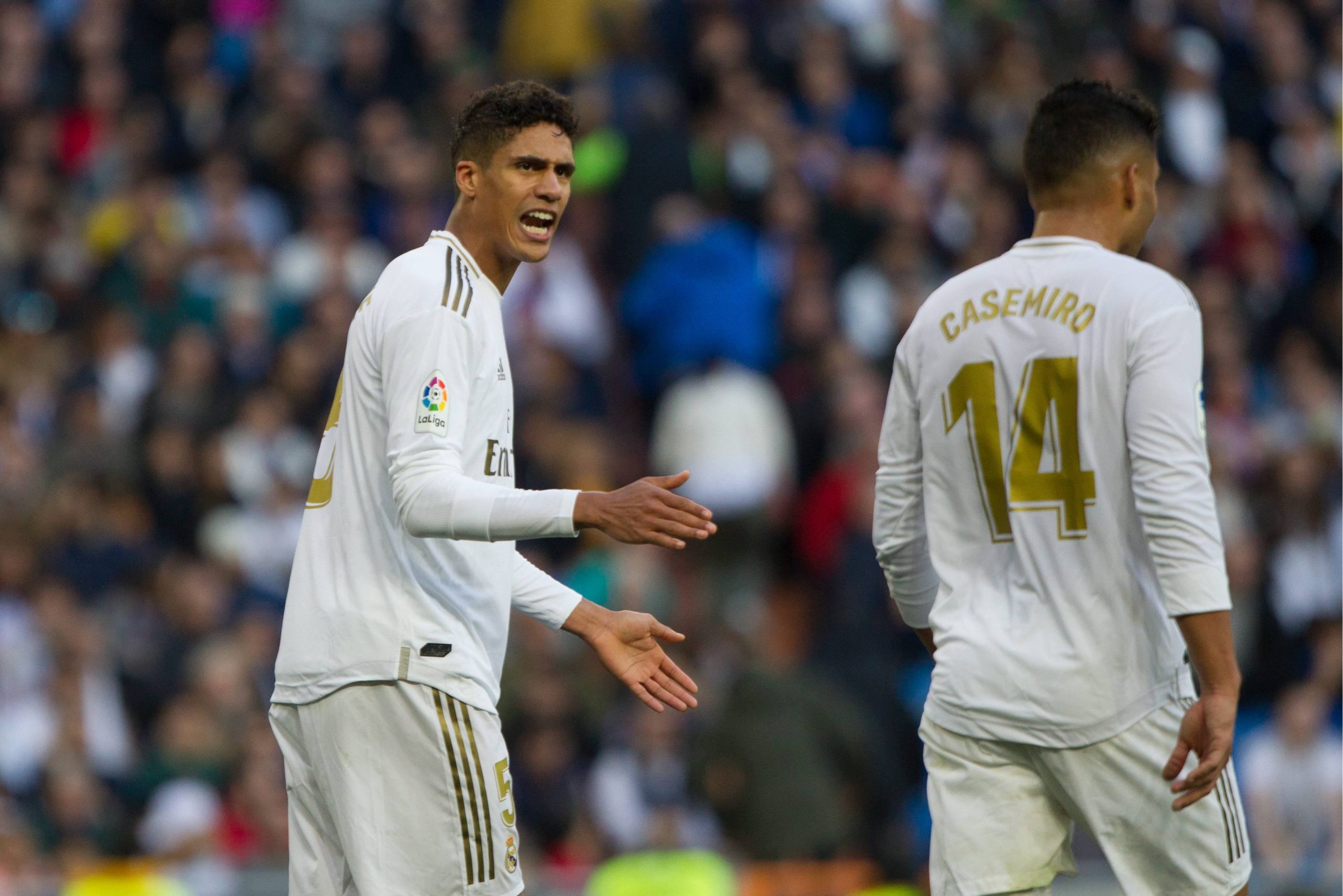
 Five of those shots came from set pieces, where Real Madrid lead the league.
Five of those shots came from set pieces, where Real Madrid lead the league. 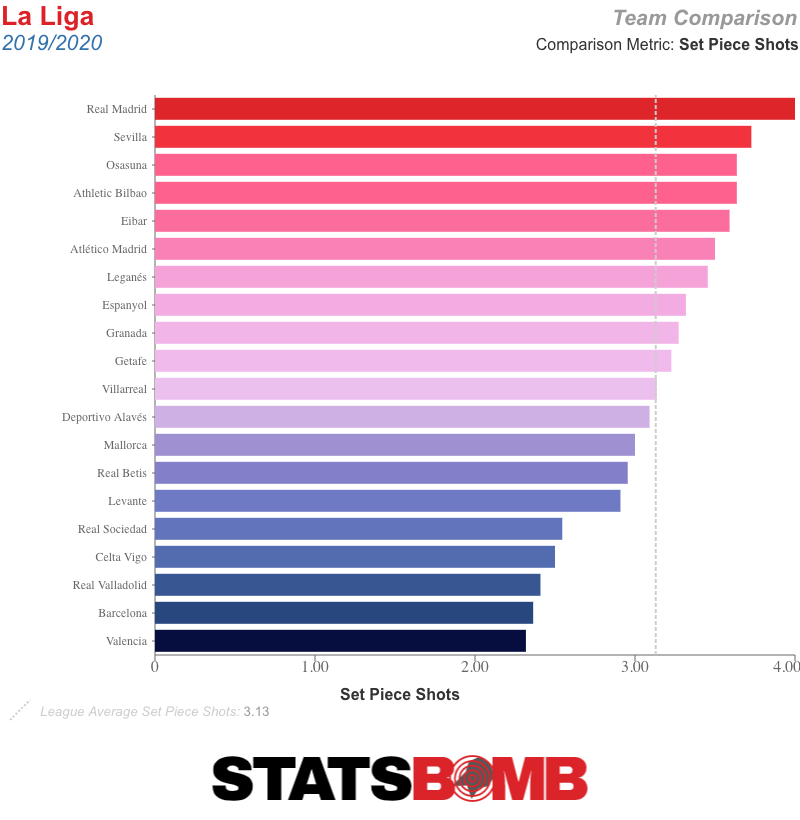 At the other end, they conceded just four shots for a tally of 0.20 xG. On average this season, only
At the other end, they conceded just four shots for a tally of 0.20 xG. On average this season, only 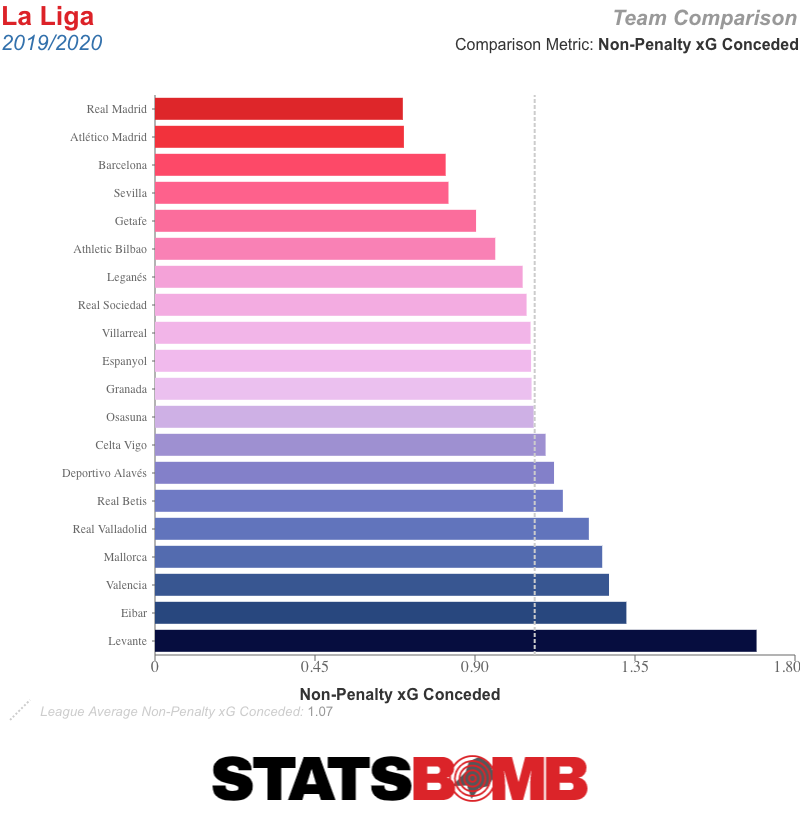 After what was, at least in their terms, a pretty disastrous campaign last time around, Zinedine Zidane has crafted a solid side capable of constricting their opponents and then piling on enough shots from crosses, set pieces and general play to more often than not get the goals they need to emerge victorious.
After what was, at least in their terms, a pretty disastrous campaign last time around, Zinedine Zidane has crafted a solid side capable of constricting their opponents and then piling on enough shots from crosses, set pieces and general play to more often than not get the goals they need to emerge victorious. 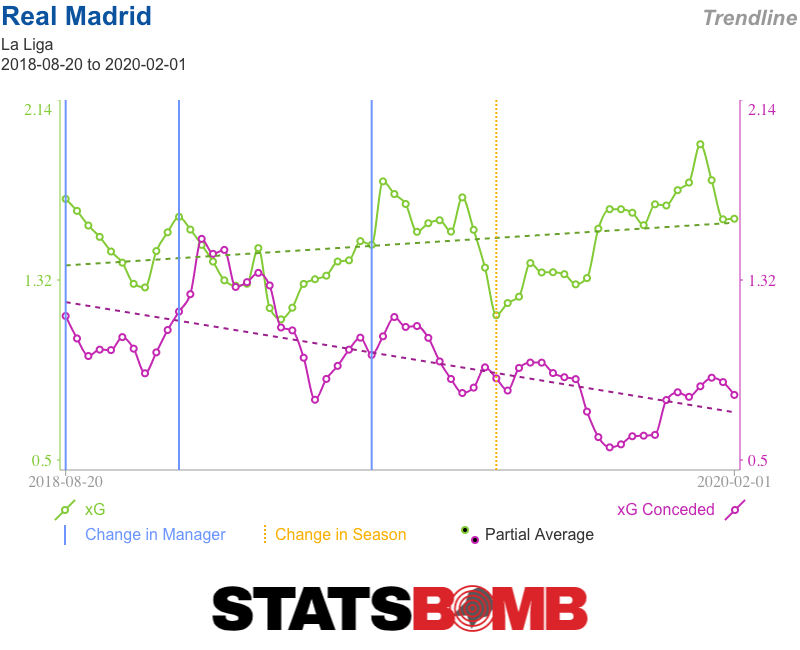 If Madrid continue to score at their current rate, they could reach 70 goals — better than last season, yet miles away from their average of over 100 goals per season over the previous five campaigns. But even if their concession rate slackens somewhat, this will still be their best defensive season since the late eighties, perhaps even further back than that. It’s a combination that may well be enough to see the league title return to the Bernabéu.
If Madrid continue to score at their current rate, they could reach 70 goals — better than last season, yet miles away from their average of over 100 goals per season over the previous five campaigns. But even if their concession rate slackens somewhat, this will still be their best defensive season since the late eighties, perhaps even further back than that. It’s a combination that may well be enough to see the league title return to the Bernabéu. 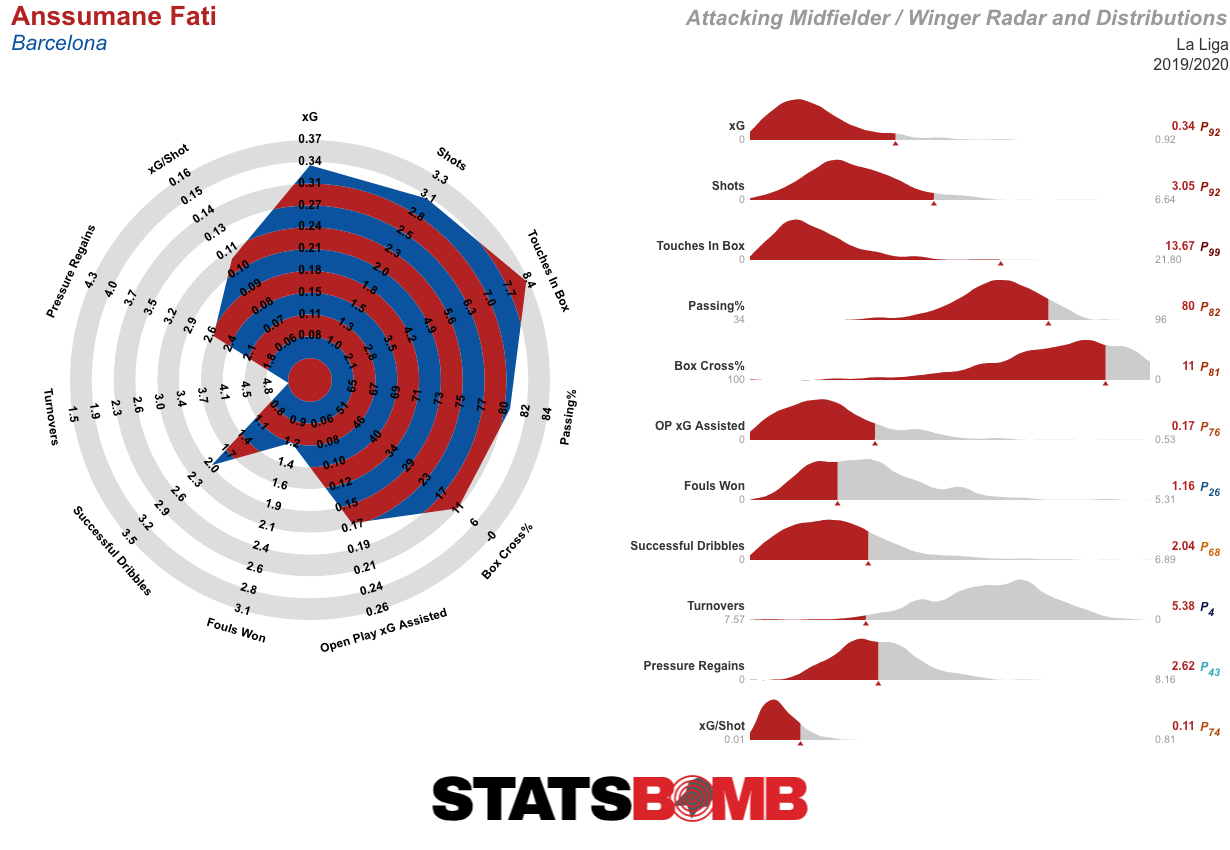 No one likes to put limits on young talents, especially ones who break through at one of the world’s biggest clubs at such a preternatural age, but two lingering questions remain: 1) Can he replicate that output over a larger sample size? Usually, a player needs to see at least 900 minutes of action before any sort of useful conclusions can be drawn about a player, and ideally more than that; and 2) How does he compare to other forwards who’ve broken through young at Barcelona? Does this kind of output necessarily precede superstardom? Thanks to our
No one likes to put limits on young talents, especially ones who break through at one of the world’s biggest clubs at such a preternatural age, but two lingering questions remain: 1) Can he replicate that output over a larger sample size? Usually, a player needs to see at least 900 minutes of action before any sort of useful conclusions can be drawn about a player, and ideally more than that; and 2) How does he compare to other forwards who’ve broken through young at Barcelona? Does this kind of output necessarily precede superstardom? Thanks to our 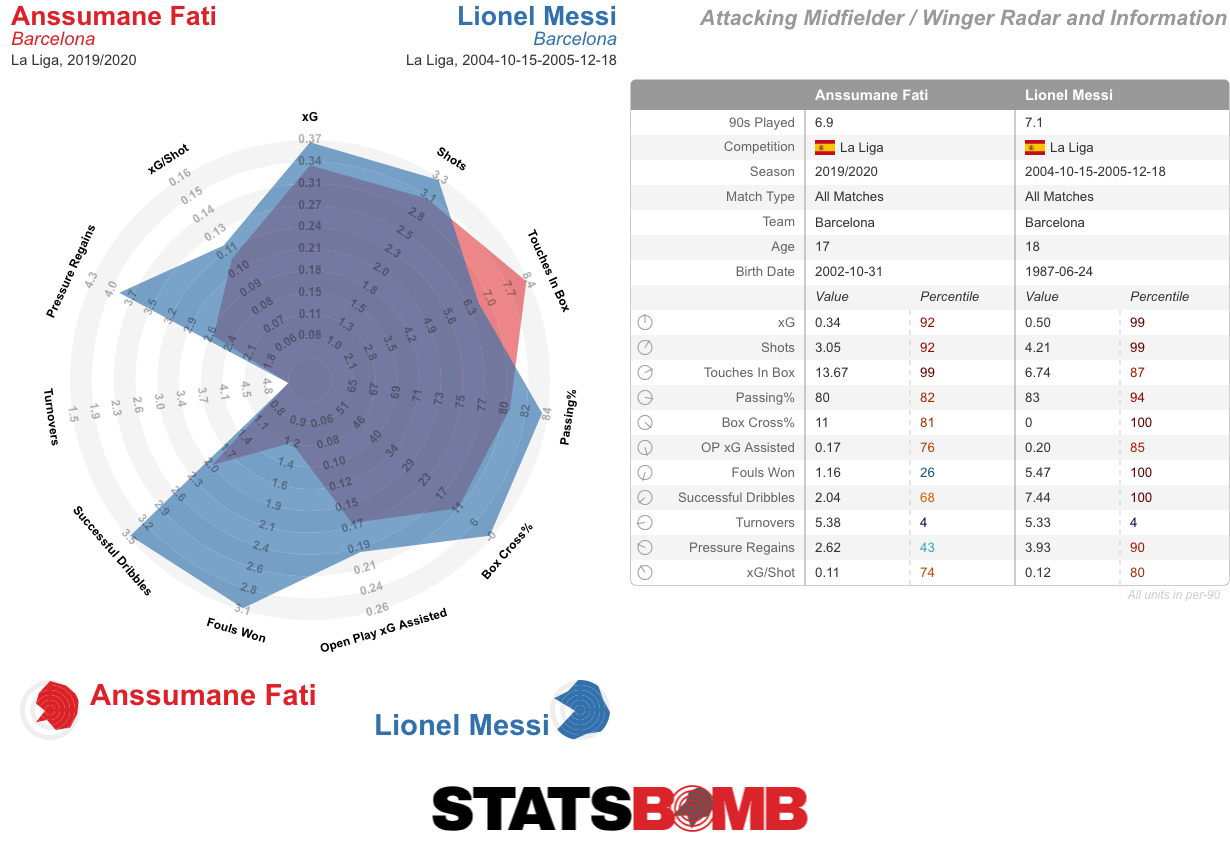 That’s probably an unfair comparison for anyone. Messi’s output was
That’s probably an unfair comparison for anyone. Messi’s output was 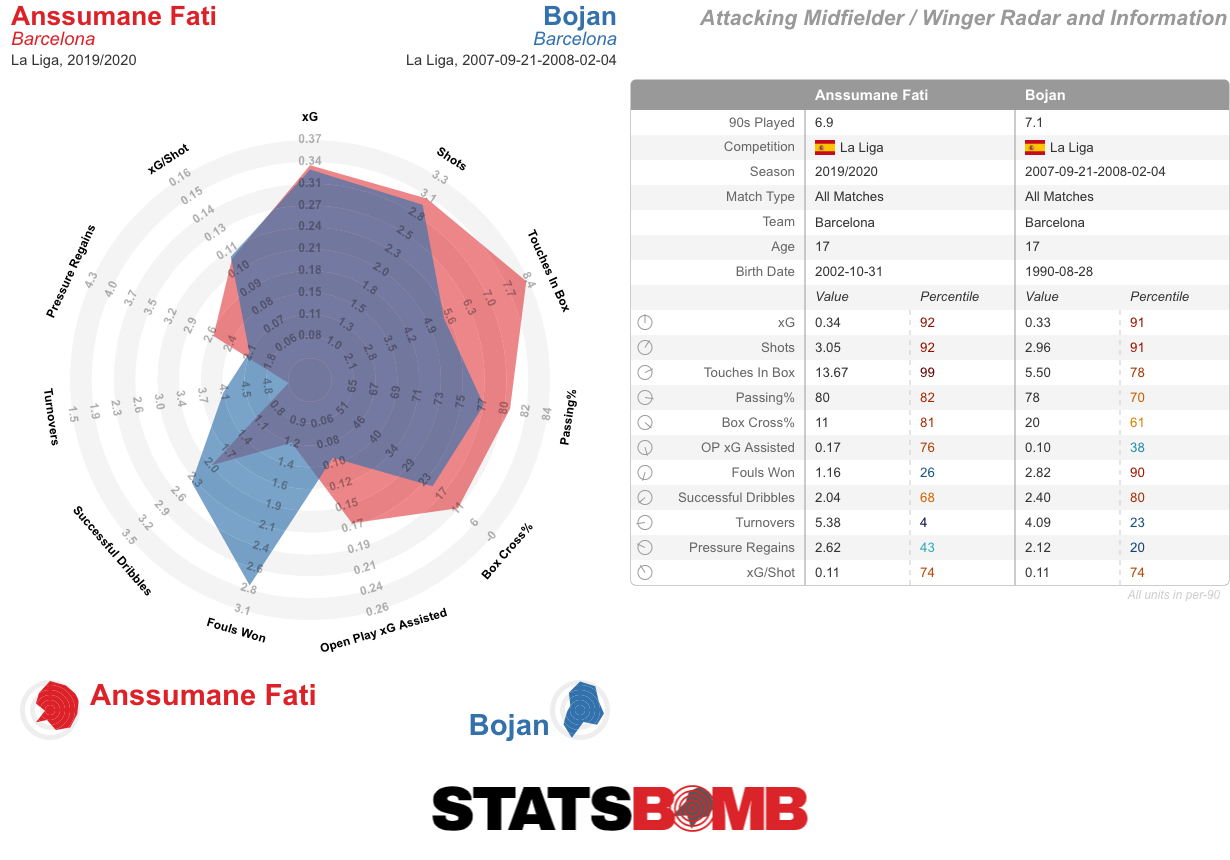 Fati just about prevails, but it’s close. Finally, we have Munir. He scored on his debut as an 18-year-old near the end of August 2014 and was a Spain international just a couple of weeks later — his one and only cap.
Fati just about prevails, but it’s close. Finally, we have Munir. He scored on his debut as an 18-year-old near the end of August 2014 and was a Spain international just a couple of weeks later — his one and only cap. 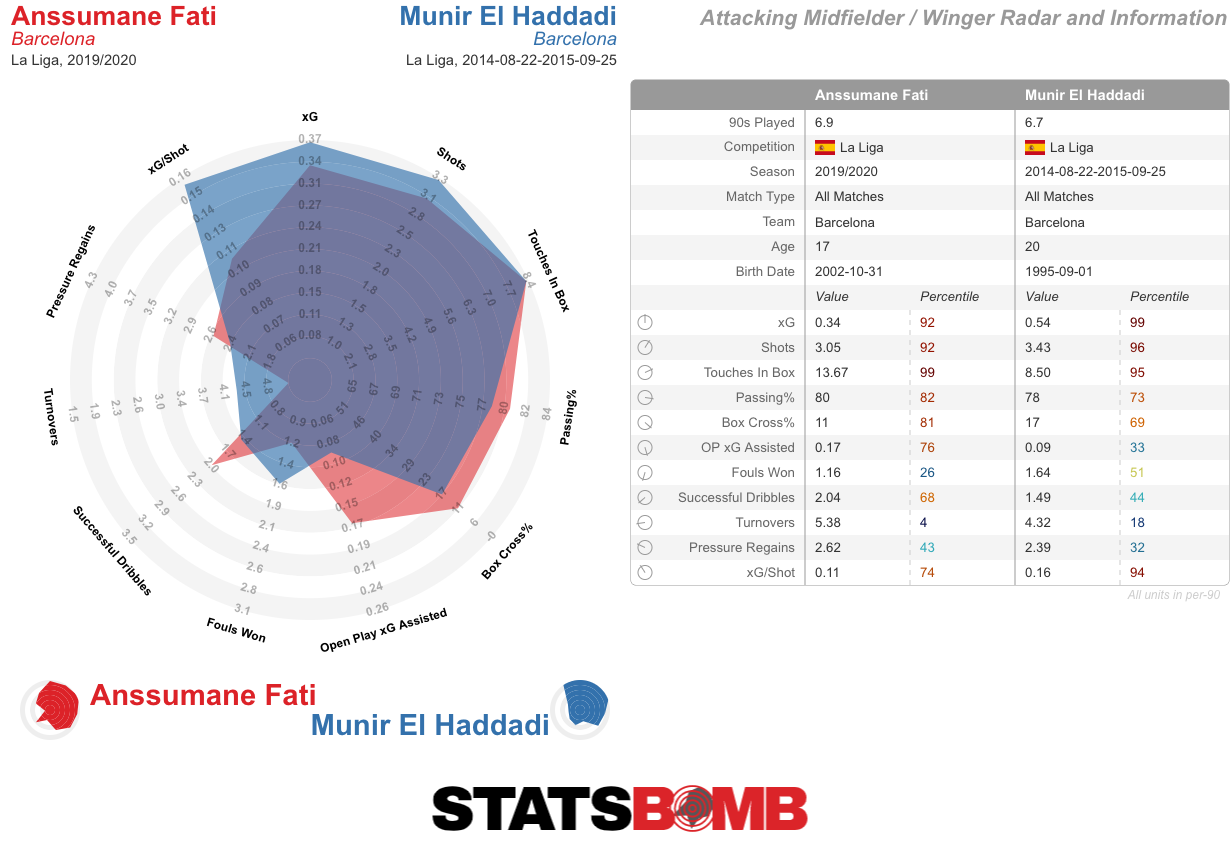 This one is pretty much a tie: better shooting output from Munir; better creative output from Fati. These quick and dirty comparisons serve to provide some context as to what Fati might go on to achieve from here. Superstar, rotational forward in a top-four chasing side or playing in MLS before age 30 — it feels like all of those outcomes are still in play.
This one is pretty much a tie: better shooting output from Munir; better creative output from Fati. These quick and dirty comparisons serve to provide some context as to what Fati might go on to achieve from here. Superstar, rotational forward in a top-four chasing side or playing in MLS before age 30 — it feels like all of those outcomes are still in play.  It wasn’t the first time he’s done that this season. It was his 3rd free-kick goal from 10 attempts, and he also struck the woodwork against Valencia.
It wasn’t the first time he’s done that this season. It was his 3rd free-kick goal from 10 attempts, and he also struck the woodwork against Valencia.  So do we have a new free-kick maestro on our hands? The truth is there's no way to tell at this stage. The sample size is far too small. However, a goal scored in every three or so free-kicks is an insanely high scoring rate. Smooth it out with last season’s data, when he failed to score in 10 attempts, and the Rodríguez scores a goal in every 6.67 free-kicks, which is still quite high. Messi is one of the few players for whom there's enough data to say with a degree of confidence that he is a skilled set-piece shooter, and even he averages less than one goal in 10 free kicks over the course of his career. Over smaller sample sizes, we can see all manner of misleading hot streaks. Enis Bardhi is the go-to example in La Liga. In the 2017–18 season, he scored five goals from 16 direct free-kicks — barely less than one goal for every three he took.
So do we have a new free-kick maestro on our hands? The truth is there's no way to tell at this stage. The sample size is far too small. However, a goal scored in every three or so free-kicks is an insanely high scoring rate. Smooth it out with last season’s data, when he failed to score in 10 attempts, and the Rodríguez scores a goal in every 6.67 free-kicks, which is still quite high. Messi is one of the few players for whom there's enough data to say with a degree of confidence that he is a skilled set-piece shooter, and even he averages less than one goal in 10 free kicks over the course of his career. Over smaller sample sizes, we can see all manner of misleading hot streaks. Enis Bardhi is the go-to example in La Liga. In the 2017–18 season, he scored five goals from 16 direct free-kicks — barely less than one goal for every three he took. 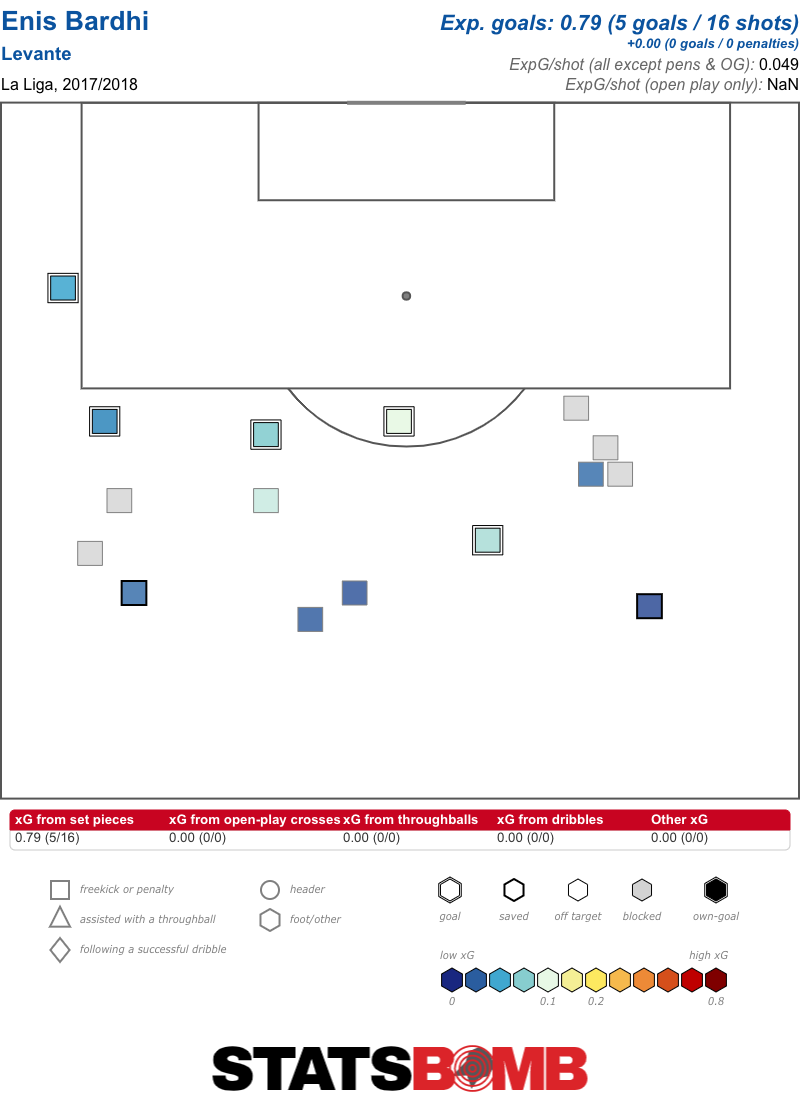 In reality, that conversion rate was never going to be sustainable. But what was, in effect, a statistical aberration was widely treated as evidence of supreme ability. Bardhi was hailed as a challenger to Messi’s crown as Europe’s best at free-kicks. Fast forward a season and a half, and the folly of that argument is evident. From his subsequent 26 shots from direct free-kicks, he has scored just once.
In reality, that conversion rate was never going to be sustainable. But what was, in effect, a statistical aberration was widely treated as evidence of supreme ability. Bardhi was hailed as a challenger to Messi’s crown as Europe’s best at free-kicks. Fast forward a season and a half, and the folly of that argument is evident. From his subsequent 26 shots from direct free-kicks, he has scored just once. 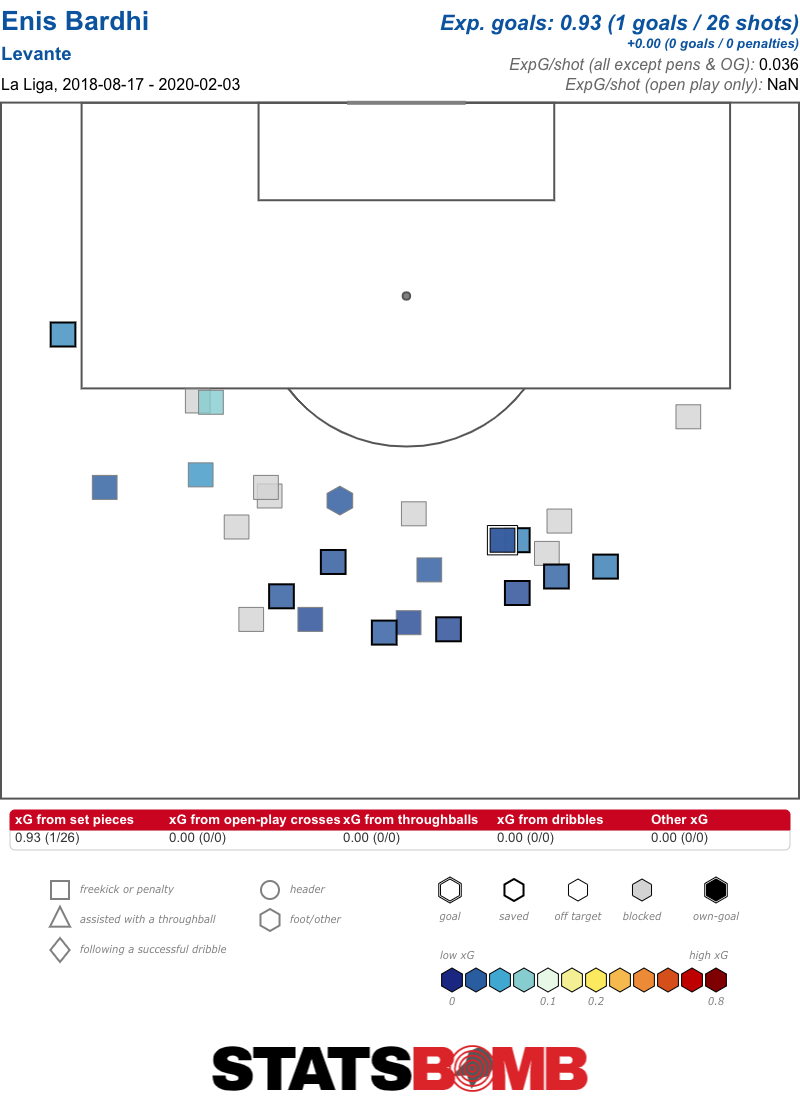 Bardhi still has an impressive but slightly more realistic hit-rate of a goal for every seven direct free-kicks he has attempted in La Liga. He is probably an above-average taker, but the evidence still only amounts to less than 50 shots. Messi has maintained an impressive rate over more than 350. Rodríguez has a long way to go to match either of them.
Bardhi still has an impressive but slightly more realistic hit-rate of a goal for every seven direct free-kicks he has attempted in La Liga. He is probably an above-average taker, but the evidence still only amounts to less than 50 shots. Messi has maintained an impressive rate over more than 350. Rodríguez has a long way to go to match either of them. 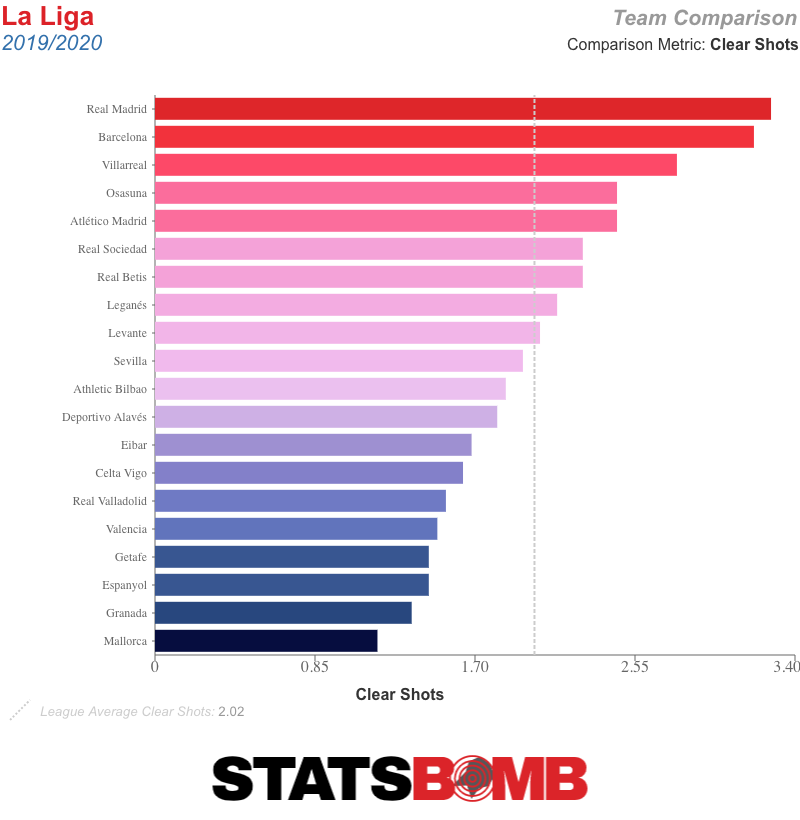 They’ve got pace in behind, and plenty of good passers. Even the two central defenders Raúl Albiol and Pau Torres — both in the top three in the league in terms of completed long balls — sometimes
They’ve got pace in behind, and plenty of good passers. Even the two central defenders Raúl Albiol and Pau Torres — both in the top three in the league in terms of completed long balls — sometimes 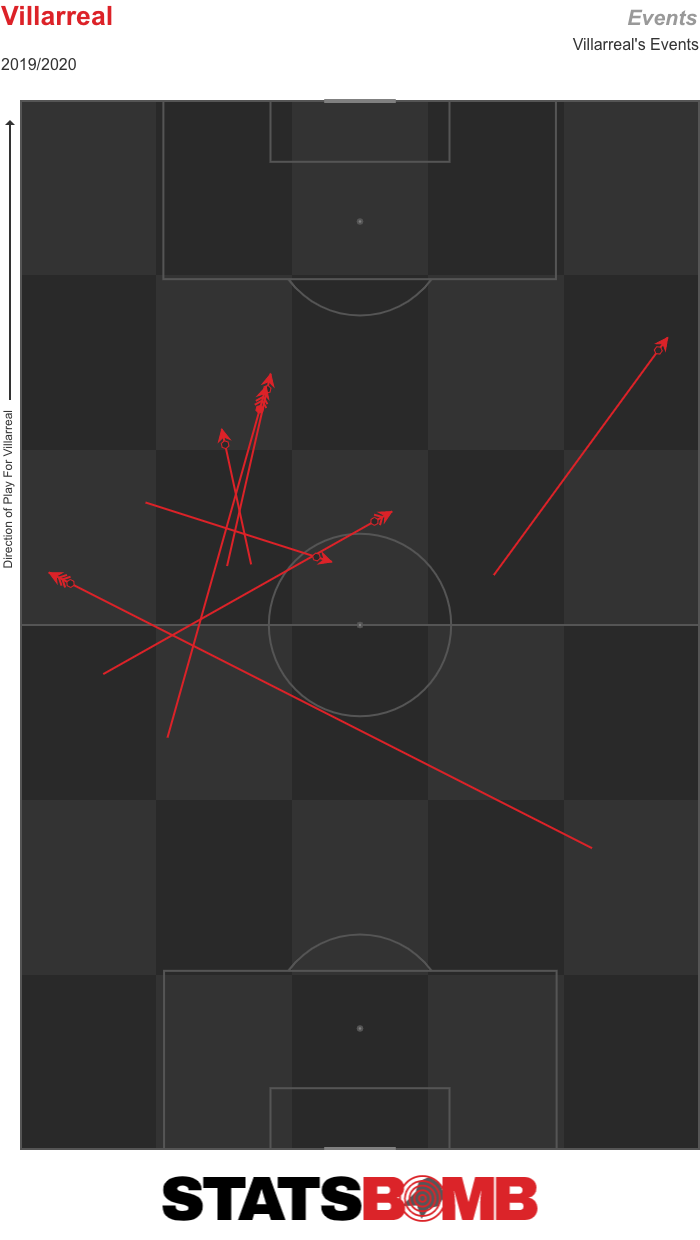 It is an environment in which a player with Alcácer’s smarts can be expected to thrive. Header image courtesy of the Press Association
It is an environment in which a player with Alcácer’s smarts can be expected to thrive. Header image courtesy of the Press Association